Have you ever tried Filipino food? I’m not surprised if you haven’t because for one reason or another, Filipino cuisine hasn’t caught on internationally as much as other Asian cuisines like Japanese, Korean, Vietnamese, or Thai.
So what exactly is Filipino food? Visitors trying the food in the Philippines for the first time may find it similar to Spanish food. Some will pick up on the strong Chinese influences while others will recognize localized versions of American fast food like Filipino-style burgers, hot dogs, and fried chicken.
Because of the country’s colonial history, Filipino food has evolved into a melting pot of eastern and western influences, so much so that some writers have described it as “Asian fusion before Asian fusion even existed”.
If you’re visiting the Philippines and looking to really dig into the cuisine, then I hope this list of 45 popular Filipino dishes leads you to some fantastic meals. If you’re planning on cooking Filipino food at home, then you’ll find a link to a recipe under almost every dish. Kain na!
Save This on Pinterest!
No time to read this guide on the best food in the Philippines? Click on the save button and pin it for later!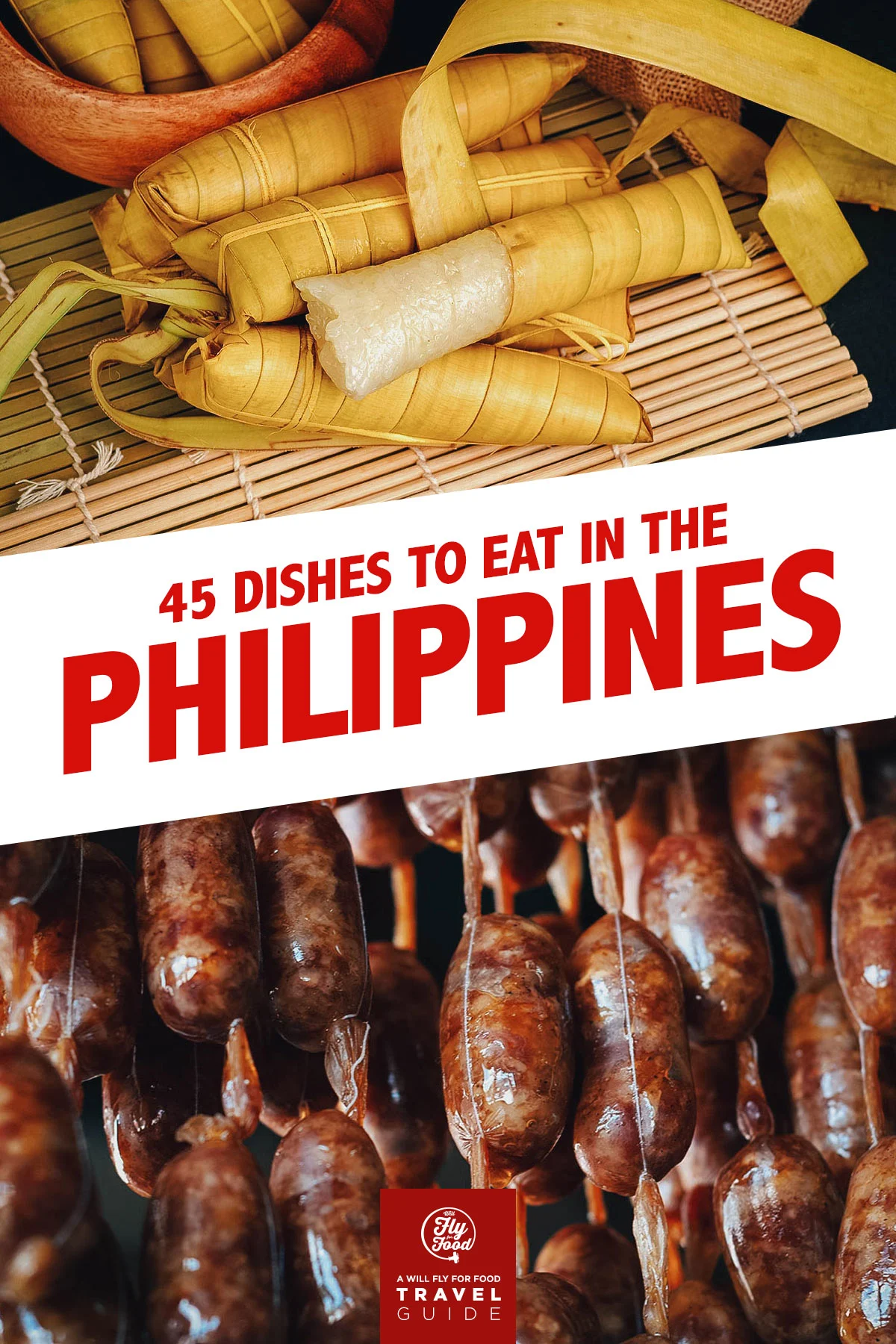
Photo by nifty50gallery and hendraxu
WHAT IS TRADITIONAL FILIPINO FOOD?
Filipino food is characterized by the combination of three flavors – sweet, sour, and salty. Compared to other Southeast Asian countries, spices and heat don’t figure as prominently in traditional Filipino cuisine. Garlic, ginger, bay leaves, and black pepper are most often used while spicy food is common only in two regions – Bicol and Muslim Mindanao.
What makes Filipino food interesting is its mix of different influences. It’s similar to Indonesian and Malaysian food thanks to its Austronesian origins and has been shaped by centuries of migration and colonialism to become the multi-faceted cuisine that it is today.
Because of the Chinese diaspora, Filipino food is heavily influenced by Chinese cuisine, mainly by immigrants from the Fujian region of China and the Cantonese. It was also significantly influenced by the country’s colonizers, like Spain who ruled the Philippines for 333 years and the Americans who controlled the country for nearly half a century.
To a lesser extent, Filipino food was also influenced by Japanese, Indian, and Mexican cuisines. Japan occupied the Philippines from 1942 till 1945 while Indian influences made their way into Filipino cuisine by way of Indian sepoys brought by the British during a 2-year occupation.
This isn’t as well-documented so it was interesting to learn how Mexican cuisine influenced Filipino food. Because of Mexico’s ties to the Spanish empire, different fruits, vegetables, and ingredients were brought in via the galleon trade. Many of the first settlers to the Philippines were in fact Spaniards who were already established and living in Mexico.
Aside from the foreign influences that helped shape Filipino cuisine, it’s also important to note that traditional Filipino food is a reflection of its archipelagic makeup. Like Indonesian food, Filipino cuisine is highly local and regional. There exist hundreds if not thousands of regional dishes, along with common dishes that can be found throughout the country, sometimes with names and preparations that vary from region to region.
THE BEST FILIPINO DISHES
A list of 45 dishes can be difficult to digest so I’ve organized this Filipino food guide by category to make it easier to go through. Click on a link to jump to any section of the guide.
STARTERS / SIDES
1. Chicharon
In many Spanish-speaking parts of the world, chicharon refers to a snack made with deep-fried pork rinds. In the Philippines, it refers to that too but it can also refer to other similarly deep-fried dishes usually made with either pork or chicken.
Some of the most common examples of chicharon in the Philippines include chicharon bituka, which refers to pork intestines that have been chopped up into bite-sized pieces and deep-fried. Chicharon manok or chicken skin chicharon refers to deep-fried chicken skin. It’s technically a type of chicharon though most Filipinos refer to it simply as “chicken skin”.
It’s hard not to like anything crunchy and deep-fried but my absolute favorite type of chicharon is chicharon bulaklak (pictured below). It refers to a type of chicharon made with pork mesentery. The mesentery is the thin, web-like membrane that supports the small intestine. When the mesentery is detached, it forms a frill or ruffle-like ornament resembling a flower. Chicharon bulaklak literally means “flower chicharon”.
Chicken skin and chicharon bulaklak are my favorites but deep-fried pork rinds are definitely the most popular and readily available type of chicharon in the Philippines. If you say “chicharon”, people will assume that you’re asking for deep-fried pork rinds. They usually come in two varieties – with fat and without fat. Chicharon with fat tastes so much better but it’s also a lot more sinful.
No matter the type, chicharon in the Philippines is usually served with vinegar to help cut the fat and give it a nice sour kick. It’s often enjoyed as a snack or as a bar chow dish with beer.
RECIPE: Chicharon bulaklak
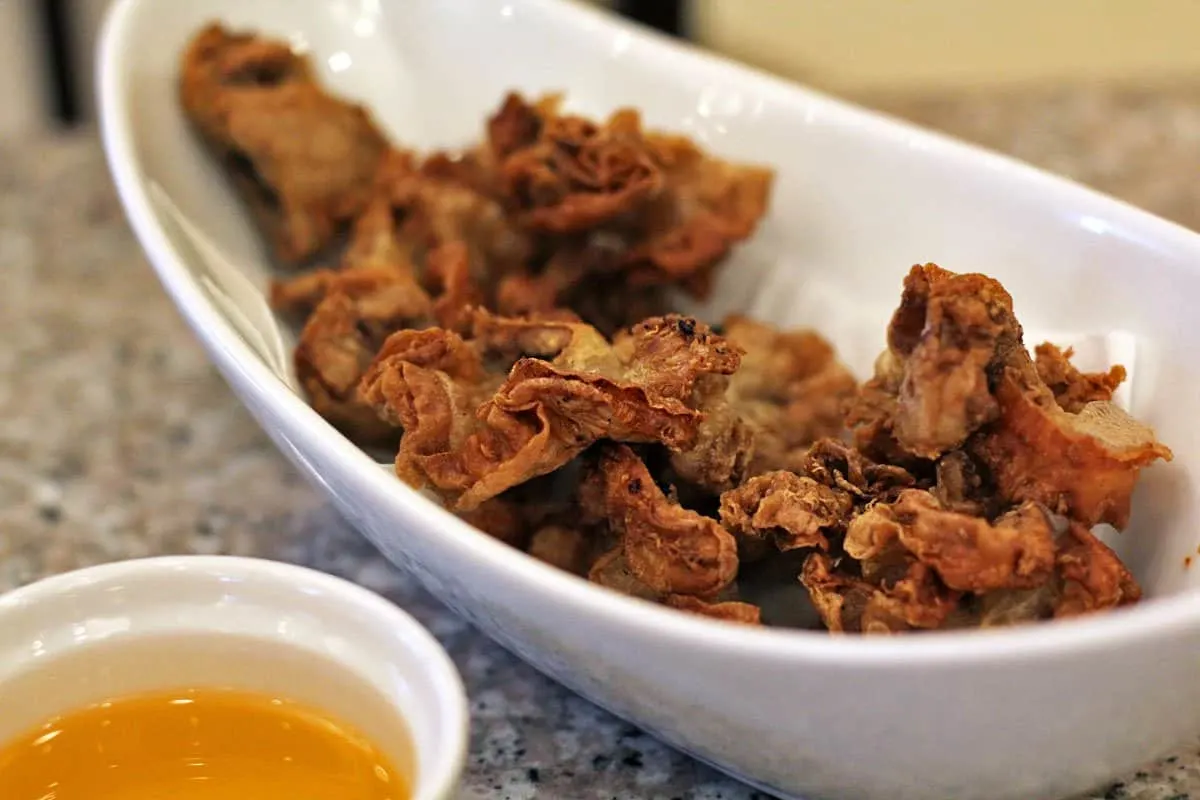
2. Pork Sisig
If you had to try just one dish in the Philippines, one dish to represent Filipino cuisine, the I’d probably tell you to try pork sisig. It’s a hugely popular bar chow dish made with chopped pork face, ears, and chicken liver served on a cast iron sizzling plate.
Sisig is originally from Pampanga province which is the (unoffiial) culinary capital of the Philippines, but it’s become ubiquitous throughout the Philippines. It was invented by Aling Lucing’s restaurant in Angeles City around the mid-1970s when a surplus of discarded pig’s heads from a former US air base gave her the idea for the dish.
To prepare, the pig’s head is boiled, broiled, and then grilled before being chopped up and seasoned with vinegar and calamansi juice. It’s served with chopped onions and chicken liver on a sizzling cast iron plate to keep the fat from going cold and turning into lard.
Sisig is traditionally made with pork though you can find other versions these days made with other proteins like tuna, squid, mussel, or oyster. You can even find more exotic versions made with crocodile or ostrich but pork sisig is still the best and the one you should try.
Recipes vary from place to place so it isn’t uncommon to find sisig made with things like mayonnaise, raw egg, ox brain, and chicharon bits. It’s usually consumed as a shared appetizer or bar chow dish but personally, I like to eat it as an entree with white or garlic fried rice. It’s so good.
Pampanga is considered the sisig capital of the Philippines so in my opinion, it’s still the best place to try it. The original Aling Lucing’s restaurant is still in business but you can find excellent sisig anywhere in the Philippines. If you’re visiting Manila, then I suggest trying it at the Trellis restaurant. It’s owned by a prominent Kapampangan culinary family credited for popularizing sisig in Manila.
RECIPE: Pork sisig
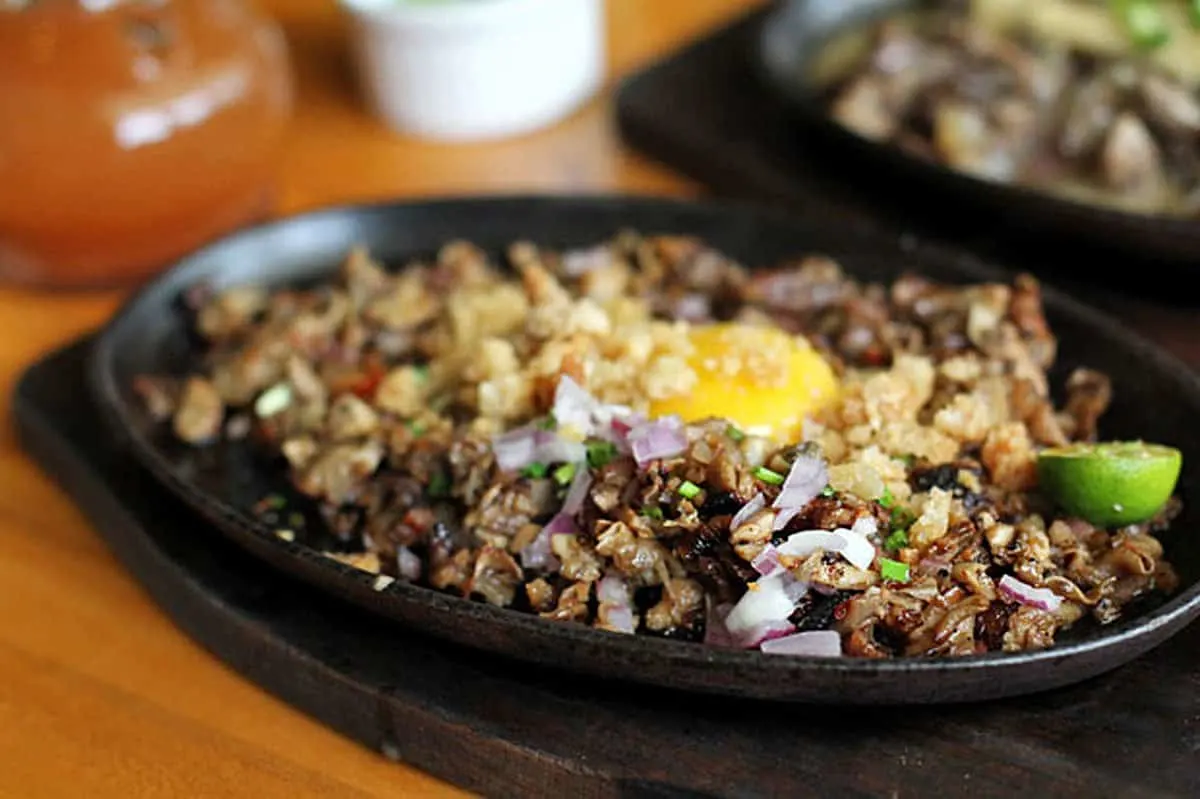
3. Lumpia
Lumpia is the local version of spring rolls. It’s a popular Filipino dish that’s often served as an appetizer at celebrations, gatherings, and sit-down family meals.
Filipino lumpia is made with a thin paper-like crepe filled with a variety of ingredients. It’s usually deep-fried though fresh versions called lumpiang sariwa are also popular. Lumpiang sariwa literally means “fresh lumpia” and is very similar to Fujianese/Teochew-style popiah that’s become popular in many Asian countries like Taiwan, Malaysia, Thailand, and Singapore.
Lumpia is popular throughout the Philippines and comes in many forms. Lumpiang Shanghai is one of the most common. It’s typically filled with sauteed ground pork, onions, carrots, raisins, and other vegetables. In spite of its name, it did not originate in Shanghai or anywhere else in China.
Lumpia can be made pretty much with anything and usually takes the name of its main ingredient. Some of the most popular types of Filipino lumpia include lumpiang ubod (heart of palm), lumpiang tinapa (smoked fish), and lumpiang togue (bean sprouts).
At Filipino bars, you can often find lumpia made with cheese or stuffed long green pepper. Cheese lumpia is usually referred to as “cheese sticks” while lumpia made with pepper is called “dynamite”. No matter what it’s made with, deep-fried Filipino lumpia is usually served with a vinegar-based dipping sauce or banana ketchup.
RECIPE: Lumpiang Shanghai
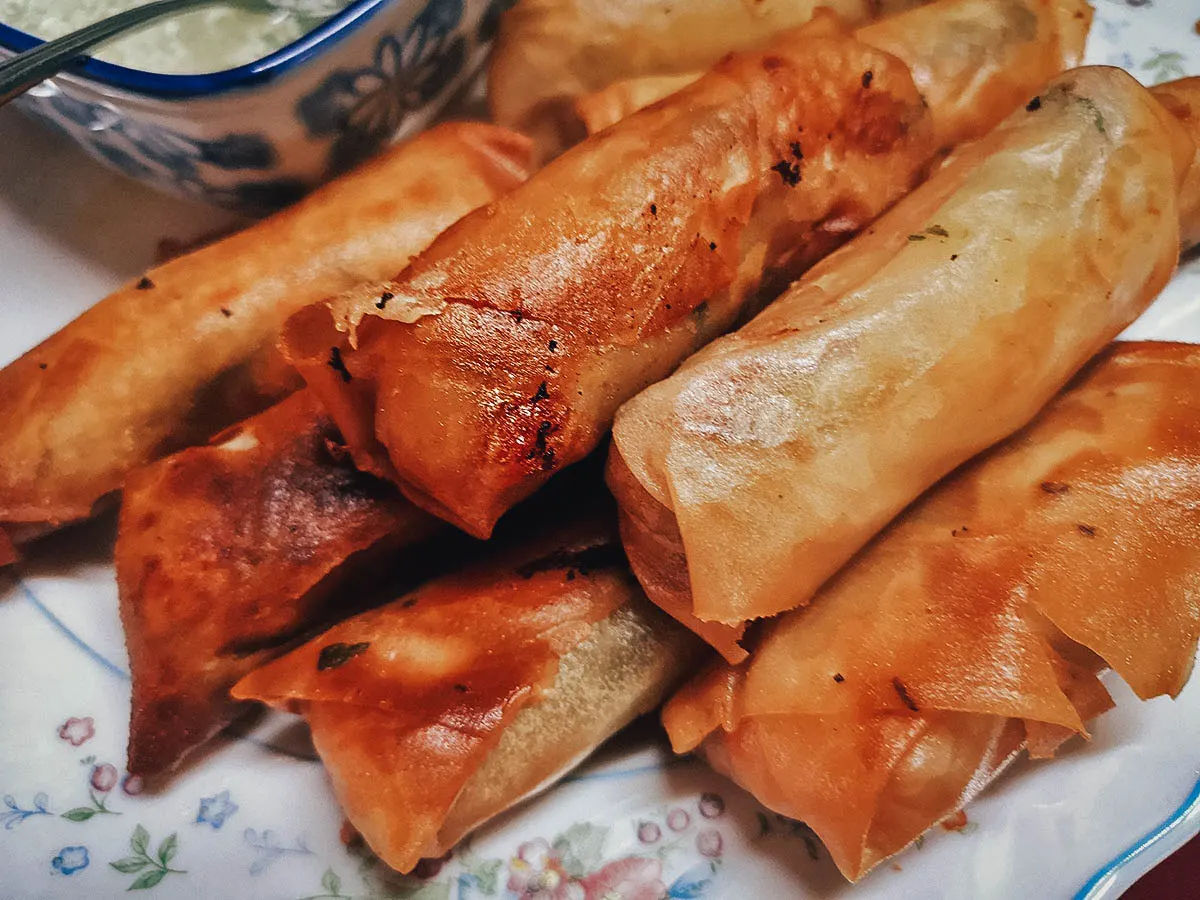
4. Okoy
Okoy (or ukoy) refers to a type of Filipino fritter made with glutinous rice batter, unshelled small shrimp, and a variety of vegetables like julienned carrots, spring onions, bean sprouts, kalabasa (pumpkin), sweet potato, and cassava. The patty is deep-fried till crunchy and served with a vinegar-based dipping sauce to offset its oiliness.
Okoy is a popular Filipino street food dish that’s also commonly served as an appetizer at Filipino restaurants or made as a snack at home. You can find it anywhere in the Philippines but one of the most famous regional variants is from Vigan in Ilocos Sur.
RECIPE: Okoy
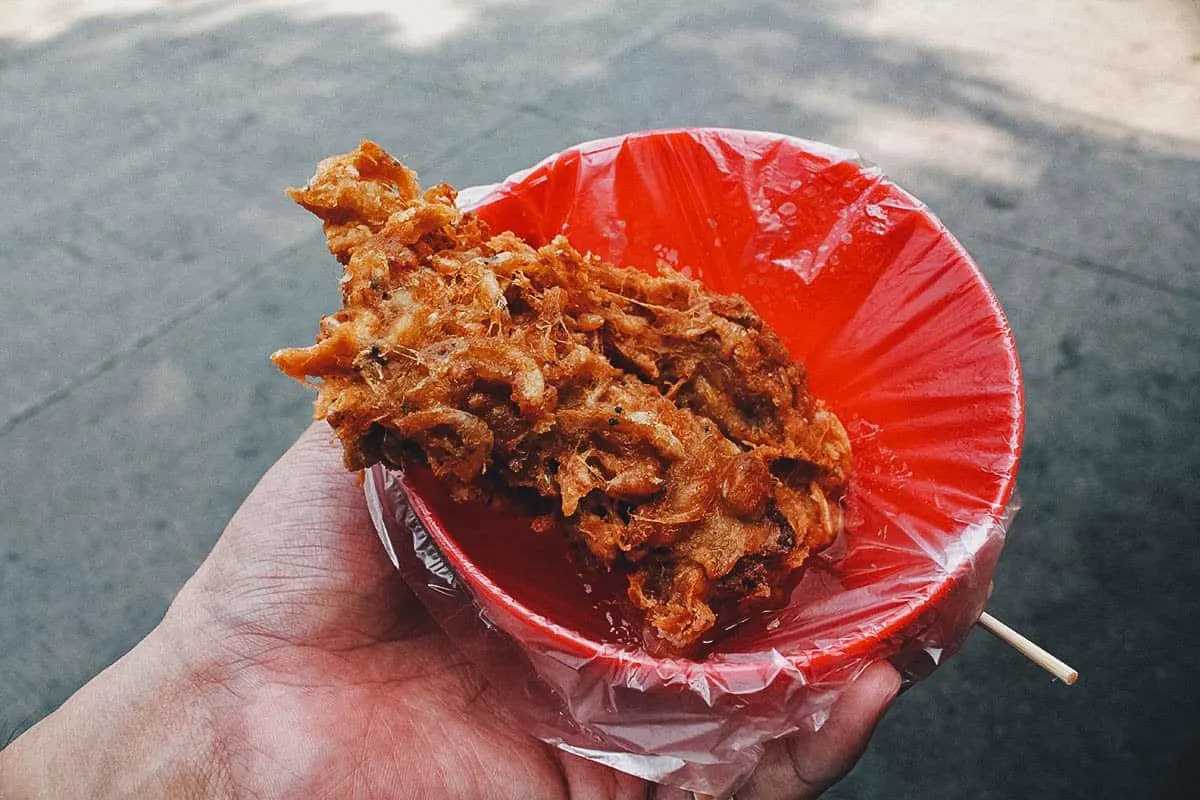
5. Tokwa’t Baboy
Tokwa’t baboy is a classic and hugely popular Filipino dish made with deep-fried tofu, pork belly (and/or ears), and a dressing made from vinegar, soy sauce, onion, and chili pepper. It’s usually made with boiled pork though it can be made with fried pork (pictured below) as well.
Tokwa’t baboy is short for “tokwa at baboy”, which literally means “tofu and pig”. Like sisig, it’s a popular Filipino bar food or appetizer that’s also commonly eaten as a side dish to rice porridge dishes like lugaw, goto, or arroz caldo.
RECIPE: Tokwa’t baboy
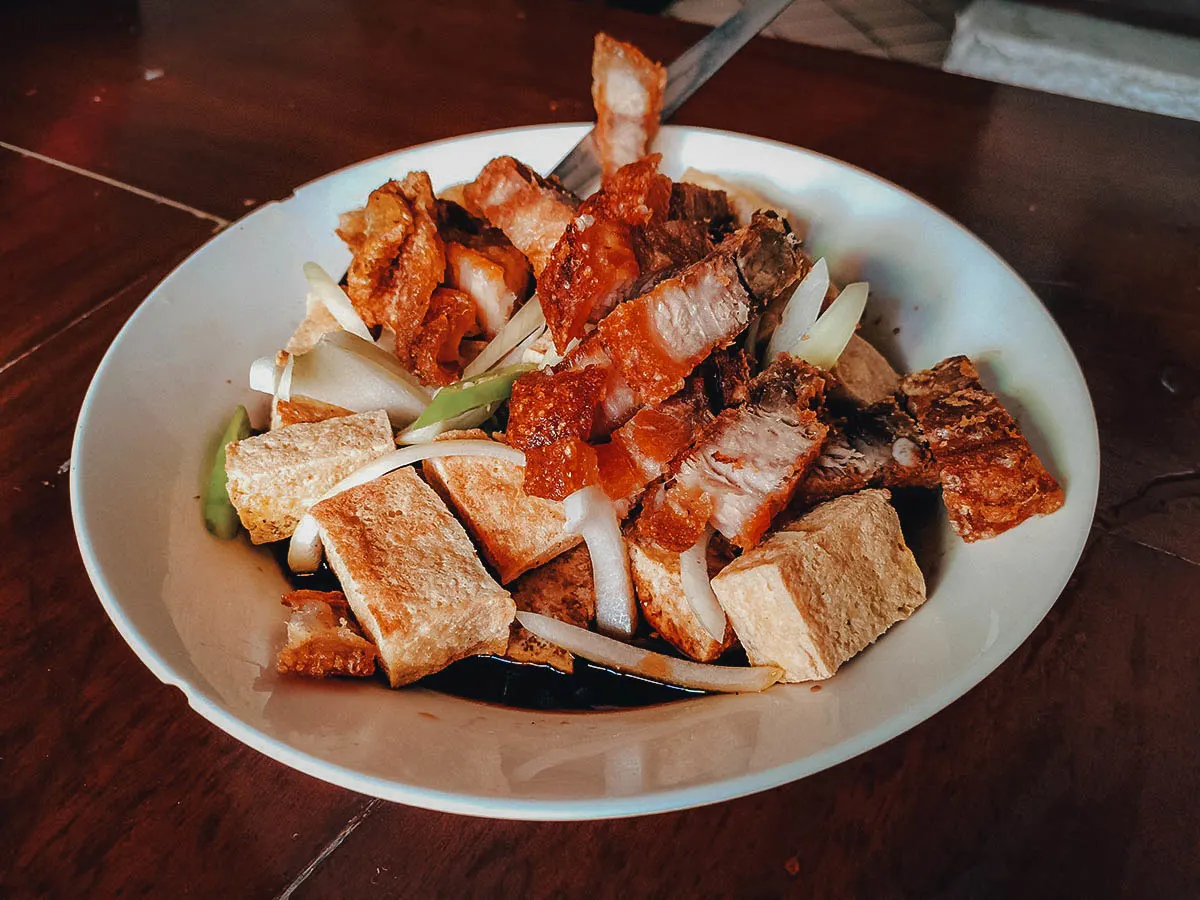
Photo by MikeEdwards
6. Laing
Laing refers to a famous Filipino dish made with shredded or whole taro leaves cooked with coconut milk, pork or seafood, chili peppers, and a host of aromatics like garlic, onions, ginger, and lemongrass. It’s a rich, creamy, and often spicy dish that’s commonly eaten as a side dish with grilled pork or fish and steamed white rice.
Laing is widely consumed throughout the Philippines but it’s originally from the Bicol region where it’s known as pinangat na gabi. Bicolanos are known for their liberal use of chili and coconut milk. Unlike in other parts of the country where laing is made with shredded taro leaves, the original Bicolano version is made with whole leaves that are wrapped around the meat or seafood mixture to form parcels that are then steamed in coconut milk.
RECIPE: Laing
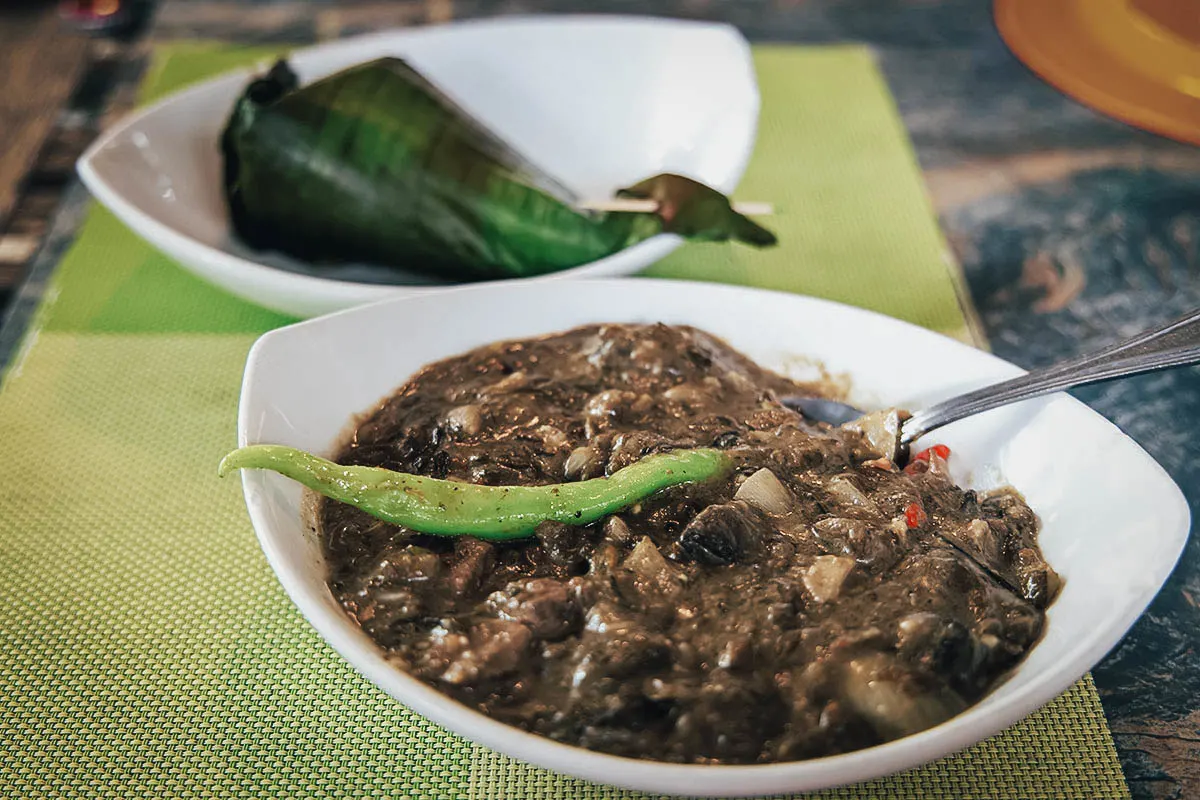
Photo by bugking88
7. Torta
Torta is a Spanish culinary term that can mean many different things. Depending on where you are, it can refer to cakes, pies, flatbreads, and sandwiches but in Filipino cuisine, it refers to a type of omelette.
Torta in the Philippines can be made with egg and different ingredients. Often served as a side dish with banana ketchup, it usually takes the name of its main ingredient like tortang giniling (ground beef or pork) or tortang talong (eggplant, pictured below).
I like all kinds of torta but my favorite is definitely tortang alimasag (blue crab). It’s basically the Filipino version of crab cakes. Crab meat is sauteed with various ingredients like garlic, potatoes, onions, and seasonings before being mixed with egg. The mixture is then stuffed back into the crab shells and pan-fried.
RECIPE: Tortang talong
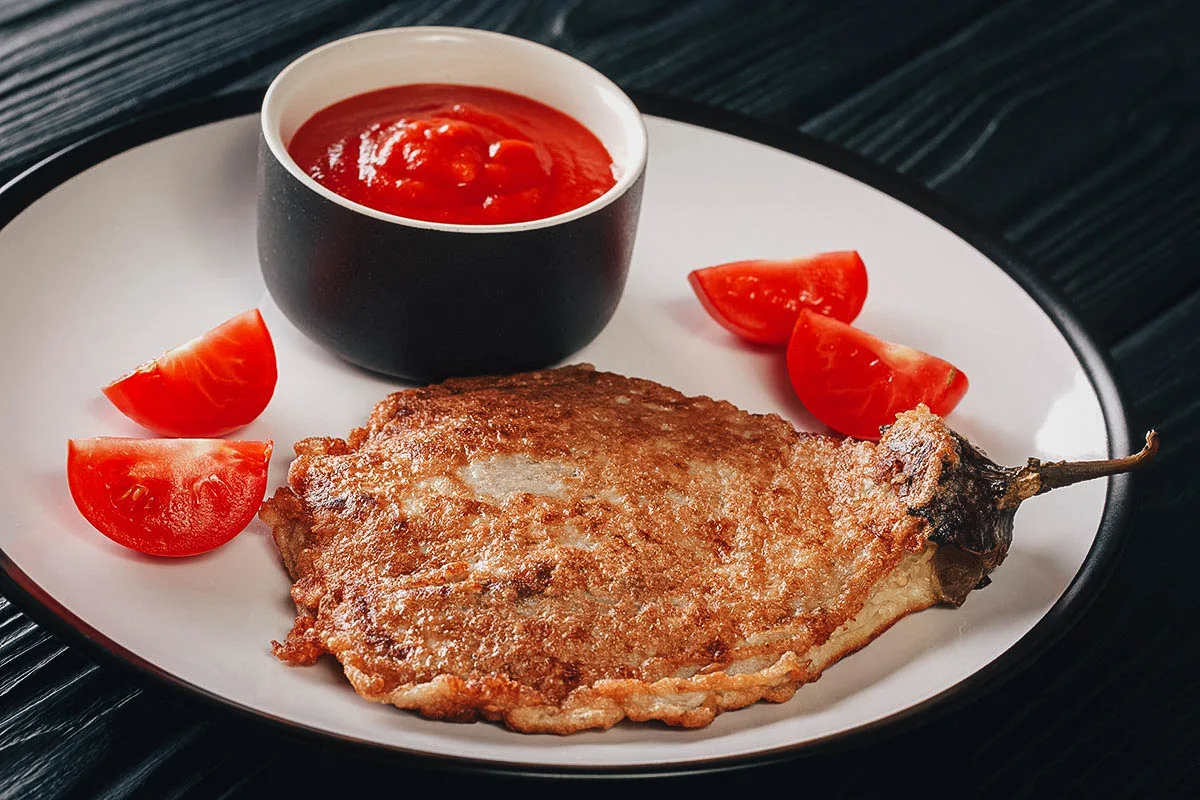
Photo by lenyvavsha
8. Pinakbet
Pinakbet (or pakbet) refers to a famous Filipino dish made with pork belly and different vegetables sauteed in fish or shrimp sauce. It’s originally from the Ilocos region where it derives its name from the Ilocano word pinakebbet, meaning “shriveled”. This is in reference to the vegetables being stewed over low heat until shrunken or shriveled.
Pinakbet is typically made with a host of vegetables and root crops like ampalaya (bitter gourd), eggplant, okra, string beans, and kamote (sweet potato). In the northern Ilocos region, it’s traditionally seasoned with bagoong balayan or fermented fish paste, but in the south, bagoong alamang or fermented shrimp paste is preferred.
RECIPE: Pinakbet Tagalog
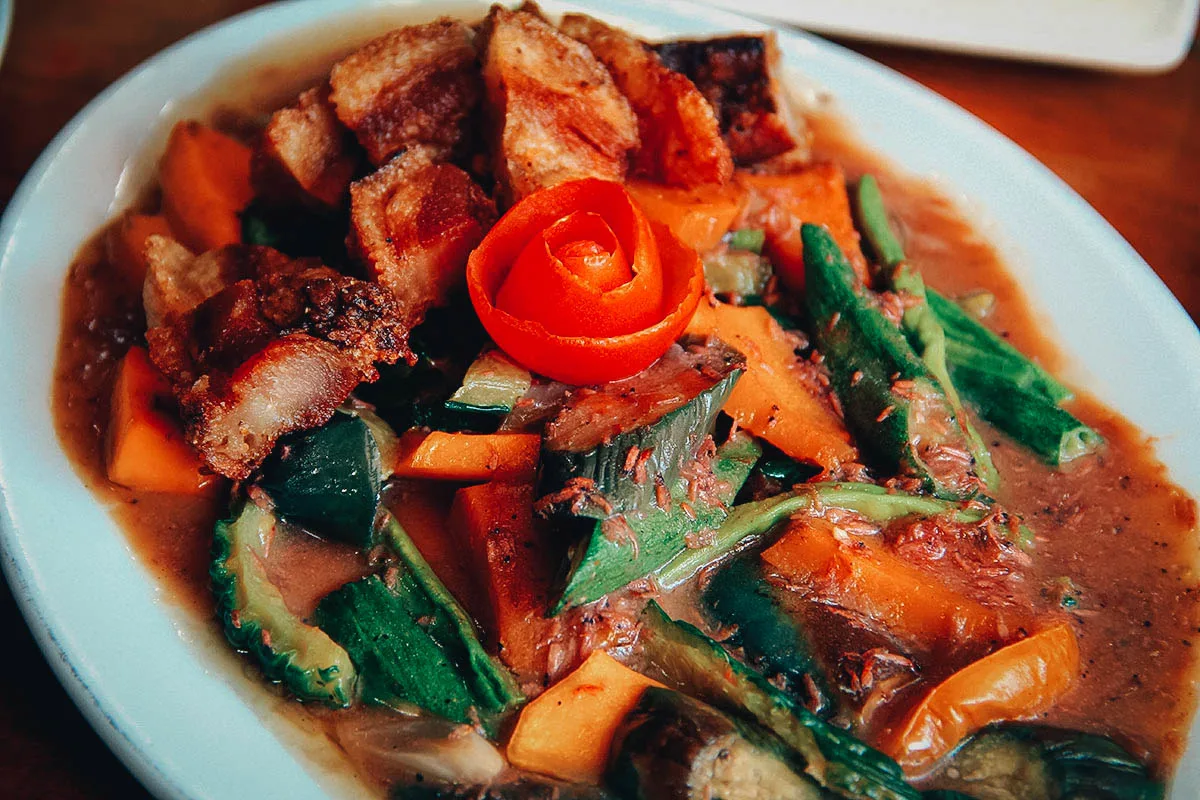
Photo by junpinzon
9. Manga at Bagoong
Manga at bagoong refers to a simple but hugely popular dish of unripe green mango and bagoong alamang. Bagoong alamang is a paste made with fermented shrimp or krill. It’s popular in similar forms throughout Southeast Asia and is known for being an extremely pungent condiment that’s used in many popular Filipino dishes like pinakbet and binagoongan.
To prepare, tiny shrimp or krill are brined and salted before being fermented for about 1-3 months. This fermentation process creates a by-product called patis or fish sauce which is another often used ingredient in Filipino cuisine. As described, a fish-based version of bagoong (bagoong balayan) can also be made by fermenting salted anchovies.
Green mangoes with bagoong alamang is a beloved snack that’s enjoyed throughout the Philippines and often sold as street food. Some people make their own bagoong but bottled versions are readily available at supermarkets so you can easily enjoy manga at bagoong at home.
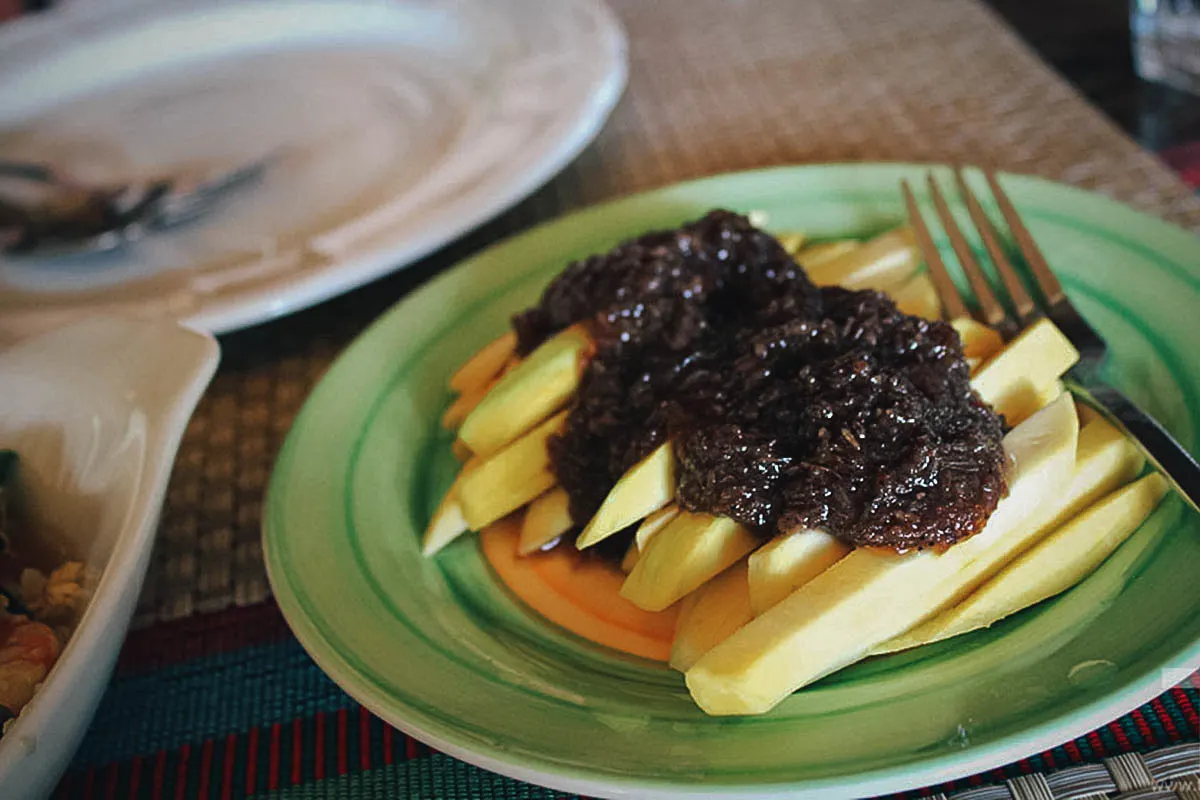
2013 Angeles Philippines Trip Day 5 by tofuprod, used under CC BY-SA 2.0 / Processed in Photoshop and Lightroom
10. Balut
Balut is one of the most famous – or should I say infamous – dishes in this food guide. Even if you’ve never had Filipino food, chances are you’ve at least heard of balut. It refers to a fertilized duck egg embryo that’s been incubated for 14-21 days, boiled, and then eaten directly from its shell.
Balut consists of four parts – the “soup”, the yolk, the embryo, and the albumen which can often be too hard to eat. Depending on how long it’s been incubated before being boiled, you’ll find balut with the embryo in different stages of development. The ideal incubation period is said to be exactly seventeen days. At that stage, the embryo is completely soft and unrecognizable save for its developing feathers.
With that said, it isn’t unheard of to get balut that’s been incubated longer. Those will have much bigger embryos that already resemble ducklings. They’re still soft and edible but they may have harder beaks that you’ll need to spit out. Thankfully, I’ve never gotten one with bones that were already developed.
You might also come across a version of balut called “penoy”. These are the balut eggs that didn’t properly develop after 9-12 days. Balut penoy is like a hard-boiled egg with no separation between the yolk and egg white, kind of like a semi-scrambled egg still in its shell.
Balut is a popular Filipino street food dish that’s a cheap source of protein and calcium. I rarely eat them but I did grow up with people who did so I don’t find them off-putting or weird. If you do find them challenging, then not to worry because many Filipinos do as well. Ren for example, loves the soup and yolk but she won’t touch the embryo.
To eat, balut is often seasoned with salt and/or a chili, garlic, and vinegar mixture, but I’ve always eaten it as is. Some restaurants these days will even serve them in a more elevated way. I’ve seen them served adobo-style, on sizzling skillets, even in a souffle.
We Filipinos know how off-putting balut can be for many tourists so we get a kick out of challenging them to eat it. Most chicken out.
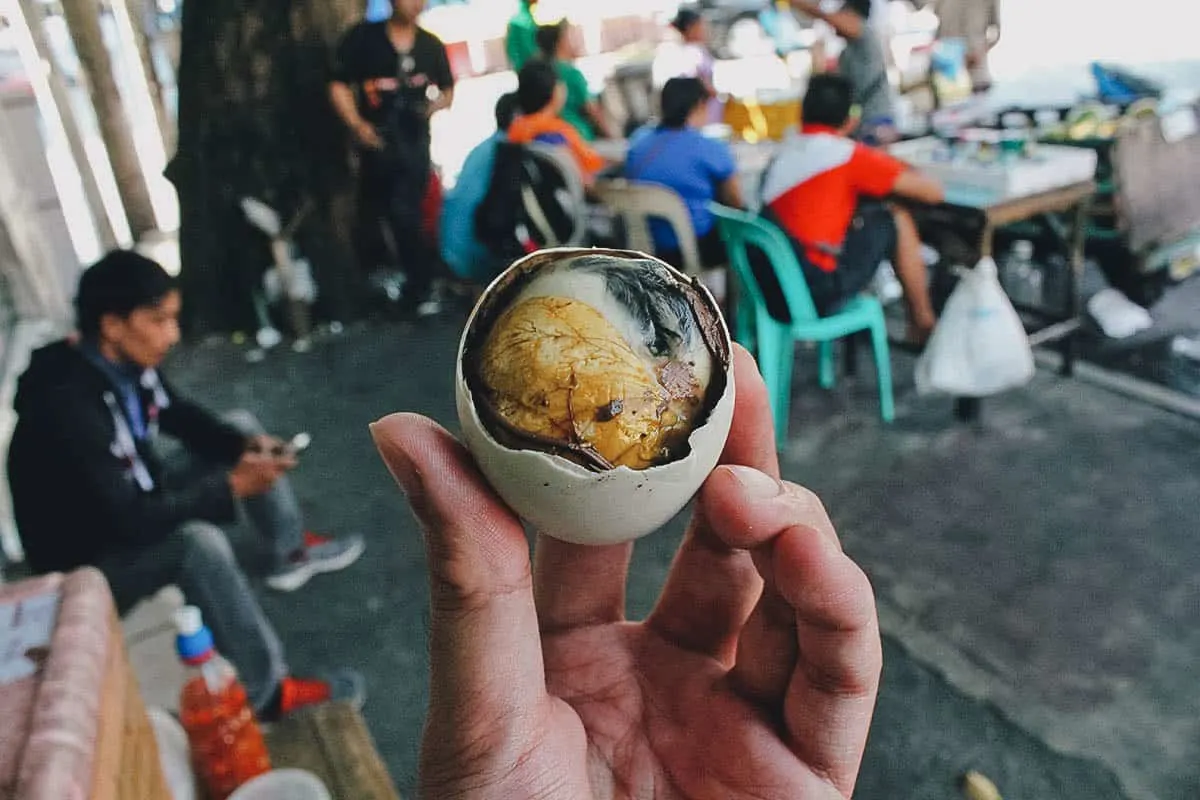
MEATS / POULTRY
11. Longganisa
Longganisa is derived from the Spanish word longaniza and refers to Filipino sausage. It’s one of the most important dishes in Filipino cuisine with dozens of variants throughout the Philippines. Longganisa is so popular and integral to Filipino cooking that many regions in the country hold annual festivals to celebrate and promote it.
Longganisa is typically made with pork and commonly eaten for breakfast as longsilog. When consumed as a breakfast dish, it’s enjoyed with sinangag (garlic fried rice), a fried egg, atchara (pickled green papaya), and a vinegar dipping sauce. Dozens of varieties exist but they usually fall into one of two general categories – de recado and hamonado. De recado refers to savory sausages while hamonado longganisas are more savory-sweet.
We love longgaisa so we’ve been meaning to do a tour of the Philippines to document the country’s best and most interesting longganisas. Listed below are some of the most famous types of longganisa in the Philippines.
Vigan Longgnaisa (de recado) – This is my favorite type of longganisa. Originally from Vigan in Ilocos Sur, it’s smaller than most longganisas and is known for its liberal use of garlic.
Lucban Longganisa (de recado) – Originally from Lucban in Quezon province, Lucban longganisa is known for its use of oregano and its garlicky and vinegary taste. You can find them skinless or with the usual sausage casing.
Calumpit Longganisa (de recado) – Hailing from Calumpit in Bulacan province, Calumpit longganisa is made with lean pork, pork fat, garlic, bay leaves, soy sauce, vinegar, brown sugar, salt, black pepper, and paprika.
Alaminos Longganisa (de recado) – Originally from Alaminos in Pangasinan, Alaminos longganisas are made with achuete (annatto) seeds, giving them a yellowish or orange hue. They’re one of the more easily identifiable longganisas thanks to their color and the coconut leaf midribs that hold the sausage links together.
Tuguegarao Longganisa (de recado) – Tuguegarao longganisa is from Tuguegarao City in Cagayan province. Often more yellowish or orange in color, it’s made with coarsely ground pork, garlic, black pepper, coarse salt, and cane vinegar.
Cabanatuan Longganisa (de recado or hamonado) – Cabanatuan longganisa (or batutay) is from Cabanatuan City in Nueva Ecija. They can be sweeter (hamonado) or more garlicky (de recado) and unlike the vast majority of longganisas, they’re made with beef instead of pork.
Pampanga Longganisa (hamonado) – Hailing from the culinary capital of the Philippines, Pampanga longganisa is the most popular type of hamonado longganisa in the Philippines. Usually thinner and longer than the average longganisa, it can be prepared with or without the casing and is often tinted orange or red from achuete seeds.
Chorizo de Cebu (hamonado) – Chorizo de Cebu (or longganisa de Cebu) are more spherical in shape and have a distinct reddish color from the use of achuete seeds. As its name suggests, it’s from the province of Cebu.
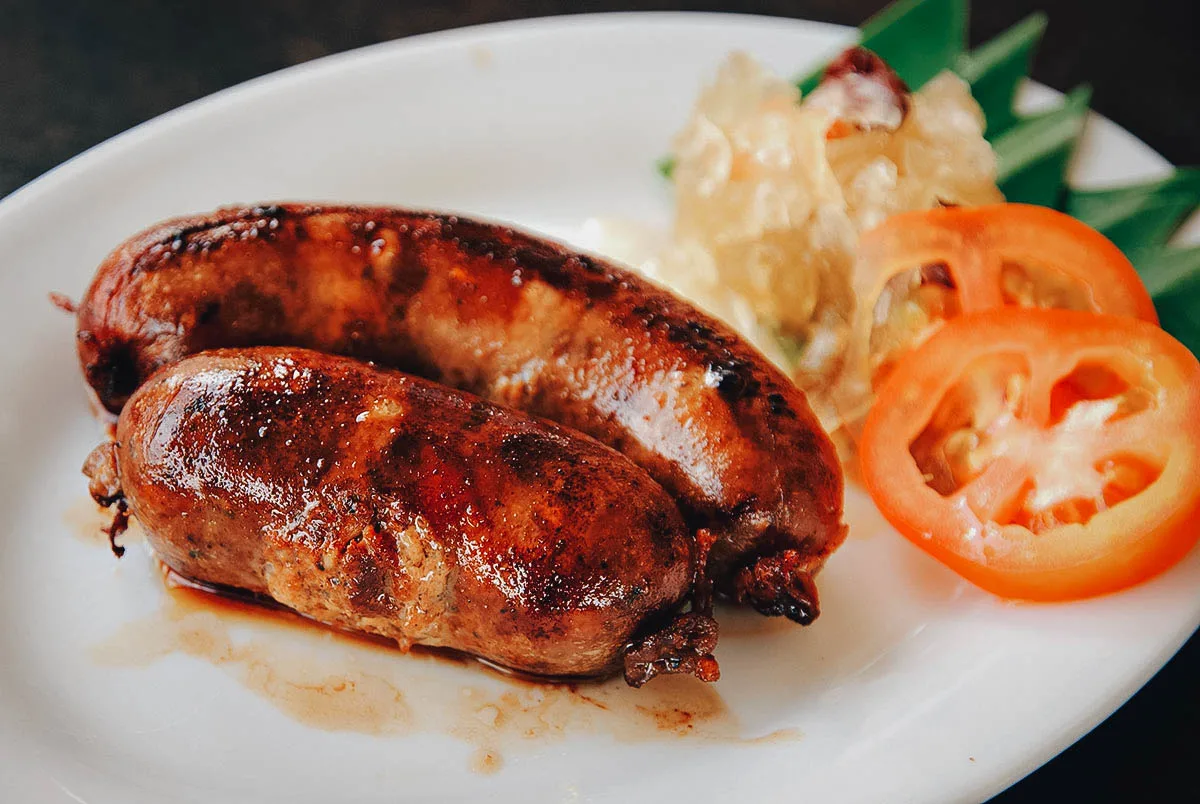
Photo by audioscience
12. Pork Barbecue
Like longganisa, pork barbecue is one of the most popular dishes in Filipino cuisine. It refers to marinated pieces of pork skewered on bamboo sticks and grilled over charcoal. You can think of it as the local version of Indonesian or Malaysian sate.
Pork barbecue is a popular Filipino street food but it’s also served at many gatherings and celebrations. It’s a staple dish at chilldren’s birthday parties where it’s served alongside other party favorites like Filipino-style sweet spaghetti and red hot dogs. At Filipino buffets or catered events, you’ll often find a chafing dish filled with sticks of pork barbecue.
I don’t know if you can see it below but sticks of pork barbecue will usually have one piece of pork fat at the bottom. Like American pizza crusts, some Filipinos will eat it while others never do.
RECIPE: Filipino pork barbecue
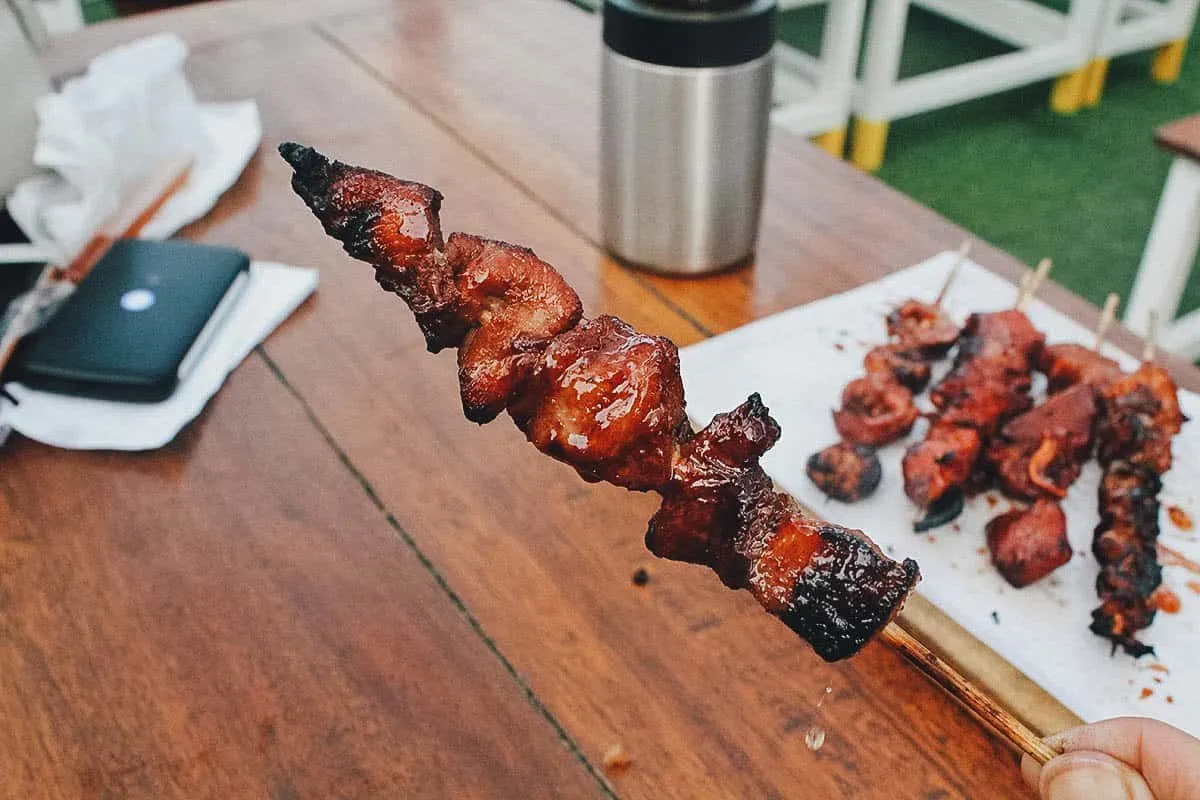
13. Chicken Inasal
Chicken inasal is one of our favorite Filipino comfort foods. It refers to chicken marinated in calamansi, vinegar, pepper, and achuete before being grilled over charcoal while being basted with the marinade. Chicken inasal is originally from Bacolod City and the western Visayas region but it’s become hugely popular throughout the Philippines.
You can think of chicken inasal as a variant of lechon manok. But unlike lechon manok which is spit-roasted whole, inasal is cut up into pieces and usually skewered on bamboo sticks before being grilled. When served at a restaurant, you can order it by part – ie paa (thigh), pecho (breast), pak-pak (wings), or isol (butts).
Chicken inasal is usually served with white rice and a dipping sauce made with vinegar, soy sauce, chili pepper, and calamansi. Good inasal restaurants will also have a bottle of chicken oil at every table that you can pour over your rice and/or mix into your dipping sauce.
RECIPE: Chicken inasal
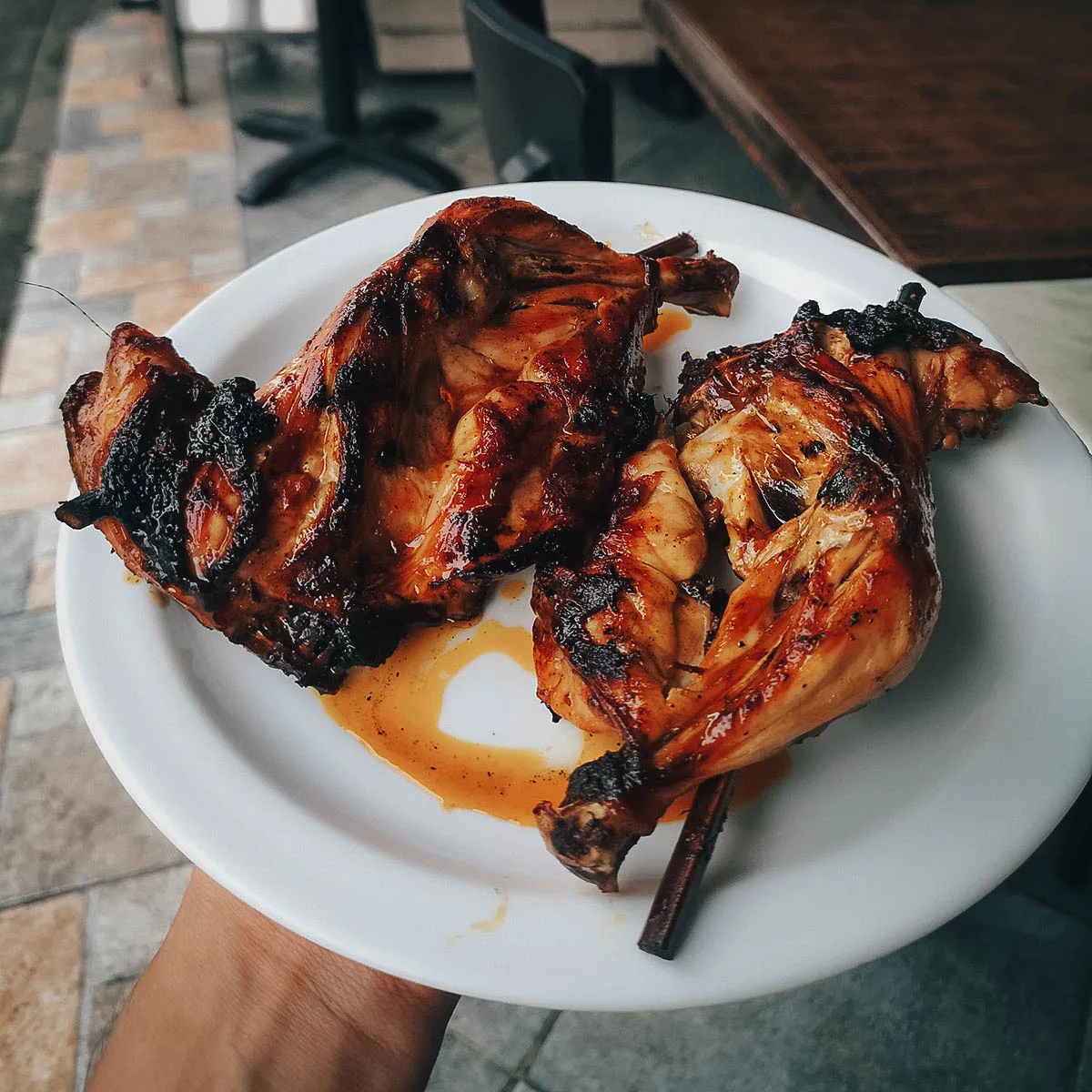
14. Crispy Pata
Crispy pata refers to a famous Filipino dish of deep-fried pork trotters or knuckles served with a dipping sauce made with vinegar, soy sauce, garlic, onions, sugar, and ground black pepper. To prepare, the pork leg is boiled to tenderize the meat before being deep-fried till golden brown and crispy.
When cooked well, crispy pata is crunchy on the outside with moist and tender meat. It’s usually served as a main dish with white rice or as bar chow.
RECIPE: Crispy pata
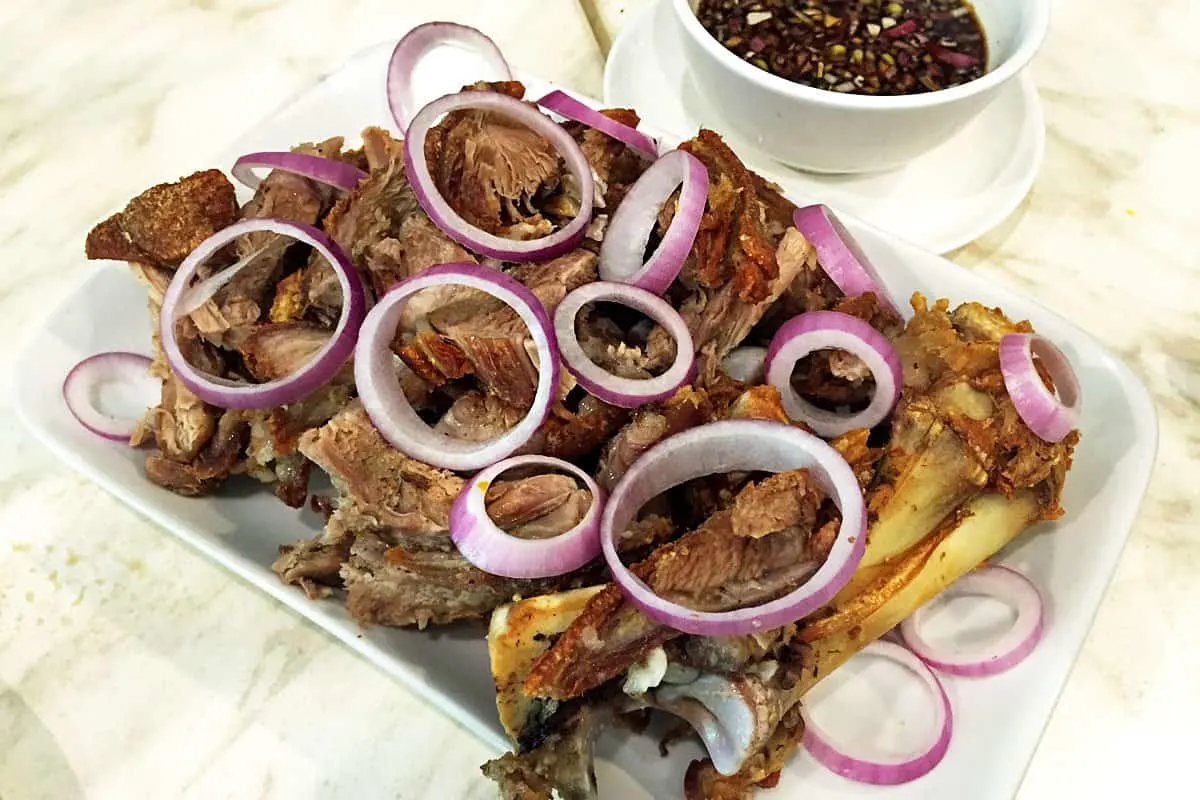
15. Sinigang
Sinigang is another popular and important dish in Filipino cuisine. It refers to a type of soup or stew characterized by its sour and savory flavors. It’s usually tamarind-based though other acidic Filipino fruits can be used as souring agents like batuan, guava, kamias, and santol.
Sinigang is usually made with different vegetables and some type of meat or seafood like pork, beef, shrimp, or fish. It’s usually paired with white rice and served with patis (fish sauce) as a condiment.
Like many of the dishes in this Filipino food guide, sinigang can refer to both the dish and the cooking method. There are many versions of sinigang and their names are usually derived from the main ingredients used in the dish. Some of the most popular types of sinigang include sinigang na isda sa miso (fish and fermented soybean paste), sinigang na baboy (pork, pictured below), and sinigang na hipon (shrimp).
RECIPE: Sinigang na baboy (pork) with gabi (taro)
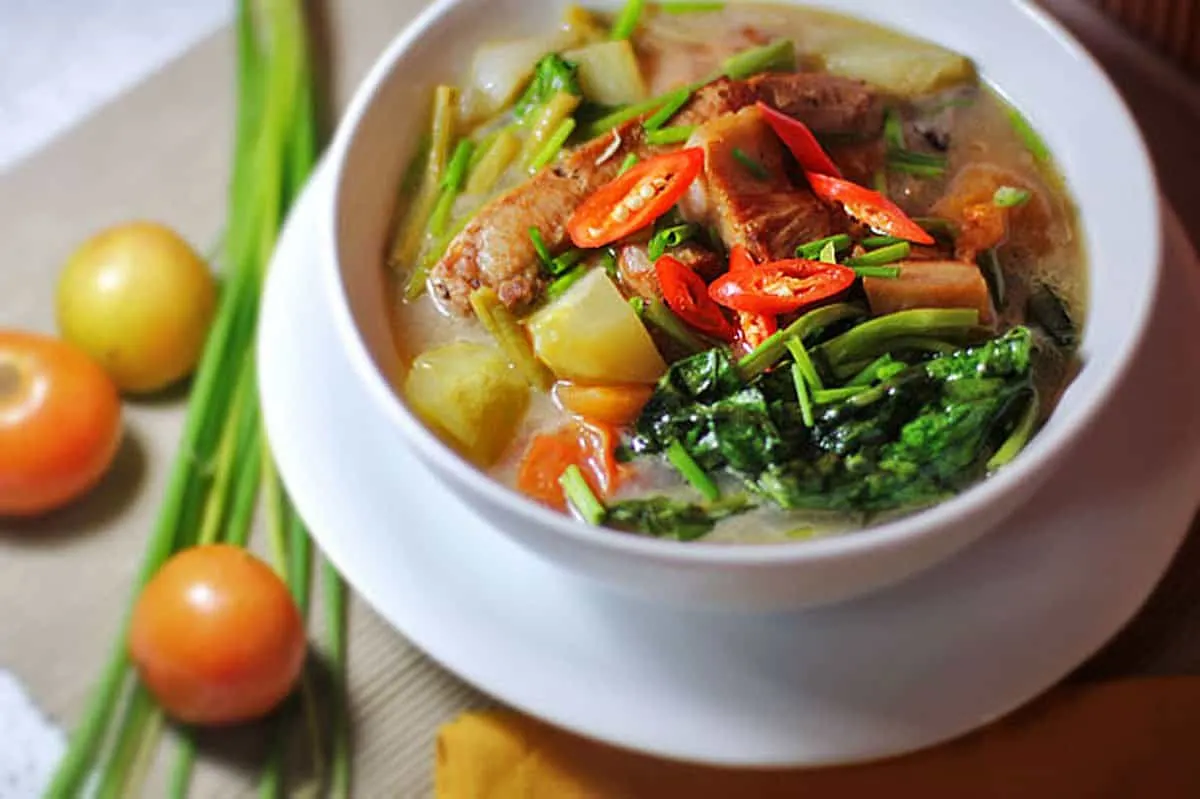
This is a type of sinigang na hipon made with ulang or giant freshwater prawns. You can’t really tell from this picture but these prawns were massive, about 30 cm (12 in) each!

16. Kare-Kare
Kare-kare is another popular and interesting Filipino dish. It refers to a curry-like stew made with different meats and vegetables served in a thick and savory peanut sauce.
To make kare-kare, different cuts of meat like oxtail, tripe, pork hocks, and pork trotters are simmered for hours till fork tender. The kare-kare sauce is then flavored with ground peanuts (or peanut butter) and thickened with toasted ground rice (or rice flour) before being colored with achuete and served with blanched vegetables like Chinese cabbage, long beans, banana heart, and eggplant. Kare-kare is usually served as a main dish with steamed white rice and eaten with bagoong alamang (shrimp paste) as a condiment.
The origins of kare-kare are unclear, but one of the more interesting theories claims that it was invented by South Indian sepoys who were stationed in the Philippines during the British occupation. They made use of whatever spices and ingredients were available to create a dish called kari-kaari, which eventually became known as kare-kare.
RECIPE: Kare-kare
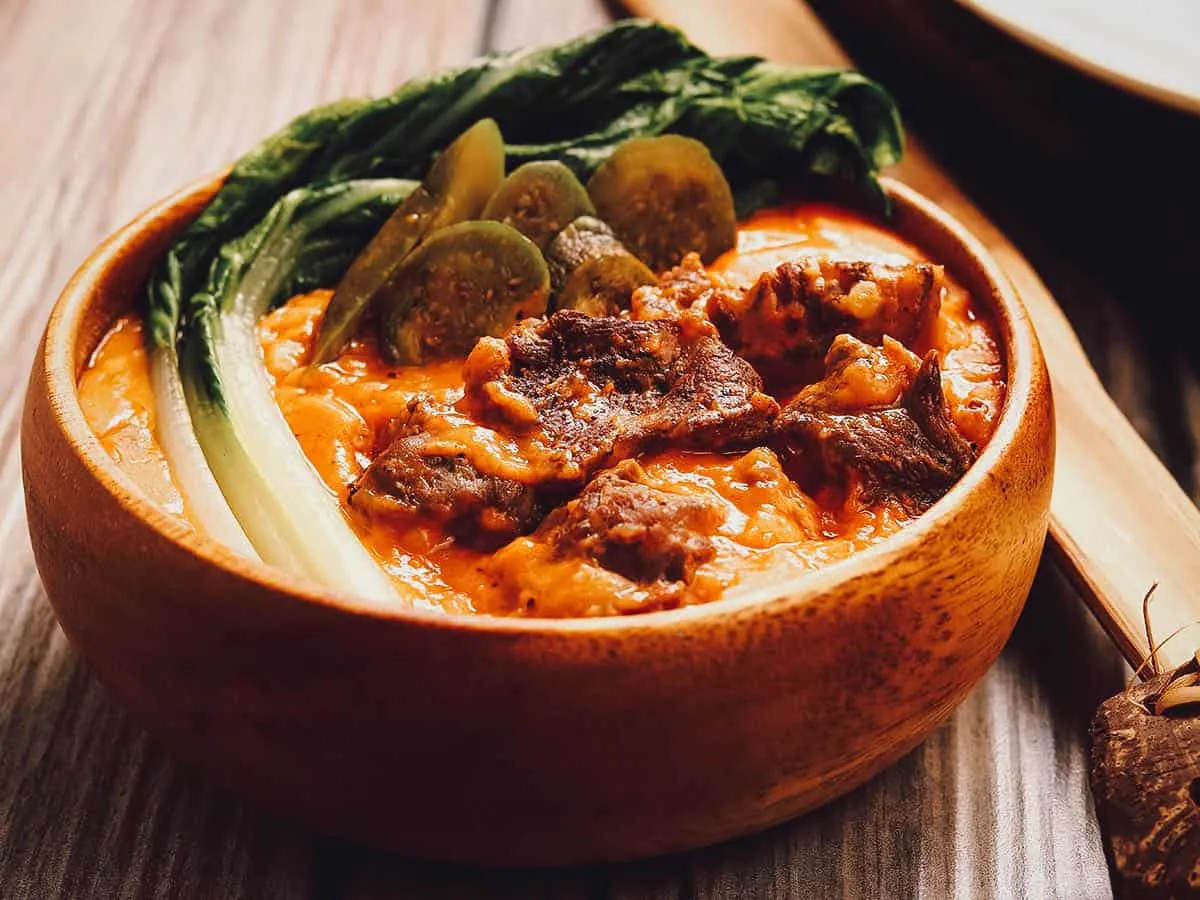
Photo by Create Hot Look via Shutterstock
17. Dinuguan
Dinuguan is another interesting and perhaps somewhat weird Filipino dish that’s best reserved for the more daring. It refers to a Filipino stew made with diced pork or offal cooked in a dark gravy made with pig’s blood, vinegar, garlic, and chili. The name dinuguan is derived from “dugo”, which is the Filipino word for “blood”.
Dinuguan can be made with diced pork and/or offal but if you can, then I suggest trying the version with offal. It’s tastier with more interesting textures. Typical organ meats used for dinuguan include pork lungs, kidneys, intestines, heart, snout, and ears. Unlike most Filipino viands which are eaten with rice, dinuguan is best paired with puto or steamed rice cakes.
If you travel through the Philippines, then you may find that dinuguan is called by other names in different regions of the country. For example, it’s also called tid-tad in the Kapampangan areas, sinugaok in Batangas, dinardaraan in Ilocos, dugo-dugo in Cebu, and tinumis in Bulacan and Nueva Ecija.
RECIPE: Dinuguan
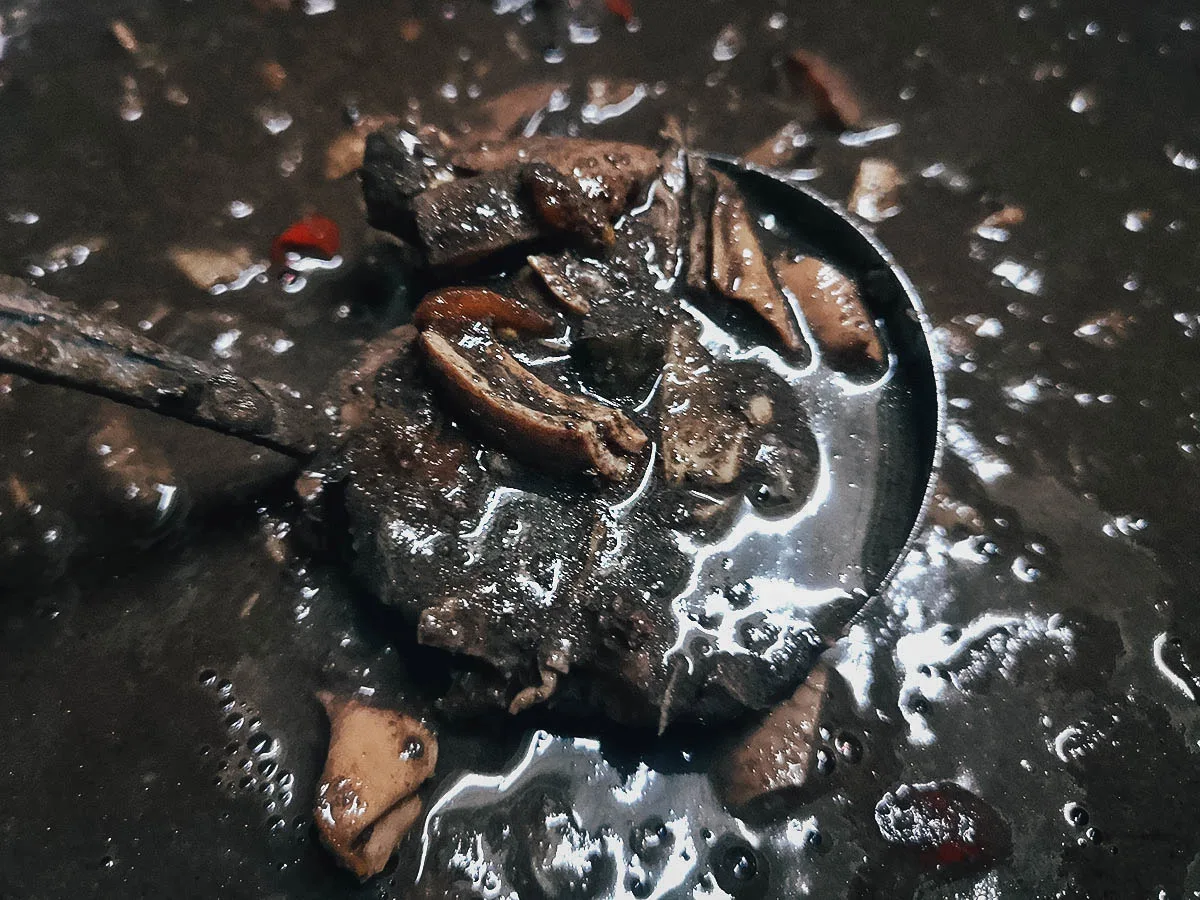
18. Adobo
Adobo is one of the most well-known Filipino foods and perhaps the single most important dish on this list. It’s often regarded as a Filipino national dish.
Like sinigang, the word adobo can be used to refer to both the dish and the cooking method. To make adobo, meat, seafood, or vegetables are marinated in a braising mixture of vinegar, soy sauce, black peppercorn, bay leaves, and garlic. It’s typically made with chicken and pork that are left to simmer over low heat until they break down and become fork-tender in a thick, flavorful sauce.
The name adobo stems from the Spanish word adobar, which means “to marinate”, but the dish or cooking method wasn’t introduced by the Spaniards. It dates back to the pre-Hispanic period when early Filipinos would cook their chicken and pork by immersing it in vinegar and salt, probably as a means of preservation. The dish got its name from Spanish colonizers who encountered the cooking process and called it adobo de los naturales, or “adobo of the native peoples”.
Though chicken and pork adobo are the most common, there are many versions of the dish. Depending on what they’re made with, they can be served as a main dish with rice or as a side dish. Listed below are some of the most popular types of adobo in the Philippines.
Chicken and Pork Adobo – The most popular version of adobo made with both chicken and pork (pictured below).
Adobong Pusit – This is my favorite type of adobo. It’s made with squid and its ink mixed into the braising liquid, resulting in a beautifully black and incredibly delicious adobo.
Adobong Kangkong – This is the most common non-meat version of adobo. Also known as apan-apan, it’s made with kangkong or water spinach as its main ingredient though some places will serve it with bits of pork mixed in. It’s a great side dish to have with grilled meats like liempo or inasal.
Adobong Puti – This version of adobo is flavored with sea salt instead of soy sauce. Much lighter in color (puti means “white”) than soy-sauce-based adobos, it’s been described as the closest version to the original pre-Hispanic adobo, before Chinese traders introduced soy sauce to the Philippines.
Adobong Dilaw – Meaning “yellow adobo”, adobong dilaw is flavored with turmeric, giving it its distinct yellowish color. It’s said to have originated in Taal, Batangas.
Adobo sa Gata – Popular in Bicol and in other parts of Southern Luzon, adobo sa gata is made with coconut milk and substitutes black peppercorns with green finger chilis.
Adobong Pula – Adobong pula means “red adobo”. It’s an Ilonggo version of adobo noted for its reddish tint that comes from the use of achuete seeds.
RECIPE: Pork adobo
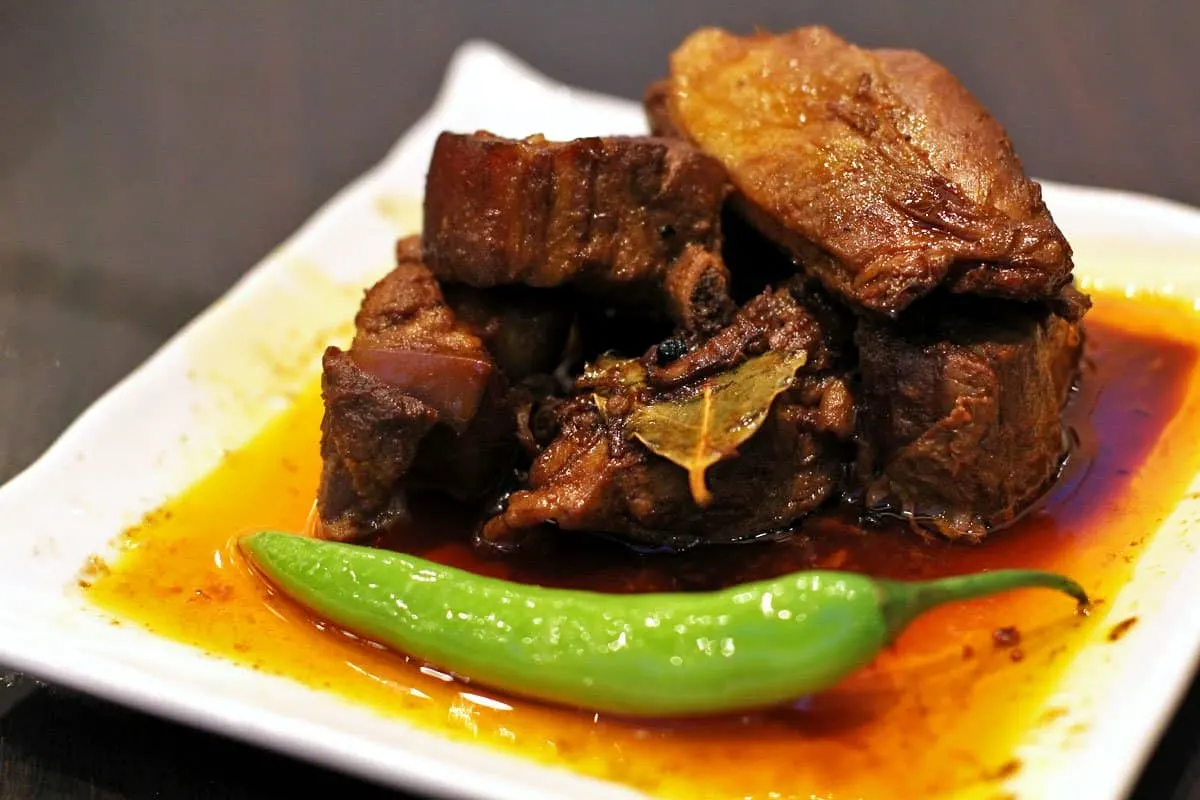
19. Bulalo
Bulalo is a light-colored soup made with leafy vegetables, corn on the cob, and beef shanks filled with bone marrow. It’s basically a type of nilaga dish (boiled meat and vegetable soup) made specifically with beef shanks containing marrow. To prepare, the beef shanks are simmered for several hours until the collagen and fat melt into the clear broth.
Popular in the provinces of Batangas and Cavite, bulalo is a beloved Filipino comfort food that’s usually paired with rice and a dipping sauce made with fish sauce and calamansi.
RECIPE: Bulalo
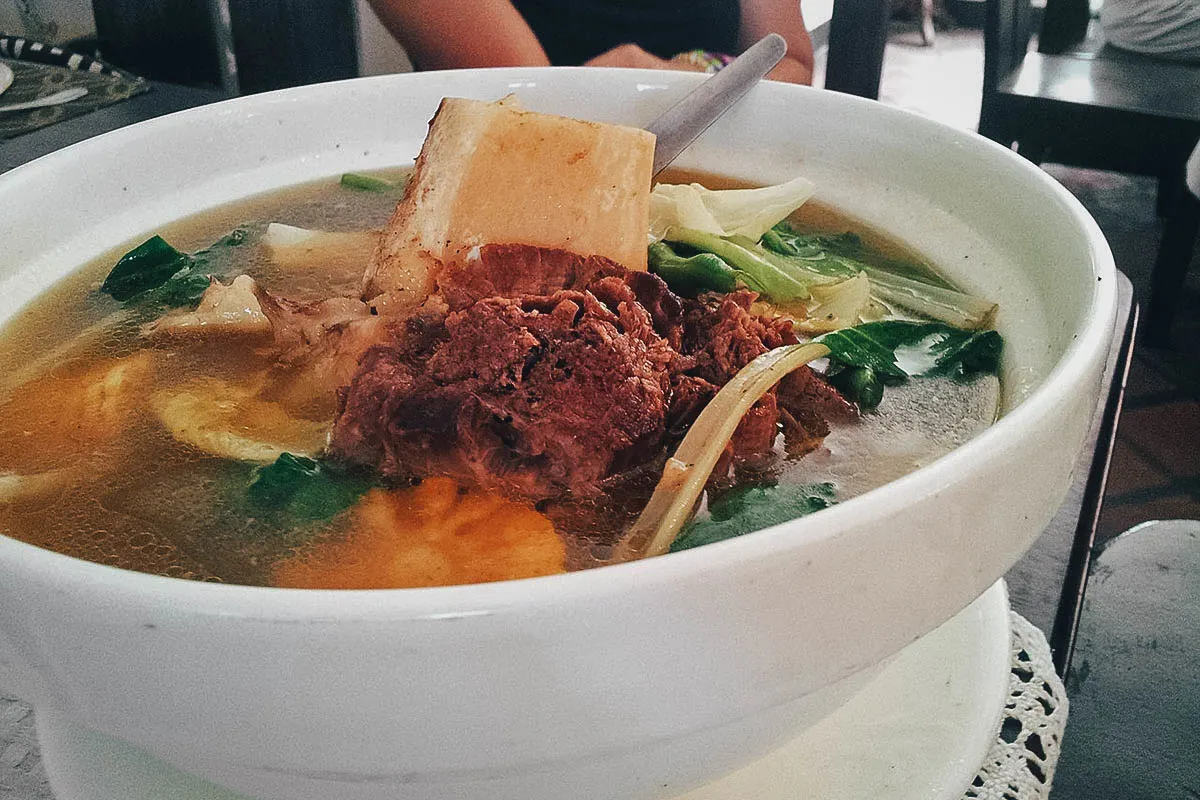
Yvette Tan, CC BY 2.0, via Wikimedia Commons / Processed in Photoshop and Lightroom
20. Bopis
Bopis is one of my favorite dishes in the Philippines, though like dinuguan, it may not be for the faint of heart (pun intended). It refers to a spicy dish made with minced pork heart and lung sauteed in garlic, onions, and chili peppers.
Like many famous Filipino dishes, recipes for bopis may vary from region to region. I’ve heard of saucier versions made with tomato sauce but personally, I prefer the Kapampangan version which is mostly dry and made with vinegar. Bopis is often paired with steamed rice or eaten as bar chow.
RECIPE: Bopis
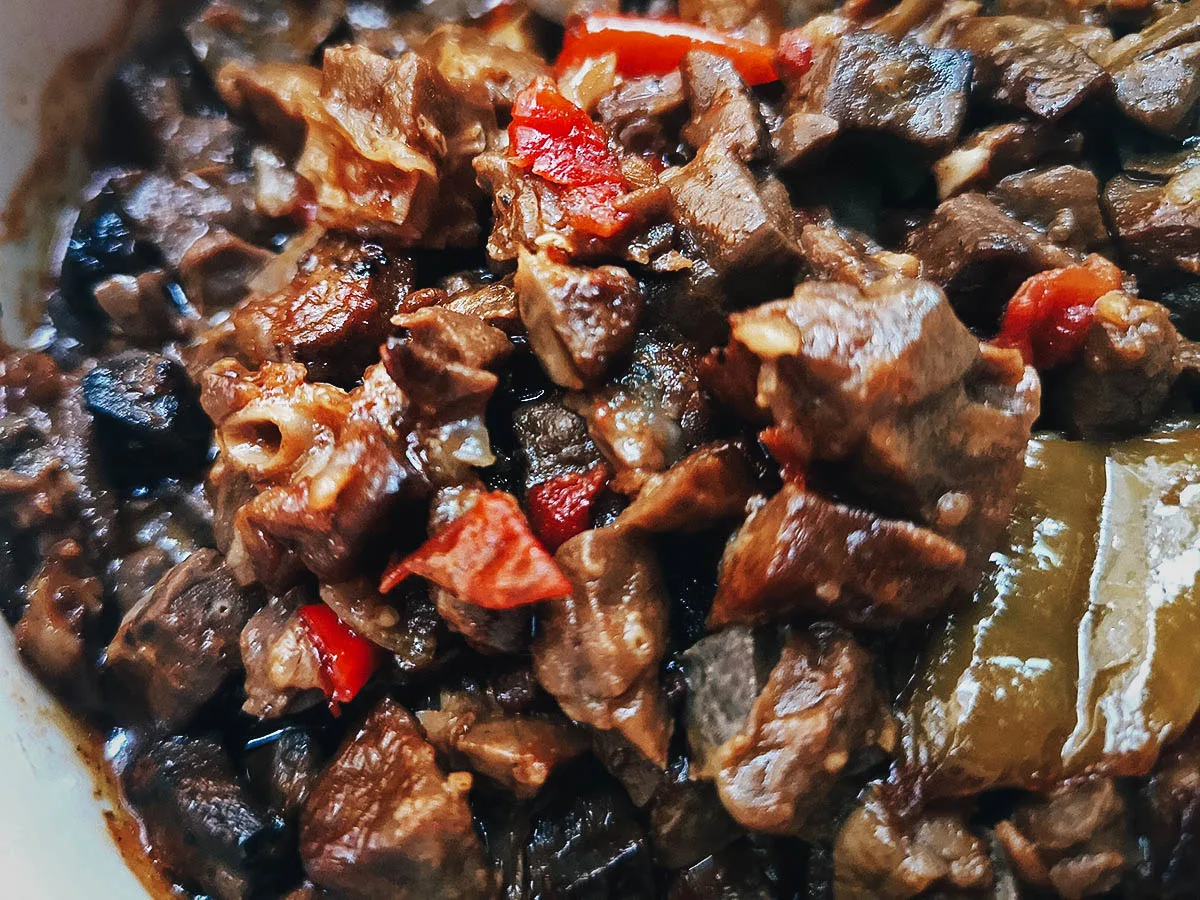
21. Bicol Express
If you’ve been disappointed by the lack of heat in Filipino food so far, then you’re going to love Bicol express. As its name suggests, it’s a specialty of the Bicol region where it’s known as sinilihan, meaning “made with chili”. Bicolanos often cook with chili and coconut milk so if you want spicy (and creamy) Filipino food, then you need to try Bicol express.
Bicol express is a stew made with pork belly, coconut milk/cream, bagoong alamang (shrimp paste), and generous amounts of finger chilis and siling labuyo (bird’s eye chili). It’s spicy and creamy and best eaten with steamed rice to help tone down the heat.
Interestingly, Bicol express got its name from a cooking competition in Manila in the 1970s. The contestant credited for inventing the dish had ties to Bicol and was inspired by the sound of a passing train from the Philippine National Railway. She named it Bicol Express after the train that traveled to and from Manila to Legzpi City, the regional center of Bicol.
RECIPE: Bicol Express
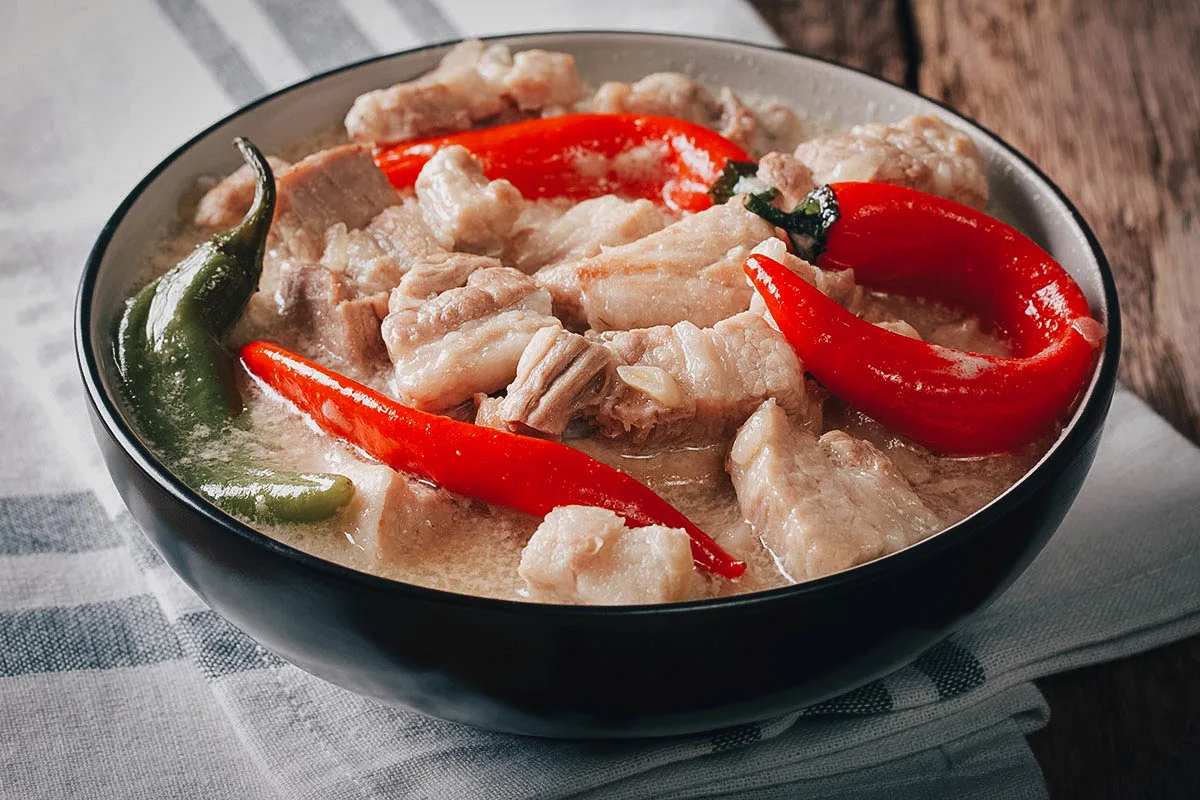
Photo by lenyvavsha
22. Papaitan
Papaitan is another interesting dish that isn’t for the meek. It refers to a well-known Ilocano soup made with goat innards. The name papaitan is derived from the word “pait”, which means “bitter” in Filipino, and is in reference to the bitter bile used in the soup.
Papaitan is traditionally made with goat innards but it can be made with ox and beef offal as well. Recipes vary but bile is the key ingredient which gives the soup its characteristically bitter flavor. It’s definitely an acquired taste, even for Filipinos who didn’t grow up with it.
RECIPE: Papaitan
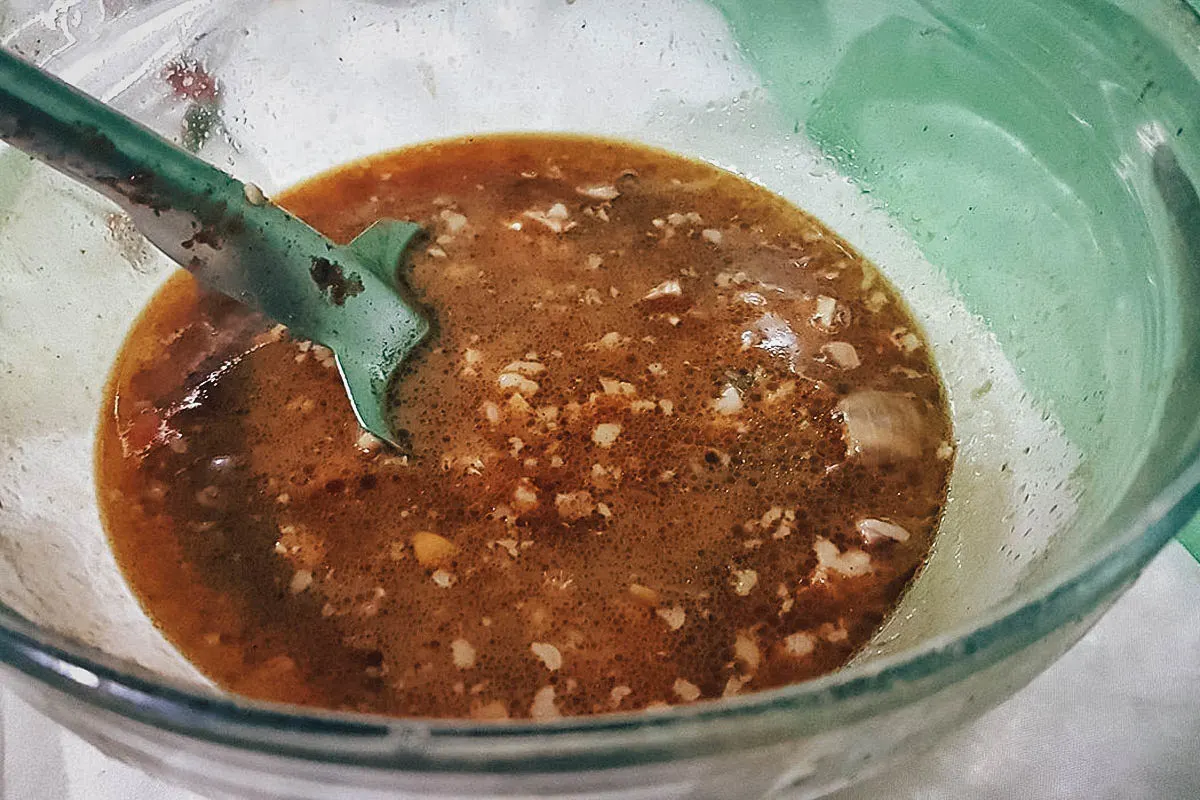
Obsidian Soul, CC0, via Wikimedia Commons / Processed in Photoshop and Lightroom
23. Lechon
Like adobo and longganisa, lechon is one of the most beloved and culturally significant Filipino foods. It refers to spit-roasted pig and is the de facto food of choice at fiestas (festivals), holidays, and celebratory gatherings. Lechon is a Spanish word meaning “roasted piglet” but in the Philippines, it refers to a full-grown roasted pig. Roasted piglets are referred to as lechon de leche.
There are two general types of lechon in the Philippines – Luzon lechon (or Manila lechon) and Visayas lechon (or Cebu lechon). Luzon lechon is prepared simply. It’s usually seasoned with just salt and pepper so much of the flavor comes from the sarsa or liver sauce it’s served with. Sarsa is made with mashed liver, vinegar, garlic, onions, breadcrumbs, brown sugar, salt, and pepper.
Cebu lechon on the other hand, is stuffed with herbs and spices like lemongrass, bay leaves, black peppercorn, garlic, scallions, and salt while roasting. It leads to a much more flavorful lechon that doesn’t need anything in the way of sauces.
I’m from Manila so I grew up eating Luzon-style lechon. I never liked it because I thought it was bland and I didn’t care much for the sweet-savory liver sauce. Cebu lechon is so much better. It’s the type of lechon that the late great Anthony Bourdain once famously declared as the “best pig ever”.
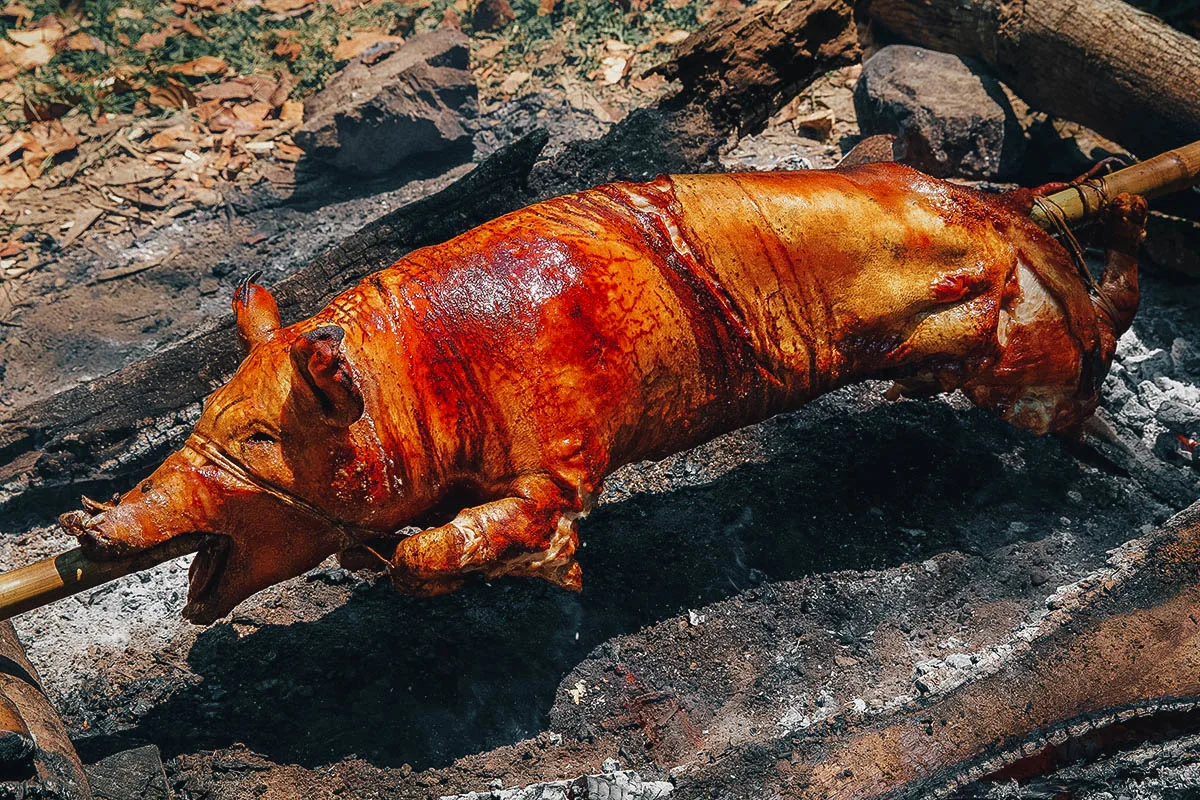
Photo by FrolovaElena
When Filipinos say “lechon”, they always mean roast pig. But lechon can also refer to other spit-roasted livestock like lechon manok (chicken, pictured below) and lechon baka (calf).
Lechon manok is available everywhere, usually from takeout kiosks, but lechon baka is a much more special type of lechon that’s reserved for truly special gatherings. It isn’t uncommon but you don’t see it nearly as often as roast pig.
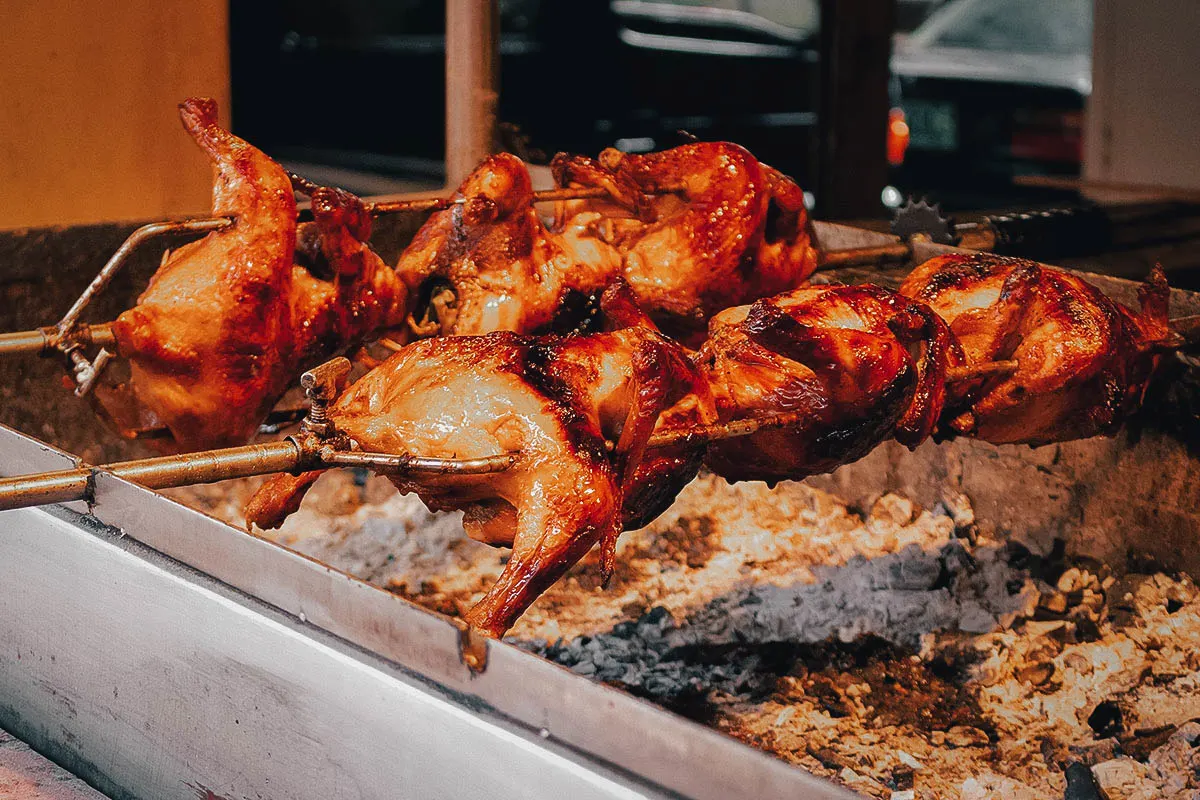
Photo by Al.geba
24. Tinola
Tinola is a popular Filipino soup dish made with chicken, wedges of unripe papaya, malunggay (moringa) and/or siling labuyo (bird’s eye chili) leaves. It’s usually made with chicken but it can be made with fish, seafood, or pork. Chayote or calabash can also be used as a substitute for green papaya.
Tinolang manok (chicken tinola) is classic Filipino comfort food that’s best paired with steamed rice and patis (fish sauce) as a condiment.
RECIPE: Tinolang manok (chicken)
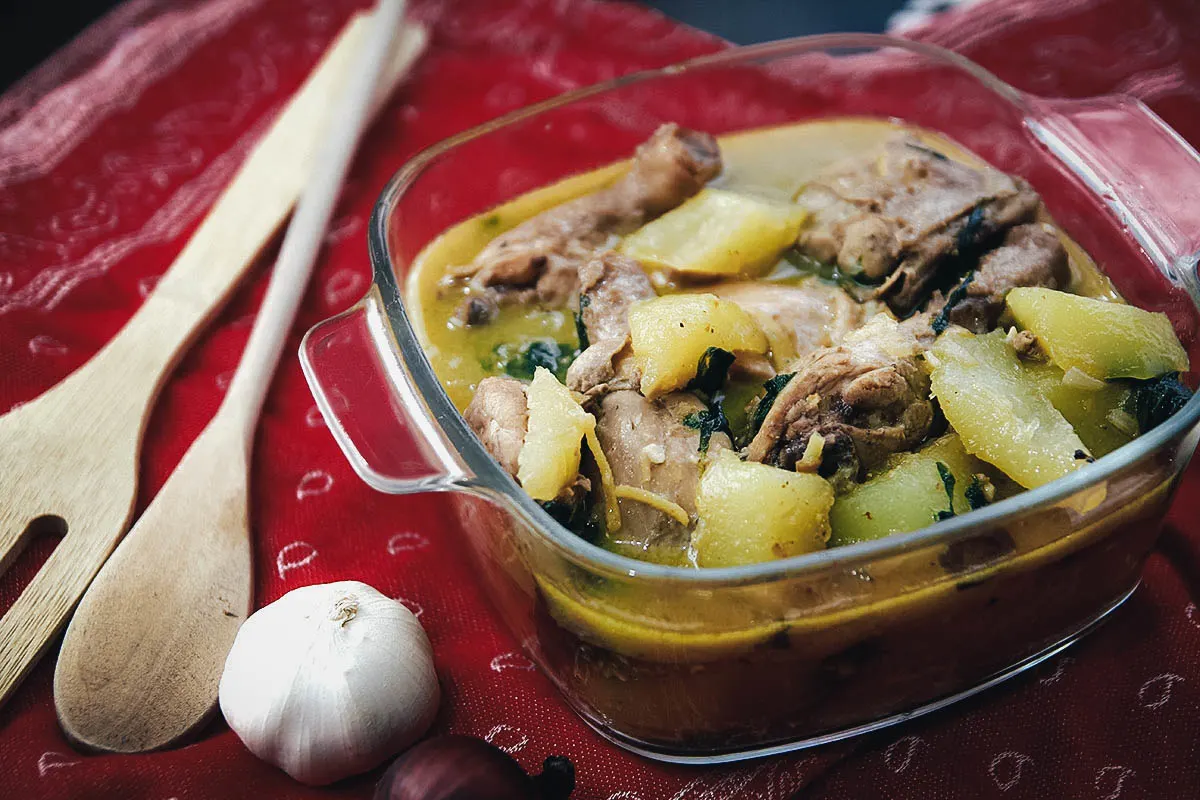
Photo by junpinzon
25. Inihaw na Liempo
Liempo is pork belly. It’s a popular dish that can be enjoyed with rice as an entree or as bar chow with beer. It’s usually served with a dipping sauce made with soy sauce and vinegar or vinegar with garlic and chili.
Technically speaking, liempo means just pork belly but when Filipinos say it, they usually mean inihaw na liempo or grilled liempo. Recipes vary but strips of pork belly are marinated overnight with garlic, chili, calamansi, and soy sauce before being grilled over charcoal.
RECIPE: Inihaw na liempo (grilled)
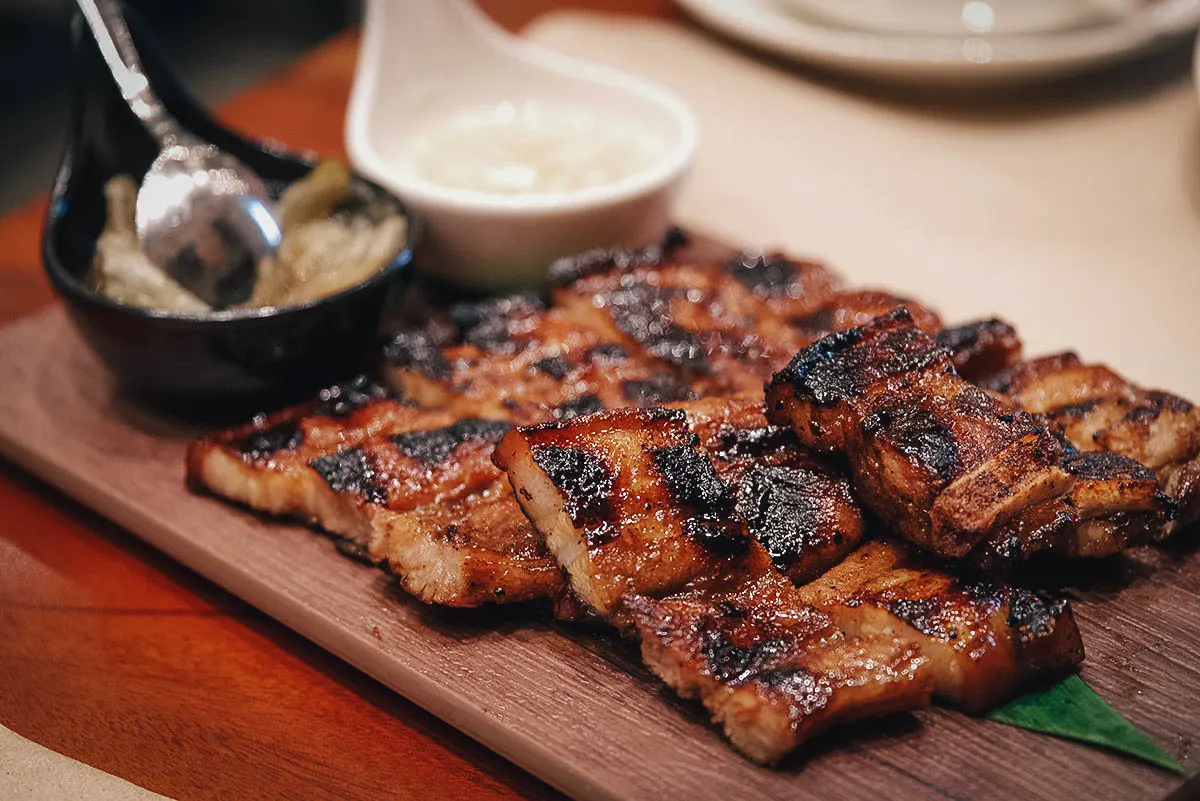
Photo by bugking88
26. Maskara
I don’t know if this qualifies as a traditional Filipino dish. It’s more of a novelty bar chow dish made with a boiled and deep-fried pig’s head. Maskara means “mask”.
The picture below is of a whole roasted pig’s head but maskara is deep-fried. To prepare, a pig’s head is split in half and boiled with herbs and spices to flavor and tenderize the meat. It’s then scored before being deep-fried to make it nice and crispy. Maskara is also referred to as crispy ulo (head).
I included maskara in this Filipino food guide because it isn’t a dish you can have just anywhere. Only a few places carry it so I suggest trying it if you can. Crunchy on the outside but moist and tender on the inside, it goes very well with beer.
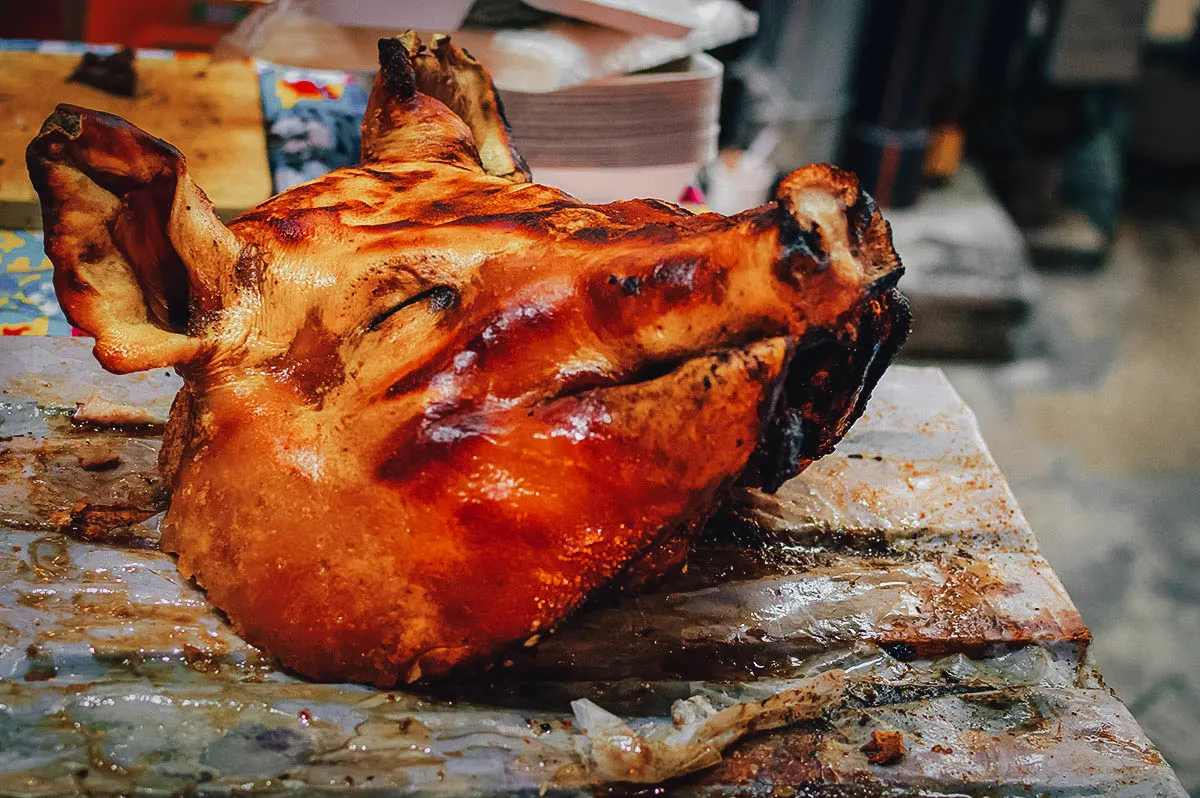
Photo by Rostovdriver
27. Kaldereta
Kaldereta (or caldereta) refers to goat meat stewed in tomato sauce. Like many Filipino dishes on this list, the term can refer to the dish or the cooking method. Kaldereta made with goat is called kalderetang kambing but it can be made with other proteins like beef, chicken, or pork as well.
To prepare, the goat meat is sauteed with garlic, onions, and tomatoes. It’s then stewed in tomato sauce with liver spread and different vegetables and root crops like tomatoes, bell peppers, carrots, and potatoes. Kaldereta is served as a main dish with steamed rice.
Kaldereta gets its name from the Spanish word caldera, meaning “cauldron”. It’s similar to Spanish meat stews and is another example of Spain’s influence on Filipino food.
RECIPE: Beef kaldereta
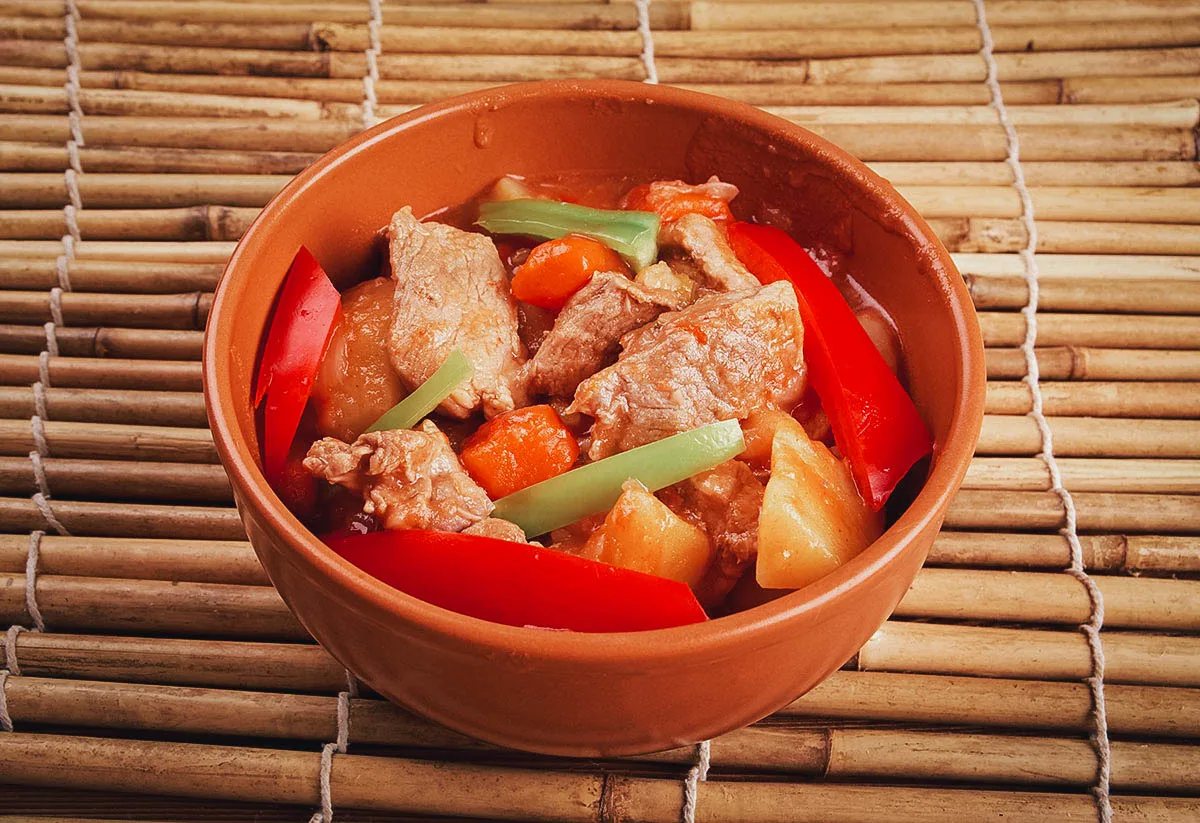
Photo by fanfon
28. Binagoongan
Binagoongan is another Filipino culinary term that can refer to both the dish and the cooking method. It refers to any meat or vegetable dish that’s sauteed or braised in bagoong alamang (shrimp paste). It’s usually made with pork but it can be made with chicken or beef as well.
As described, bagoong has a strong pungent flavor and aroma so binagoongan is always eaten with steamed rice. If you like robust flavors in your food, then you’ll probably enjoy binagoongan.
RECIPE: Pork binagoongan
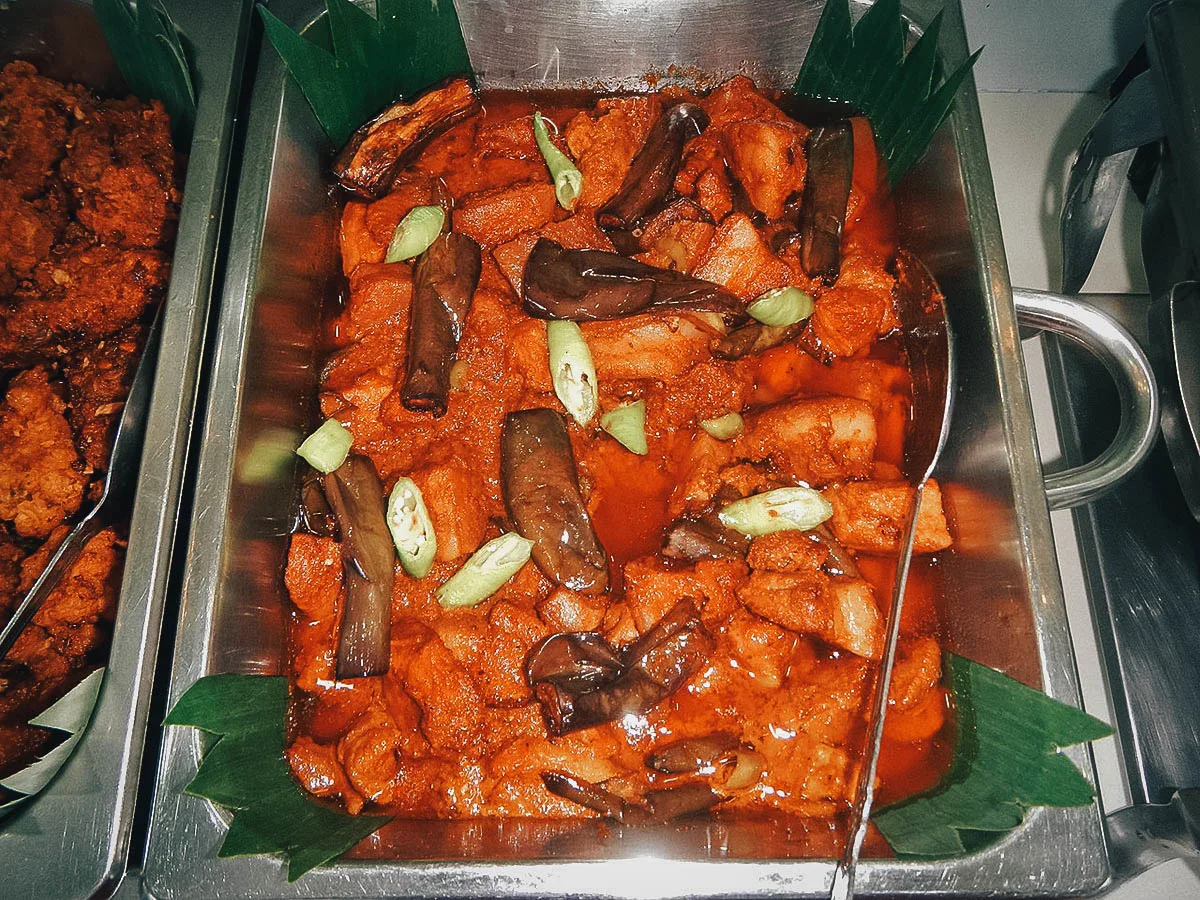
Judgefloro, CC0, via Wikimedia Commons / Processed in Photoshop and Lightroom
SEAFOOD
29. Tinapa
Tinapa is the Filipino term for smoked fish. It’s usually made with galunggong (blackfin scad) or bangus (milkfish) that are brined for several hours before being air-dried and smoked.
In the Philippines, tinapa is commonly eaten as breakfast fare with salted egg, tomatoes, and rice, but it can also be used in other Filipino dishes like lumpia and ginisang munggo (mung bean soup). It’s often used in pasta dishes as well.
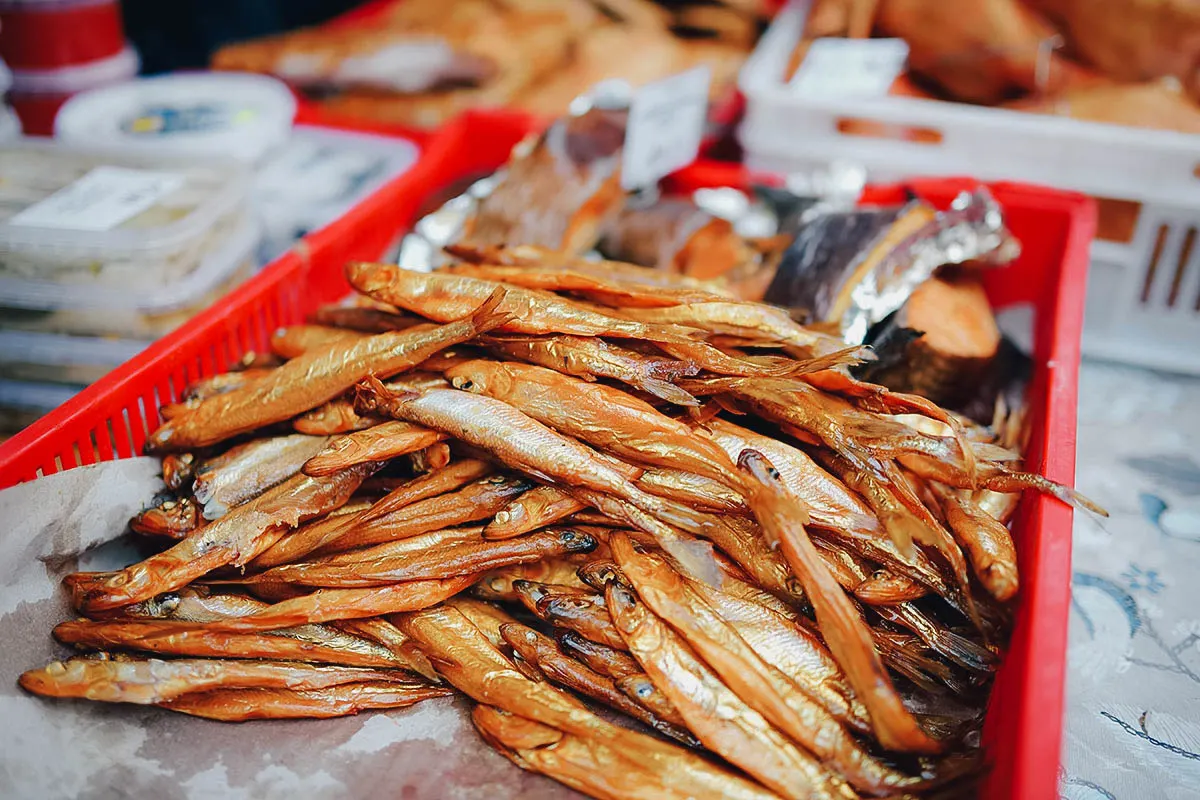
Photo by MNStudio
30. Paksiw
Paksiw refers to Filipino dishes cooked in vinegar and garlic. It means “to cook and simmer in vinegar” and can be used to describe both the dish and the cooking method. It’s a very common dish that’s enjoyed as an everyday meal throughout the Philippines.
Paksiw na isda (fish) is perhaps the most common type of paksiw but it can be made with pork as well. Paksiw na pata is made with pork trotters while paksiw na lechon is made with leftover lechon.
RECIPE: Paksiw na isda (fish)
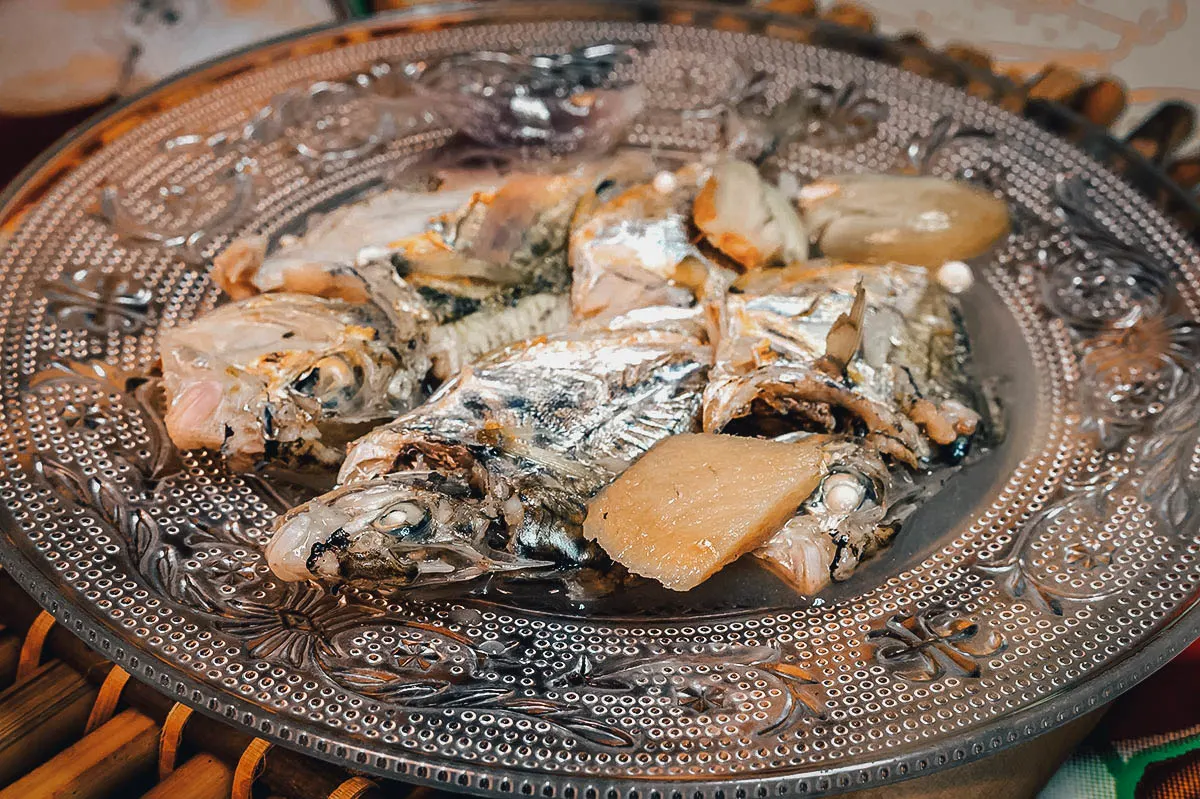
Photo by MikeEdwards
31. Kinilaw
Kinilaw is the Filipino version of ceviche. The term is used to refer to both the dish and preparation method that entails curing raw fish in vinegar and/or citric fruit juices. It’s usually made with fish like tanigue (wahoo), bangus, or tambakol (yellowfin tuna), though it can be made with other types of seafood as well like squid, shrimp, clam, and oyster.
To prepare, cubes of raw fish are mixed with vinegar and a souring agent like calamansi, kamias, or tamarind. It’s typically seasoned with ginger, onions, chili pepper, sugar, salt, and pepper before being served as an appetizer or as bar chow.
When you visit the Philippines, you may come across the term kilawin. Kinilaw and kilawin are sometimes used interchangeably but kilawin actually refers to a similar but different dish. Kilawin is prepared by marinating cooked meats like pork, goat, or beef in a vinegar mixture while kinilaw refers to raw fish cured in vinegar.
RECIPE: Kinilaw na tanigue (Spanish mackerel)
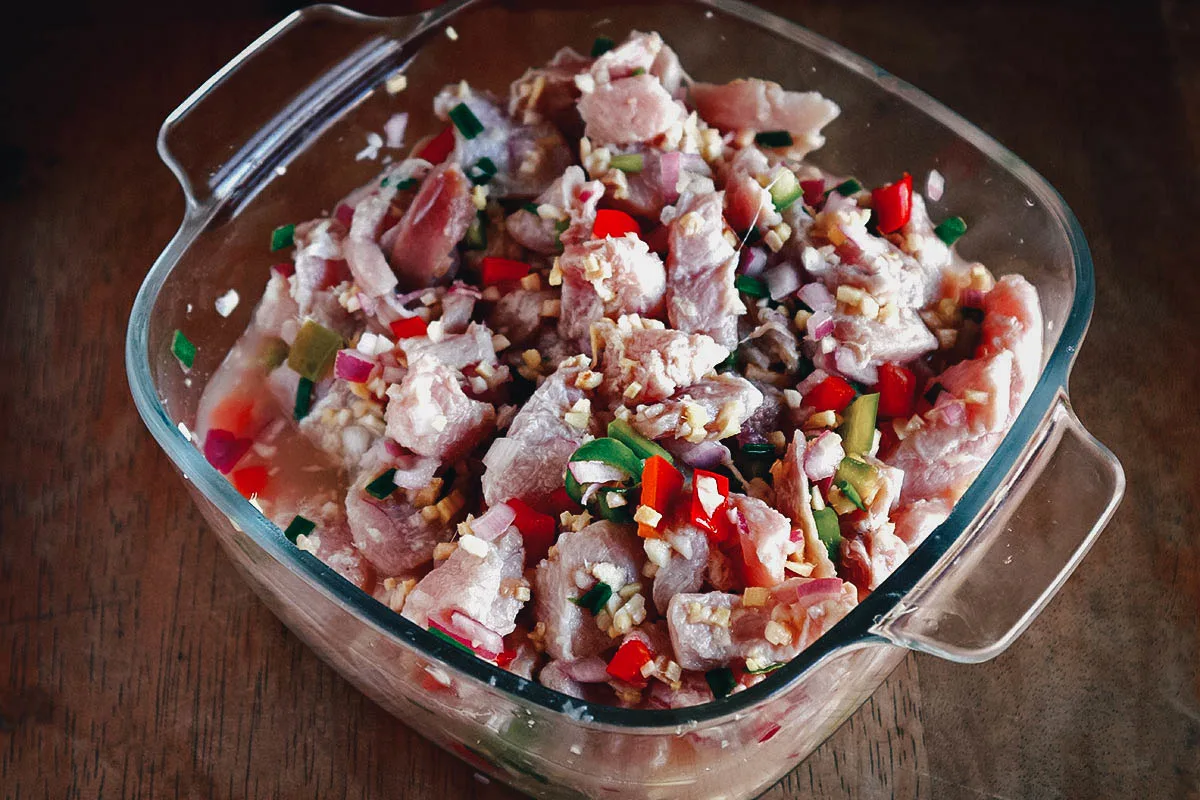
Photo by junpinzon
32. Bangus
Bangus refers to milkfish which is the national fish of the Philippines. As you can imagine, it’s a hugely popular fish used in many recipes in Filipino cuisine.
Pictured below is one of my favorite preparations for bangus. It’s called inihaw na bangus (grilled) and is prepared by stuffing the fish with chopped onions, tomatoes, ginger, and calamansi before grilling over charcoal. Other popular Filipino dishes made with bangus include sinigang, daing na bangus, paksiw, pesang bangus, totsong bangus, and rellenong bangus.
Bangus is one of my favorite fishes but it’s known to have many tiny thorn-like bones. They’re annoying and can make it a pain to eat but thankfully, pre-thorned versions sold as “boneless bangus” are common at supermarkets.
RECIPE: Inihaw na bangus (grilled)
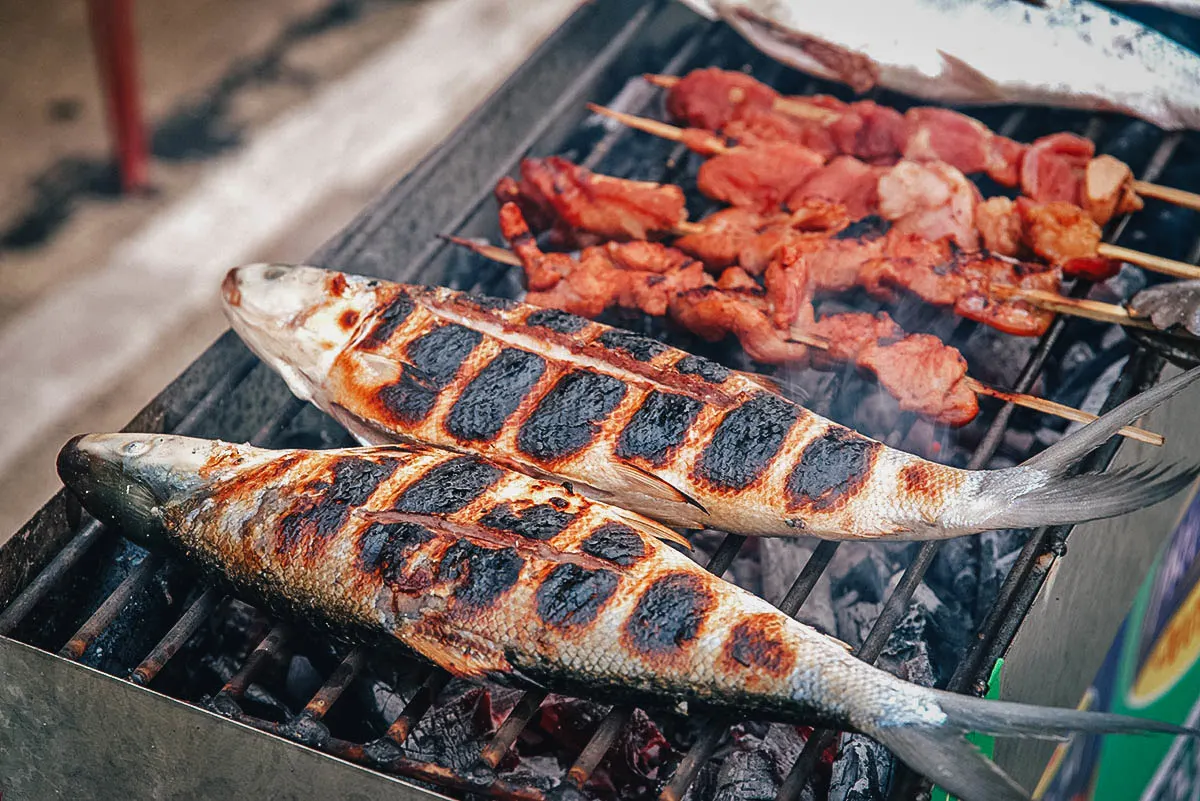
Photo by bugking88
RICE / NOODLES
33. Silog
Silog refers to a family of Filipino breakfast dishes made with some type of meat, garlic fried rice, and a fried egg. The dish takes the name of whatever meat it’s made with so silog made with tapa (cured beef) for example, is called tapsilog. Tapsilog is a portmanteau word for tapa (cured beef) + sinangag (garlic fried rice) + itlog (egg).
Tapsilog and its variants are among the most popular breakfast dishes in the Philippines. Like Malaysian nasi lemak, they’re typically eaten for breakfast but they can be enjoyed throughout the day. Personally, I love tapsilog though I prefer having it for lunch or dinner.
There are many types of silog like cornsilog (corned beef), bangsilog (bangus), spamsilog (SPAM), and hotsilog (hot dog), but the three most popular are tapsilog, longsilog (longganisa), and tocilog (tocino). No matter the type, silog meals are usually eaten with a vinegar dipping sauce.
Pitcured below is tapsilog. It’s made with fried or grilled cured beef and was the very first version of silog. Depending on the cook, it can be savory, a little sweet, or spicy. Tapsilog is so popular that you can find it pretty much anywhere – in Filipino homes, restaurants, hotels, and fast food chains.
RECIPE: Tapsilog
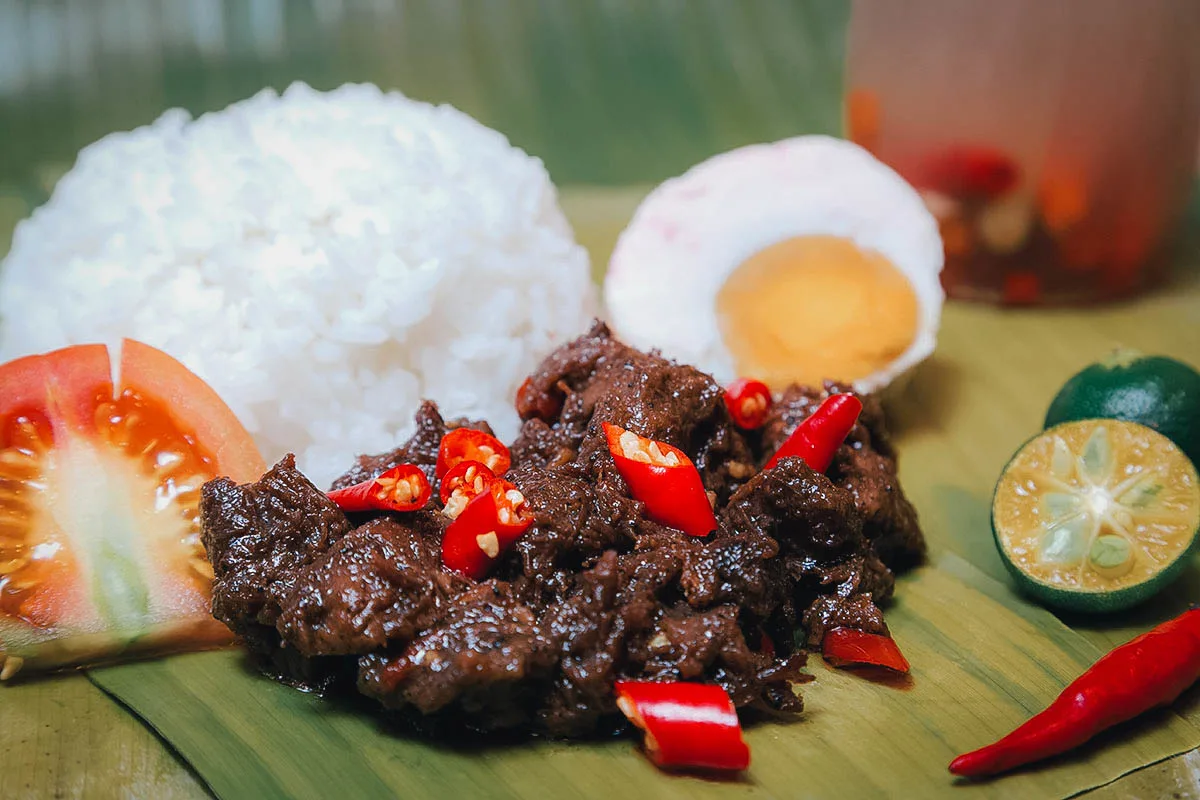
Photo by aldarinho
Longsilog is my favorite type of silog. It can be made with any type of longganisa but personally, I like it best with Vigan longganisa. Longsilog with Vigan longganisa is a strong contender for my hypothetical last meal.
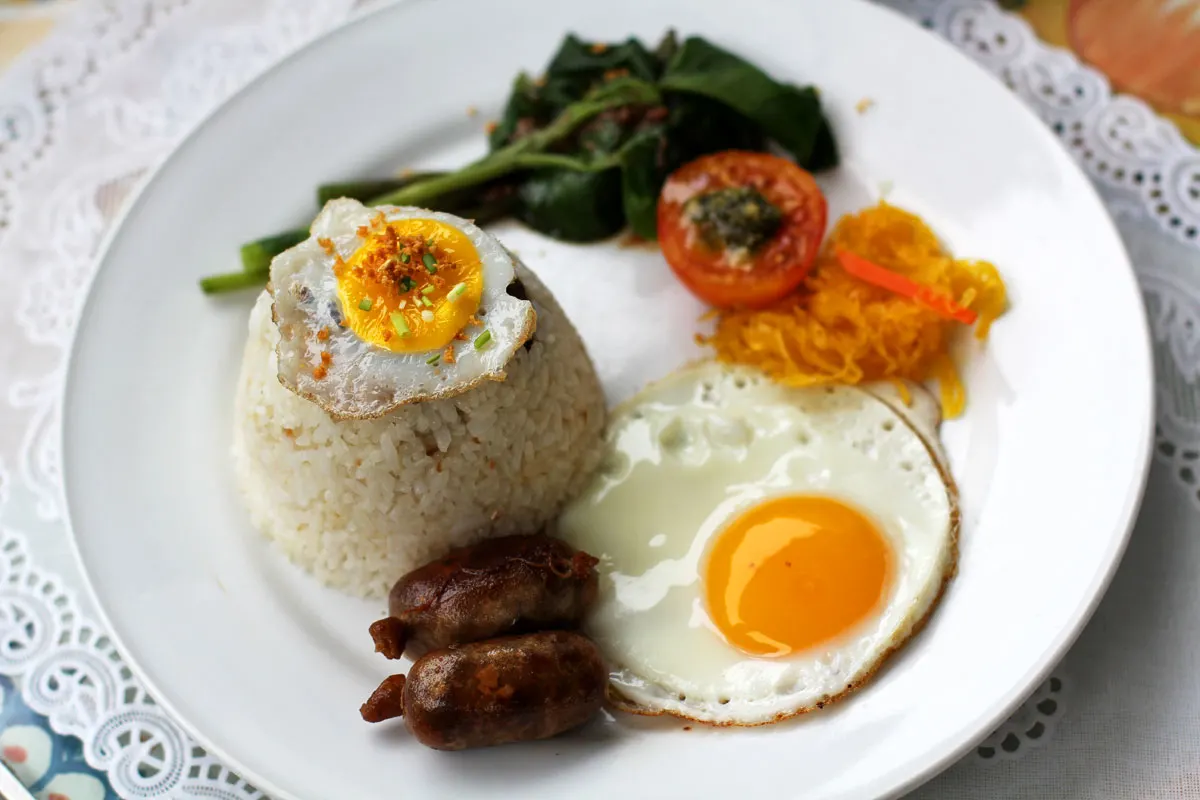
Tocino means “bacon” in Spanish and refers to sweetened and cured pork belly. Tocilog used to be my favorite type of silog when I was a kid because of the sweetness and tenderness of the meat.
Recipes vary but tocino is usually made by curing strips of pork belly (or shoulder, butt, or ham) for several days in a mixture made from salitre (saltpeter), sugar, salt, pepper, and garlic. The salitre acts as a curing agent and food preservative and gives the tocino its characteristic pinkish red color when cooked.
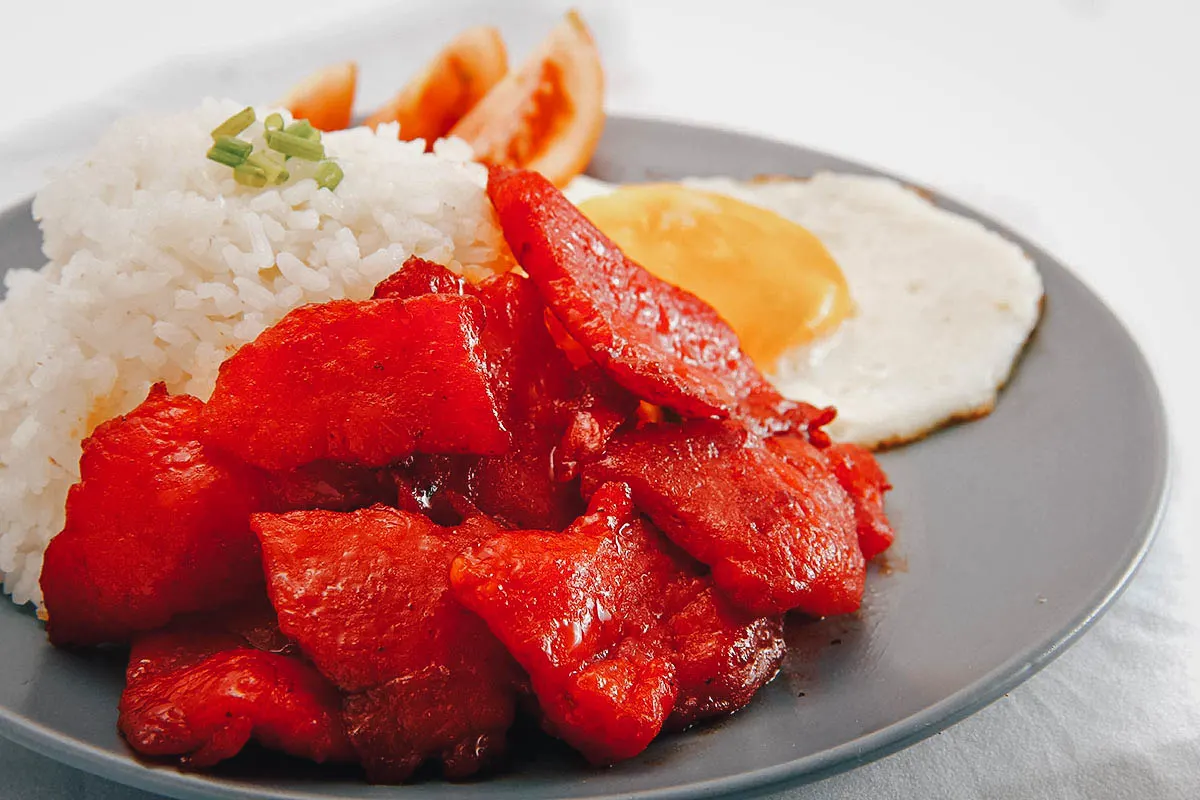
Photo by junpinzon
34. Pancit
Filipinos love rice but we also love pancit. It refers to a family of Chinese-inspired noodle dishes usually made with rice noodles, vegetables, meat, and seafood.
Pancit is often eaten during holidays and gatherings and is almost always consumed to celebrate someone’s birthday. This practice stems from the Chinese belief that noodles represent long life and good health. Despite pancit being a filling meal in itself, it’s rarely eaten on its own. Instead, it’s usually enjoyed as a side dish with rice and other viands.
There are many different versions of this beloved noodle dish in the Philippines. More often than not, when Filipinos say “pancit”, they’re usually referring to the dry verions of the dish but soupy versions of pancit do exist as well. Listed below are some of the most popular types of pancit in the Philippines.
Pancit Bihon Guisado (dry, pictured below) – Pancit made with bihon (rice vermicelli) stir-fried with soy sauce, calamansi, patis (fish sauce), vegetables, and meat.
Pancit Canton (dry) – This is basically the local version of Chinese lo mein. It’s made with egg noodles stir-fried with cabbage, carrots, green beans, mushrooms, and slices of pork. It’s usually seasoned with soy sauce or oyster sauce and drizzled with calamansi.
Pancit Palabok / Luglug (dry) – Pancit palabok and pancit luglug are basically the same dish. They’re both made with noodles covered in a thick shrimp sauce and topped with slivers of hard-boiled egg, chicharon bits, tinapa flakes, whole shrimp, and chopped green onion. The only difference is that palabok is made with bihon while luglug, a Kapampangan version of palabok, is made with thicker canton noodles.
Pancit Malabon (dry) – A type of pancit originally from Malabon City in Metro Manila. It’s made with thicker rice noodles topped with a yellowish-orange sauce flavored by achuete seeds, shrimp broth, patis (fish sauce), and aligue (crab fat). It’s typically garnished with slivers of hard-boiled egg, chicharon bits, toasted garlic bits, cabbage, tinapa flakes, and different types of seafood.
Pancit Habhab (dry) – Originally from Lucban in Quezon province, pancit habhab is an interesting type of pancit made with stir-fried egg noodles. It’s traditionally served on a banana leaf without utensils so you’re expected to slurp up the noodles directly into your mouth.
Pancit Lomi (wet) – A favorite in Batagnas province, pancit lomi is made with thicker and chewier egg noodles served in a thick soup with vegetables, kikiam (Filipino version of lor bak), shrimp, and pork.
Pancit Mami (wet) – You can think of pancit mami as the local version of chicken noodle soup. It’s made with egg or wheat flour noodles served in a broth flavored by beef and chicken bones. It’s usually served with cabbage, hard-boiled egg, shredded chicken or beef, and wontons.
RECIPE: Chicken pancit
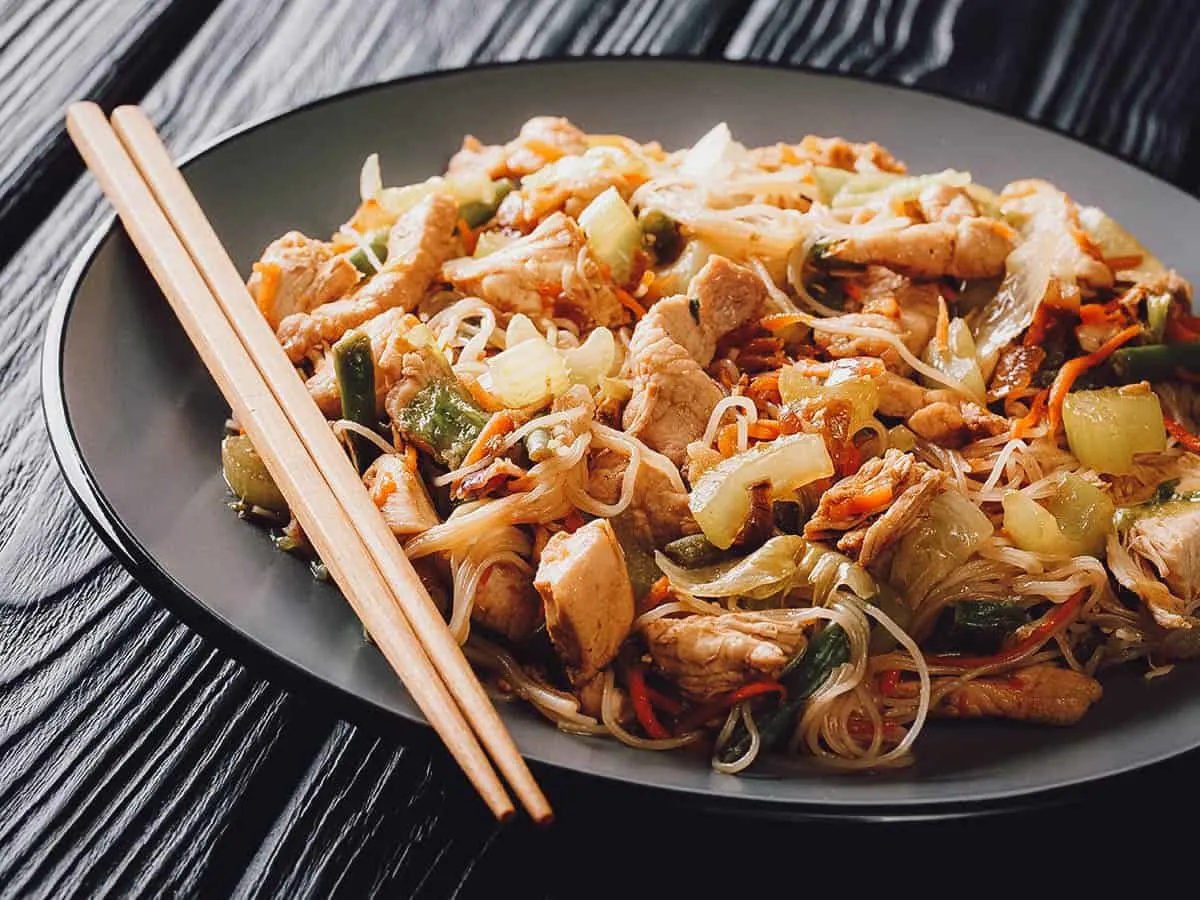
Photo by AS Food studio via Shutterstock
35. Batchoy
Batchoy refers to a Filipino noodle soup dish made with egg noodles in a broth flavored with pork and beef stock and shrimp paste. It’s usually served with pork innards, chicharon bits, pork slices, and pork liver. Batchoy is the prized dish of La Paz in Iloilo City and is often referred to as La Paz batchoy.
Personally, I think La Paz batchoy is one of the best noodle soup dishes you can have in the Philippines. It’s so tasty. Before serving, it’s often topped with fried minced garlic and a raw egg that you mix into the soup.
I’ve never tried it but it’s worth noting that you may encounter another type of batchoy in the Philippines called batchoy tagalog. It’s made with misua noodles, pork slices, pork innards, and chili pepper leaves in a ginger-based broth.
RECIPE: Batchoy
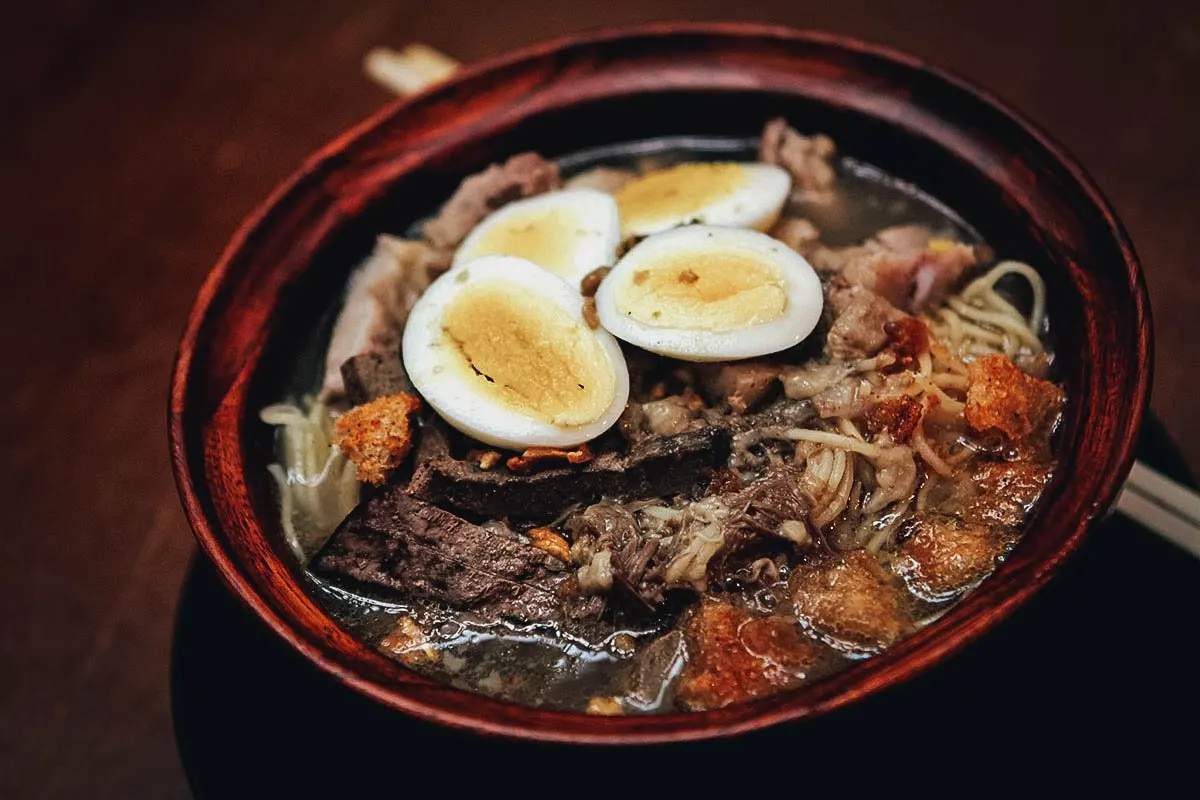
La Pa Batchoy by pulaw, used under CC BY 2.0 / Processed in Photoshop and Lightroom
36. Lugaw
Lugaw refers to Filipino rice porridge. It’s made with boiled glutinous rice seasoned with salt, garlic, and ginger.
When served as is, it’s known simply as “lugaw”. When served with beef and pork offal like tripe and intestines, it’s called “goto” (pictured below). When served with chicken, it’s referred to as “arroz caldo”. It’s a beloved Filipino comfort food that’s typically eaten for breakfast or on cold rainy days, usually with a side of tokwa’t baboy.
It’s interesting to note that there are sweet versions of lugaw, one of the most well-known being champorado. It’s a type of lugaw made with chocolate and milk. It can be eaten as is or paired with tuyo (dried fish).
RECIPE: Lugaw
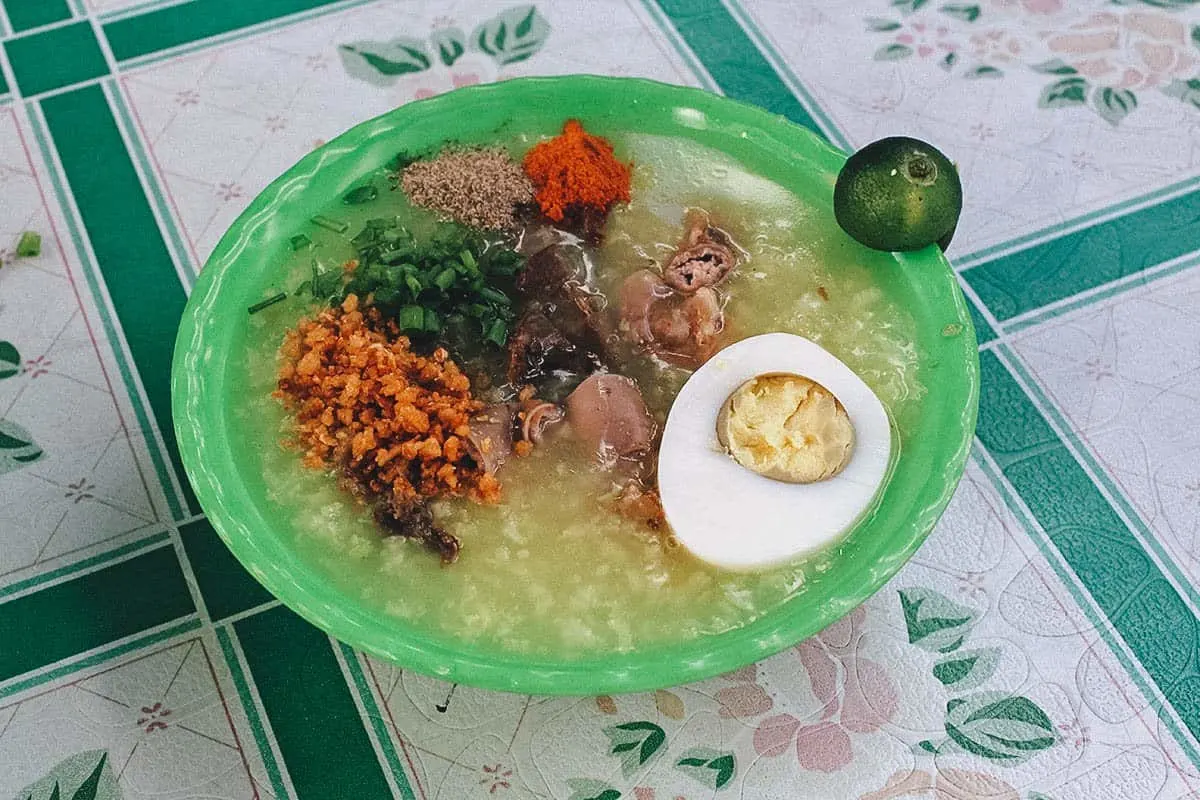
DESSERTS
For more sweet treats, be sure to check out our guide on the most delicious Filipino desserts.
37. Kakanin
Kakanin is one of my favorite dishes, or family of dishes, in Filipino cuisine. It’s the umbrella term used to describe an entire range of desserts or snacks made with galapong or glutinous rice paste. The term kakanin is derived from the word “kanin”, which means “rice”. You can think of it as the local version of Indonesian or Malaysian kuih.
I like kakanin because it’s colorful and often associated with Filipino festivals and holidays. You can find them all throughout the Philippines in many shapes, sizes, colors, and forms. Many are difficult to make which is why they’re usually reserved for special occasions or celebrations.
There are dozens of varieties of kakanin in the Philippines, but some of the most well-known and popular include puto, suman, bibingka, kutsinta, biko, espasol, and palitaw. I’ll talk about a few of them in more detail below.
Pictured below is puto, arguably the most common type of kakanin. This bite-sized steamed rice cake is usually white (putong puti) but it can be colored to indicate what it was flavored with. For example, puto made with ube (putong ube) is a deep purple while puto made with pandan (putong pandan) is green. The puto below is made with cheese (putong queso) hence the yellowish tinge.
Kakanin is a broad enough term but puto alone has many variants. Other than the types already mentioned, some of the most popular varieties of puto include puto bumbong, puto maya, putong pula, and puto kutsinta. Puto can be eaten on its own or paired with savory dishes like dinuguan.
RECIPE: Cheese puto
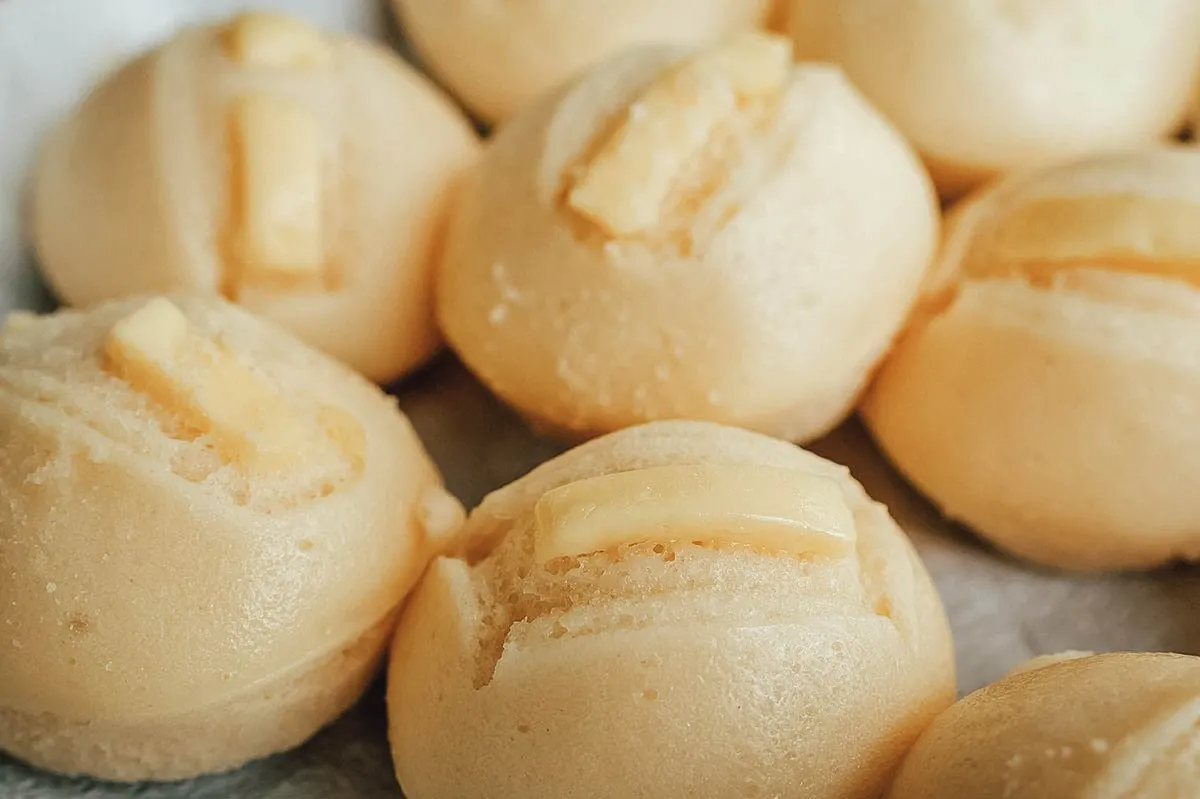
Photo by MikeEdwards
This was my favorite type of kakanin growing up. It’s a type of puto called kutsinta, which is frequently sold with putong puti and eaten with grated coconut.
Although it looks quite different, it’s similar to putong puti except it’s made with lye which gives it a chewier, stickier texture. It gets its orange color from food coloring or achuete seeds.
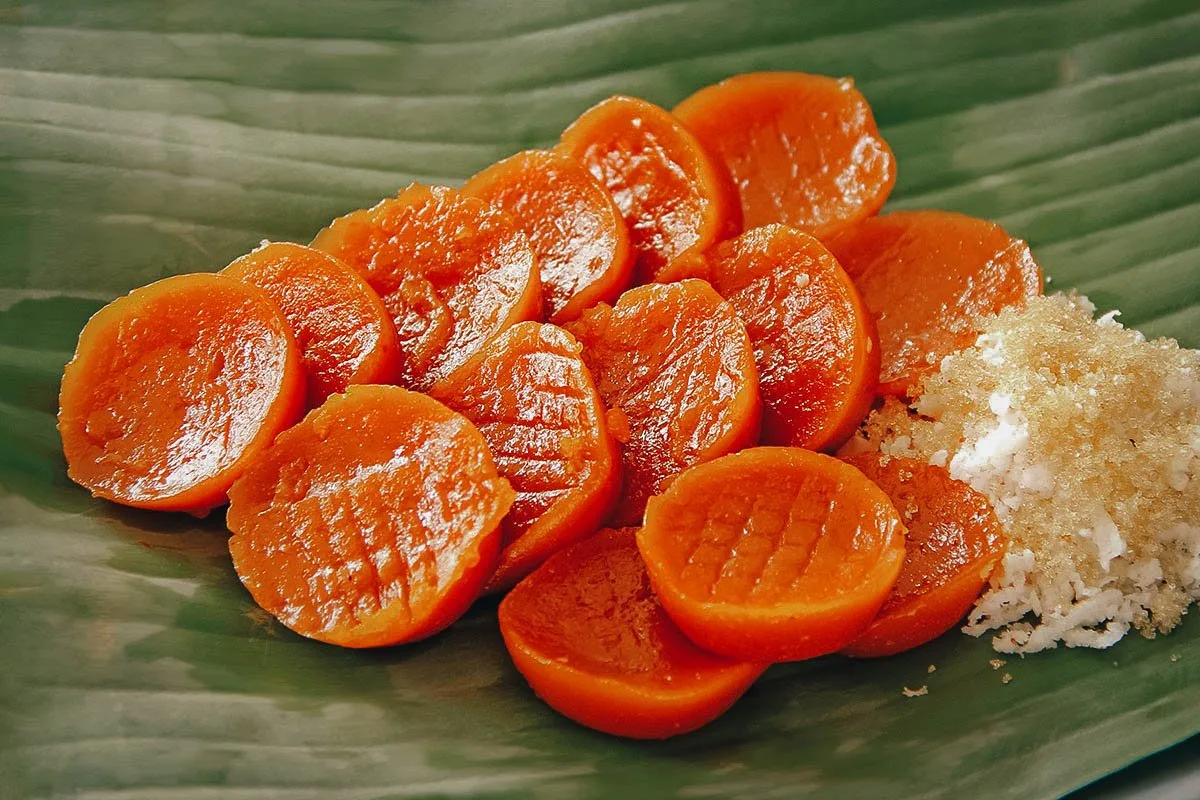
Photo by inotm5
Like puto, suman is one of the most popular and widely available types of kakanin. It’s made with glutinous rice cooked in coconut milk, which is then wrapped tightly in banana leaves before being steamed. It’s usually eaten with a sprinkling of sugar on top or drizzled with latik, which is a type of caramelized syrup made with coconut cream.
Suman is an important dish in Filipino cuisine and culture so you’ll find different varieties throughout the country. I’m only familiar with the basic kinds (suman malagkit) but explore the Philippines and you’ll find more exotic suman made with ingredients like black rice, chocolate, and pinipig (toasted and pounded immature glutinous rice).
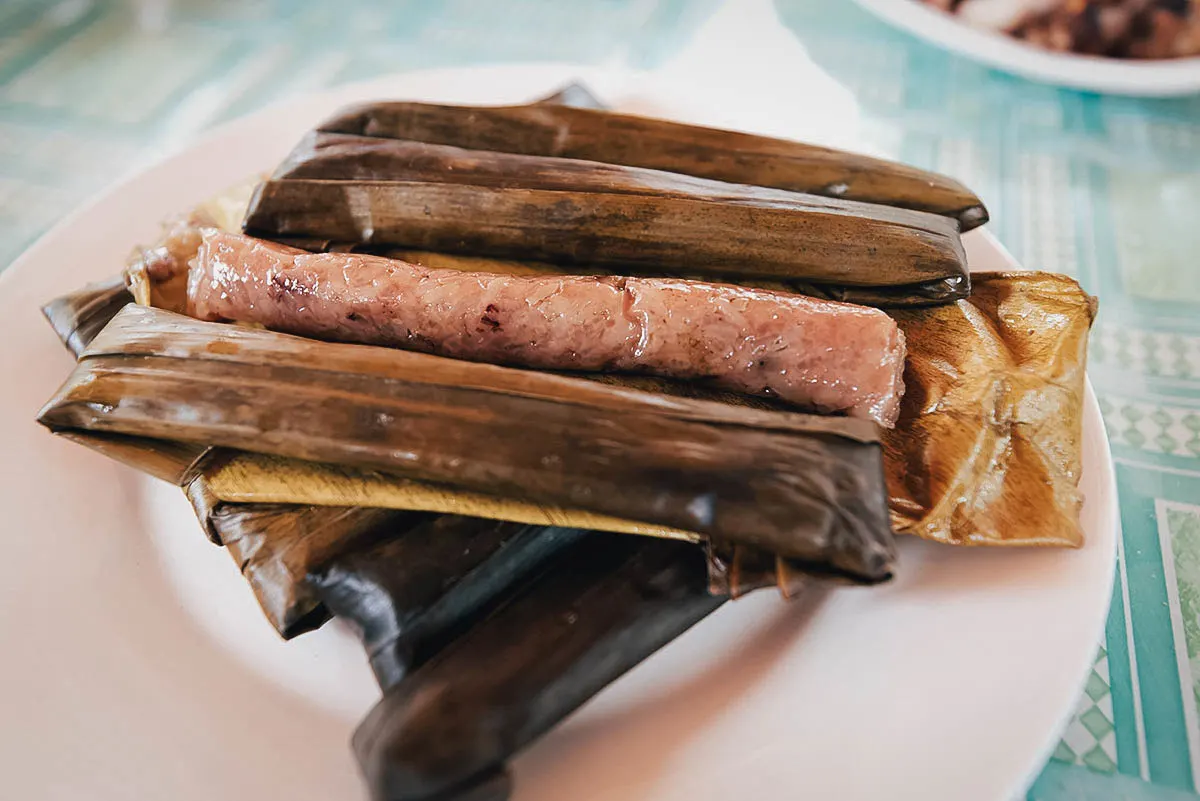
Photo by bugking88
Sapin-sapin is one of the more eye-catching types of kakanin. Its name means “layered” in Filipino and is in reference to the brightly-colored layers that make up the dish.
Lesser versions will be made with food coloring to achieve the layers, but quality sapin-sapin will be flavored with things like ube, langka (jackfruit), and pureed corn. It’s usually drizzled with latik and sprinkled with toasted desiccated coconut flakes before serving.
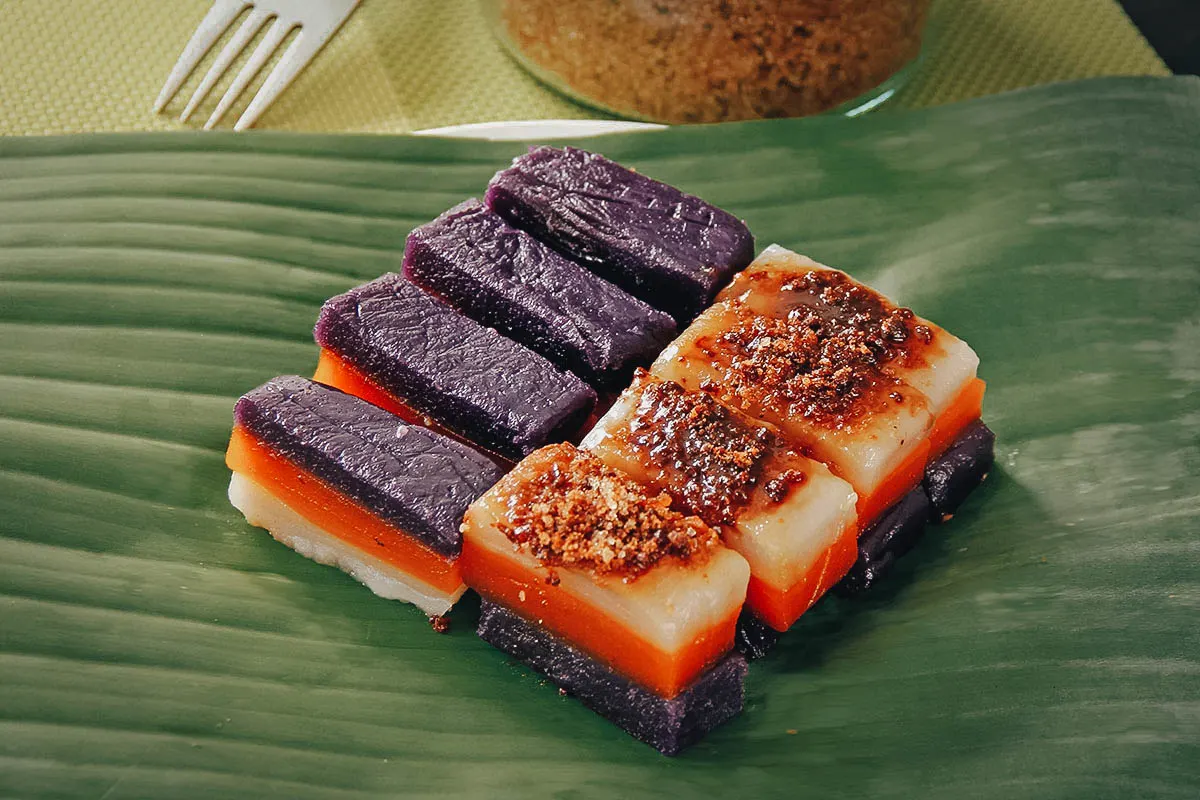
Photo by inotm5
Puto bumbong is one of the prettiest and most festive types of kakanin. It’s a variant of puto that’s steamed in bamboo tubes and typically eaten only around the Christmas season.
Because of its rich purple color, some people may think that puto bumbong is made with ube but it isn’t. It gets its color from a unique heirloom variety of glutinous rice called pirurutong. It’s naturally a deep purple to almost black in color.
Puto bumbong is traditionally served on banana leaves and slathered with butter or margarine before being topped with muscovado sugar and grated coconut. It’s a special dish for many Filipinos because of its association with Christmas.
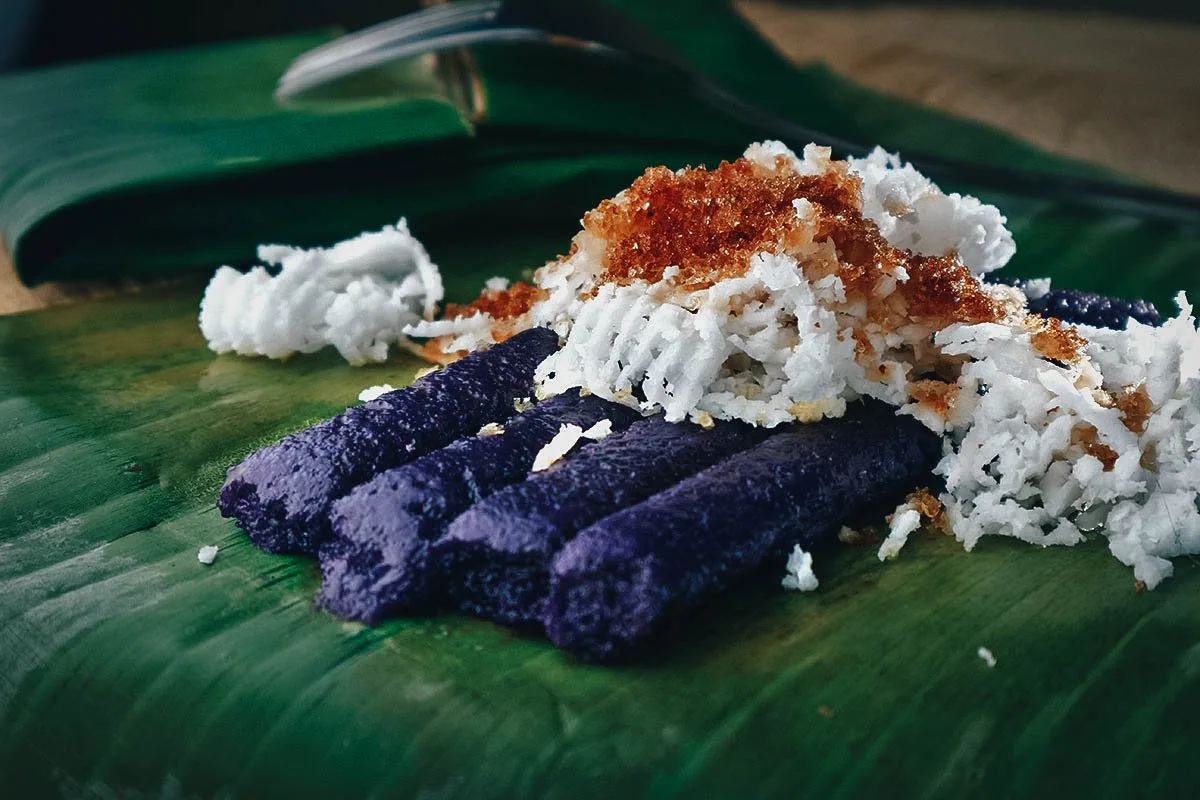
Photo by junpinzon
Bibingka is a different type of kakanin from the previous dishes because it’s baked instead of steamed. A clay pot is lined with banana leaf before being filled with the glutinous rice paste and cooked between two layers of pre-heated charcoal.
Like puto bumbong, it’s special to many Filipinos because it’s usually eaten during the Christmas season. It’s topped with butter or margarine, sugar, cheese, or grated coconut. My favorite versions are made with salted duck egg.
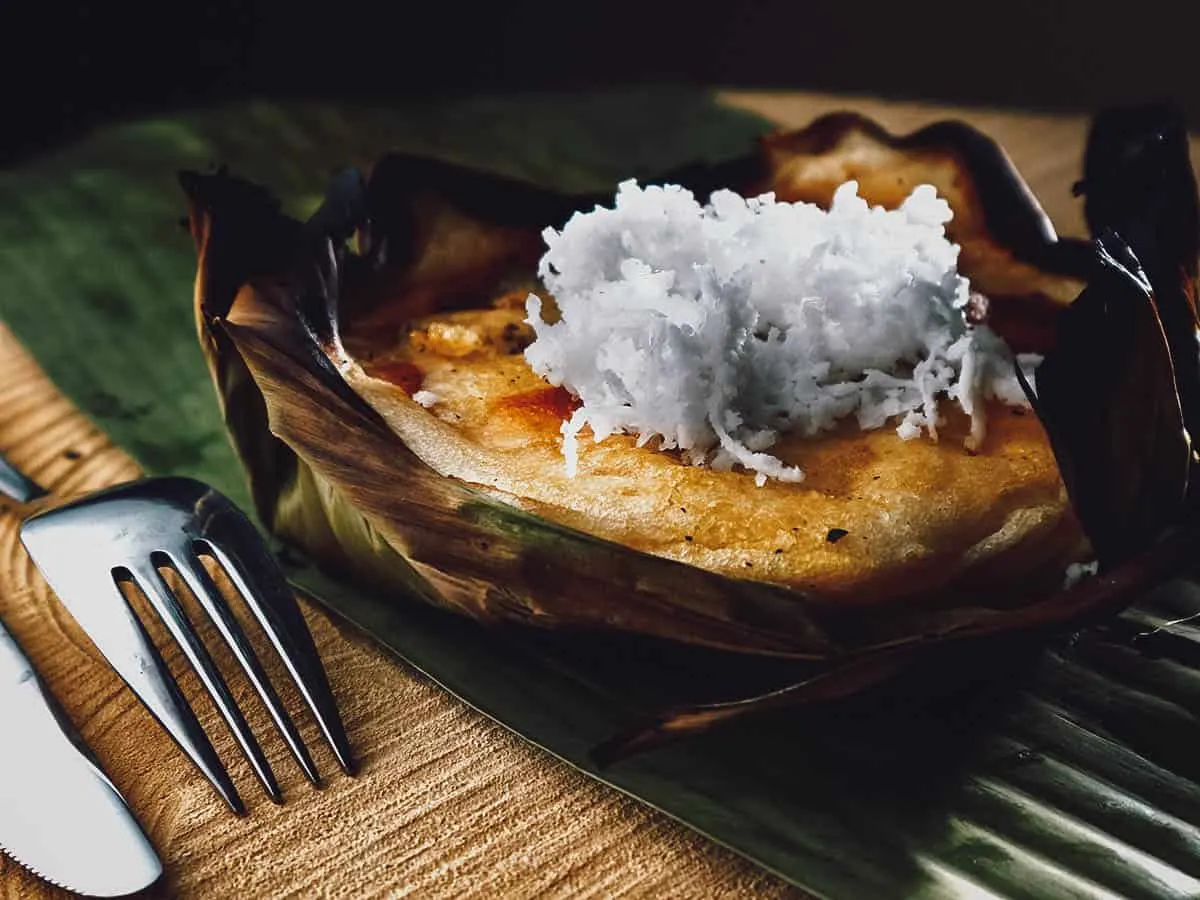
Photo by junpinzon via Shutterstock
38. Taho
Taho is a famous Filipino dish that conjures fond childhood memories for many Filipinos. It’s the Filipino version of douhua, a Chinese snack of fresh silken tofu that’s served in many parts of Asia. What makes taho uniquely Filipino is that it’s served with arnibal (simple syrup) and sago pearls (similar to tapioca).
Filipinos from suburban areas of the Philippines grew up with taho. Everyday, either early in the morning or later in the afternoon, the taho vendor would call out “tahooooo!” as he went through the neighborhood with two aluminum buckets on either side of a bamboo pole. One bucket had the silken tofu while the other carried the arnibal and sago. He’d walk down your street at roughly the same time everyday so it became part of our daily routine to eat taho.
Classic taho is made with arnibal and sago but these days, you can find versions topped with boba and made with flavored syrups like strawberry and ube.
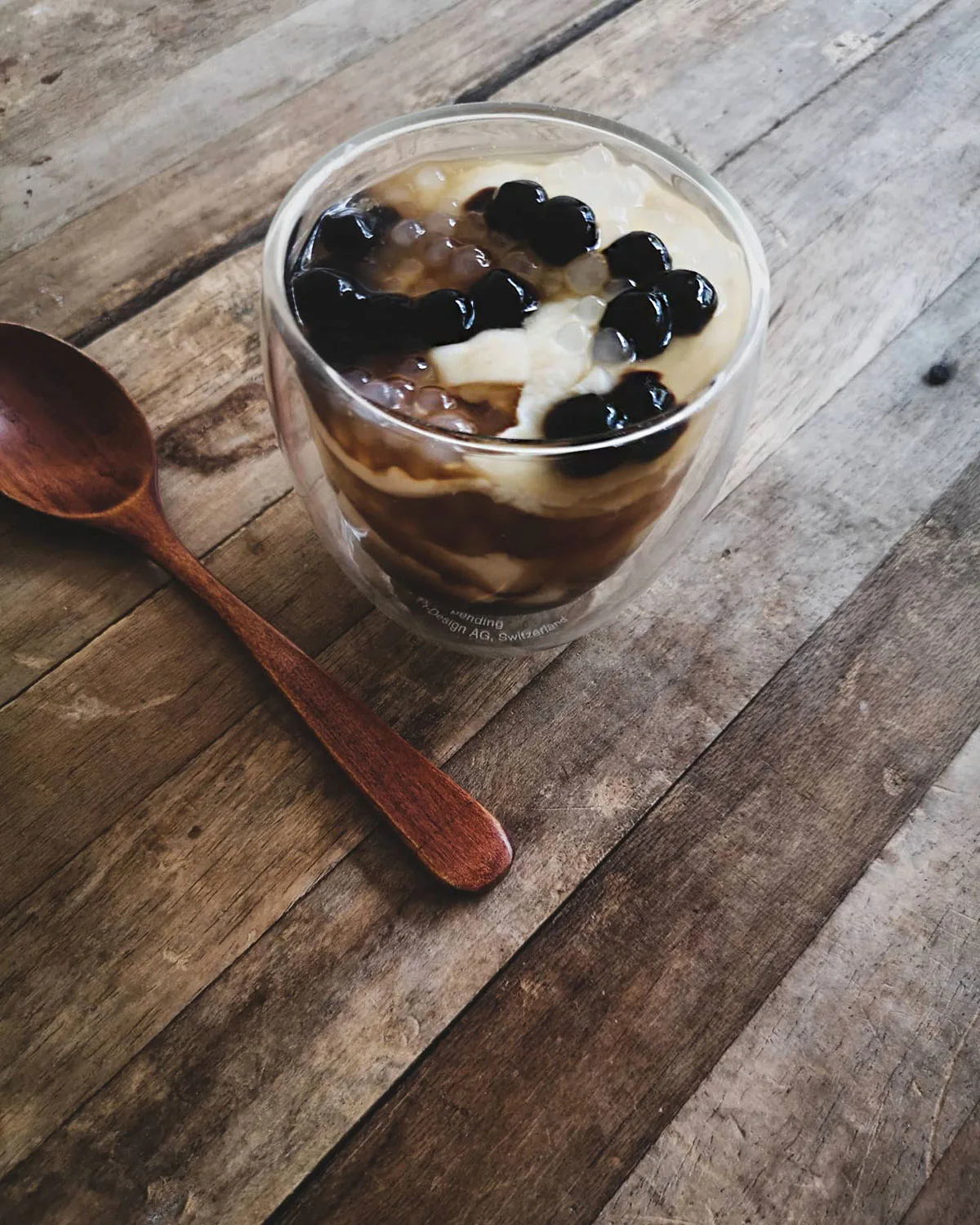
39. Ensaymada
The ensaymada is a Spanish pastry that’s become a staple food in the Philippines. Originally from Mallorca, it derives its name from the root word “saim” which means “pork lard”. Spanish ensaimada is made with lard but what makes the Filipino version unique is that it’s made with butter instead.
Filipino ensaymada is made with brioche bread baked with butter and topped with buttercream and grated cheese, usually queso de bola (edam). It has ties to the Christmas season, where people often give boxes of special ensaymada as gifts, but it’s widely available and consumed throughout the year.
RECIPE: Ensaymada
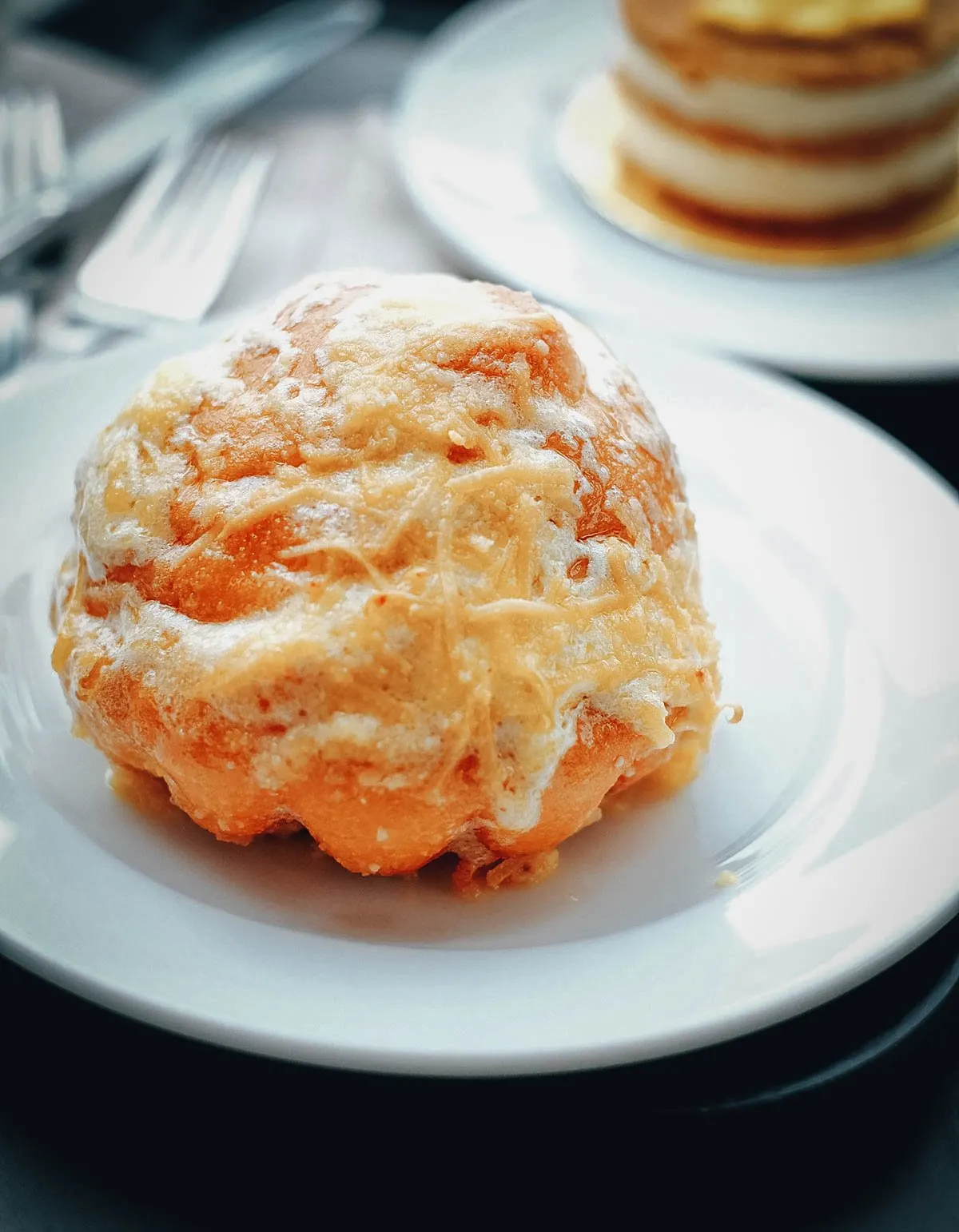
Photo by nuitgarden
40. Sans Rival
Sans rival is one of the more unique cakes or pastries in the Philippines. It consists of three layers of cashew nut meringue held together with buttercream. Once assembled, it’s coated with more buttercream and topped with chopped cashews. It’s then kept in the freezer before serving to give it a uniquely crunchy texture.
Based on what I’ve read, sans rival is a type of French dacquoise that makes use of cashews instead of almonds and hazelnuts. It’s said to have become a part of Filipino cuisine in the late 19th or early 20th century, when many Fiipinos traveled to France and brought cooking techniques back with them.
RECIPE: Sans rival
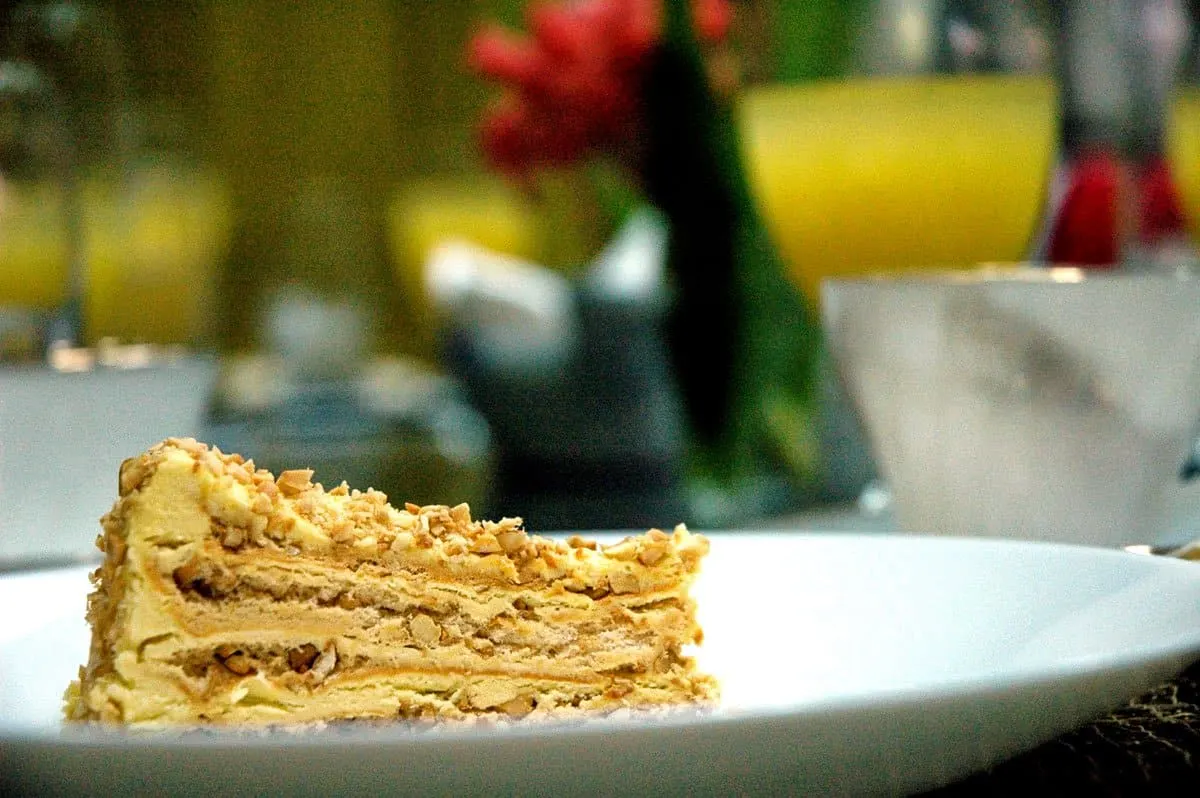
Photo borrowed with permission from Dude for Food
41. Halo-Halo
Halo-halo is perhaps the most beloved and internationally recognizable dessert in this Filipino food guide. The term halo-halo means “mixed” and refers to a crushed ice dessert made with evaporated or condensed milk and a spectrum of ingredients like sweetened beans, ube, coconut strips, kaong (sugar palm fruit), macapuno (young coconut), leche flan, and plantains sweetened with sugar, among many others.
Halo-halo is often served in a tall parfait glass so you can easily see the multi-colored layers of ingredients. To assemble, the different ingredients are layered in the glass before being covered with crushed ice and topped with leche flan and/or ube (either halaya or ice cream). Evaporated or condesned milk is then poured into the glass of halo-halo before serving.
There’s no predetermined set of ingredients in halo-halo so you’ll find different ingredient combinations from restaurant to restaurant. For many Filipinos, the more colorful the halo-halo, then the better it is.
RECIPE: Halo-halo
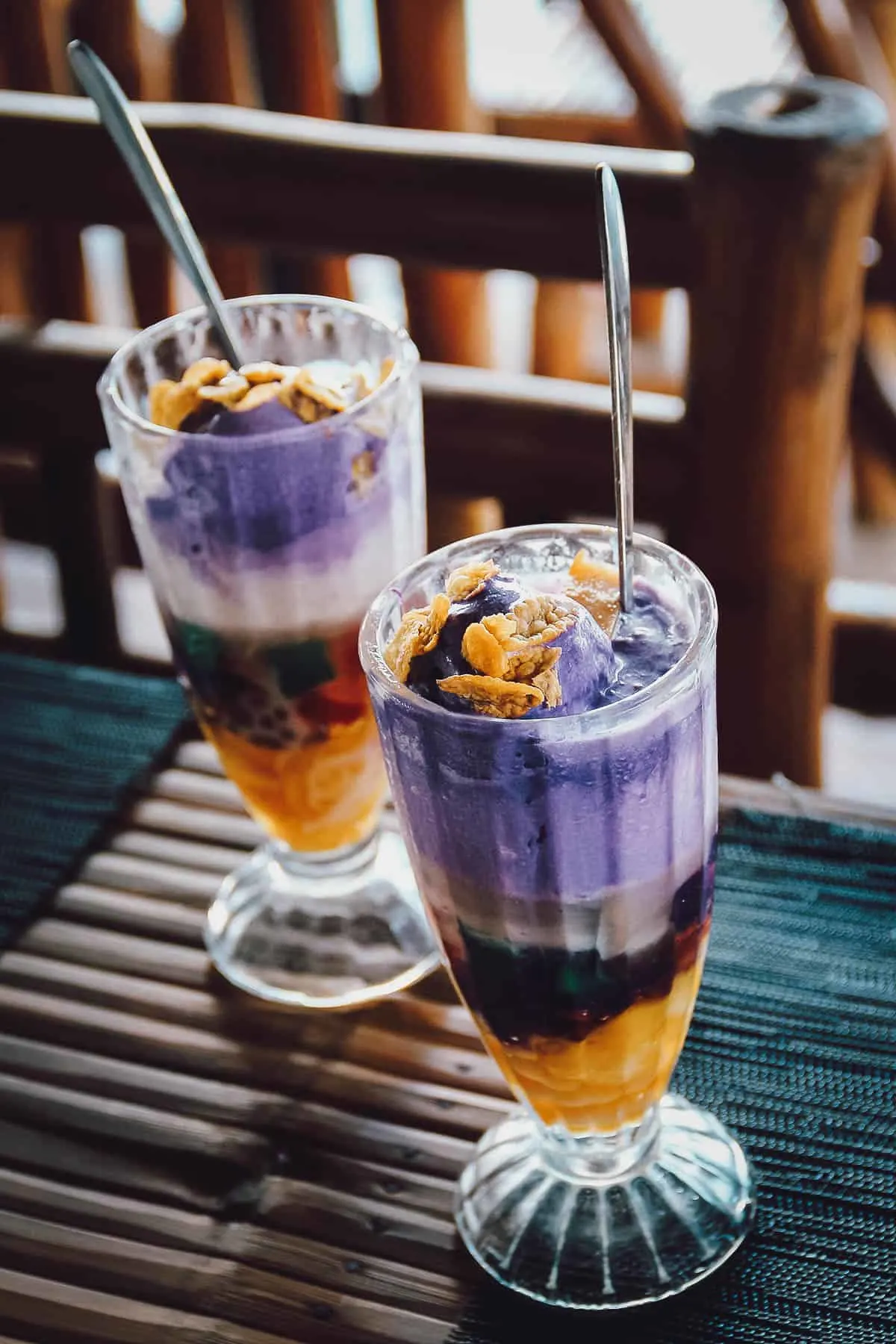
Photo by Kayea29 via Shutterstock
42. Ginataan
The term ginataan actually refers to a whole range of dishes cooked with gata or coconut milk. Ginataan dishes can be both savory and sweet. Because they’re made with coconut milk, laing and Bicol express are types of ginataan.
In our household, and I believe in many parts of the northern Philippines, when someone says “ginataan”, they’re often referring to sweet ginataan . If you wanted to refer to a savory ginataan, then you’d call it by its complete name like ginataang kuhol (snail), ginataag gulay (vegetables), or ginataang manok (chicken).
The sweet version of ginataan consists of a soup thickened with coconut milk and filled with various ingredients like langka (jackfruit), saging na saba (plantains), tubers, and sago pearls. It’s traditionally eaten hot though it can be enjoyed cold from the refrigerator as well. My favorite type of ginataan is also made with sticky glutinous rice balls called bilo-bilo.
It’s worth noting that there are other common types of sweet ginataan as well, like ginataang mais (sweet corn and glutinous rice), ginataang munggo (mung beans), and ginataang saba (plantains).
RECIPE: Ginataang halo-halo
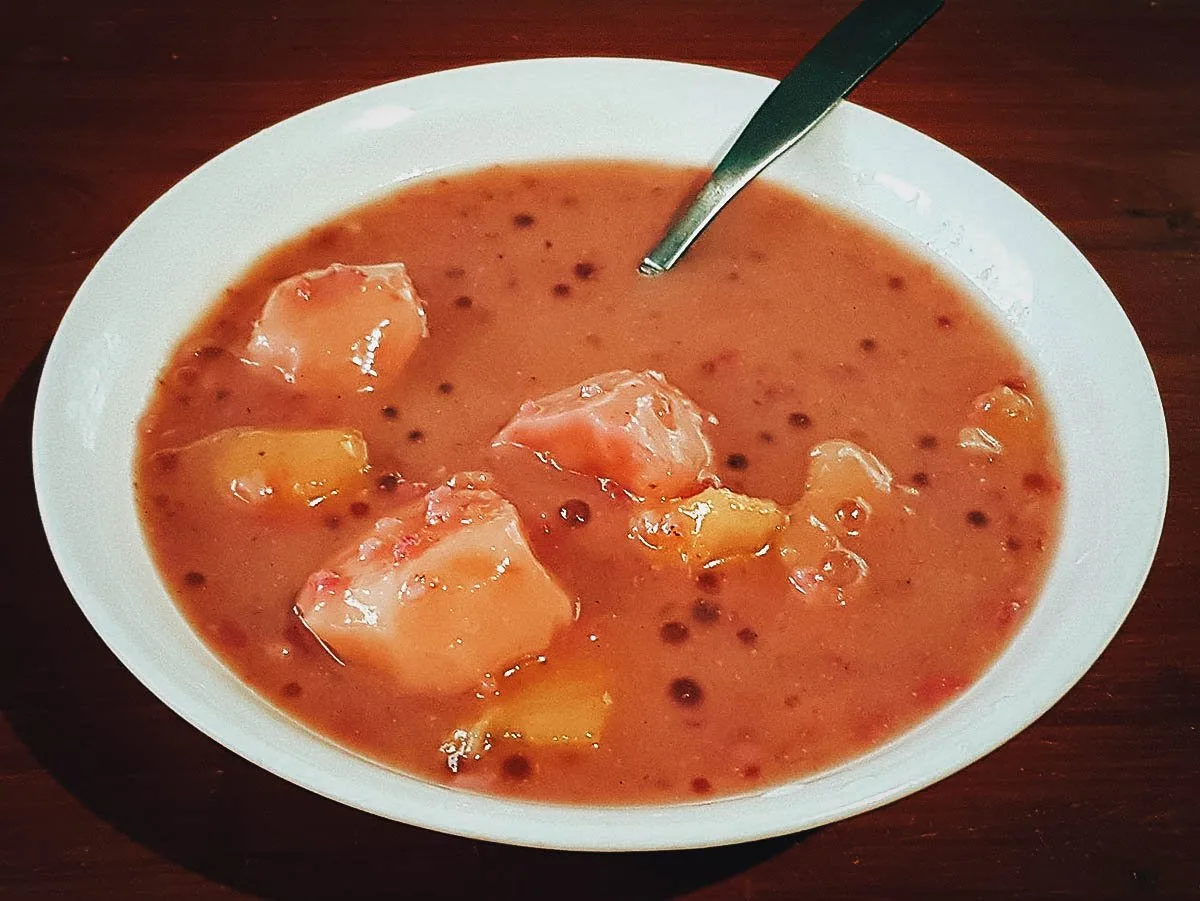
Obsidian Soul, CC0, via Wikimedia Commons / Processed in Photoshop and Lightroom
43. Leche Flan
Leche flan has always been one of my favorite Filipino desserts. It’s the Filipino version of creme caramel made with condensed milk and plenty of egg yolks.
As you can see in the picture below, leche flan usually comes in an oval shape because it’s traditionally steamed in a tin mold called a llanera. It’s a hugely popular dessert that’s often served at many family gatherings.
RECIPE: Leche flan
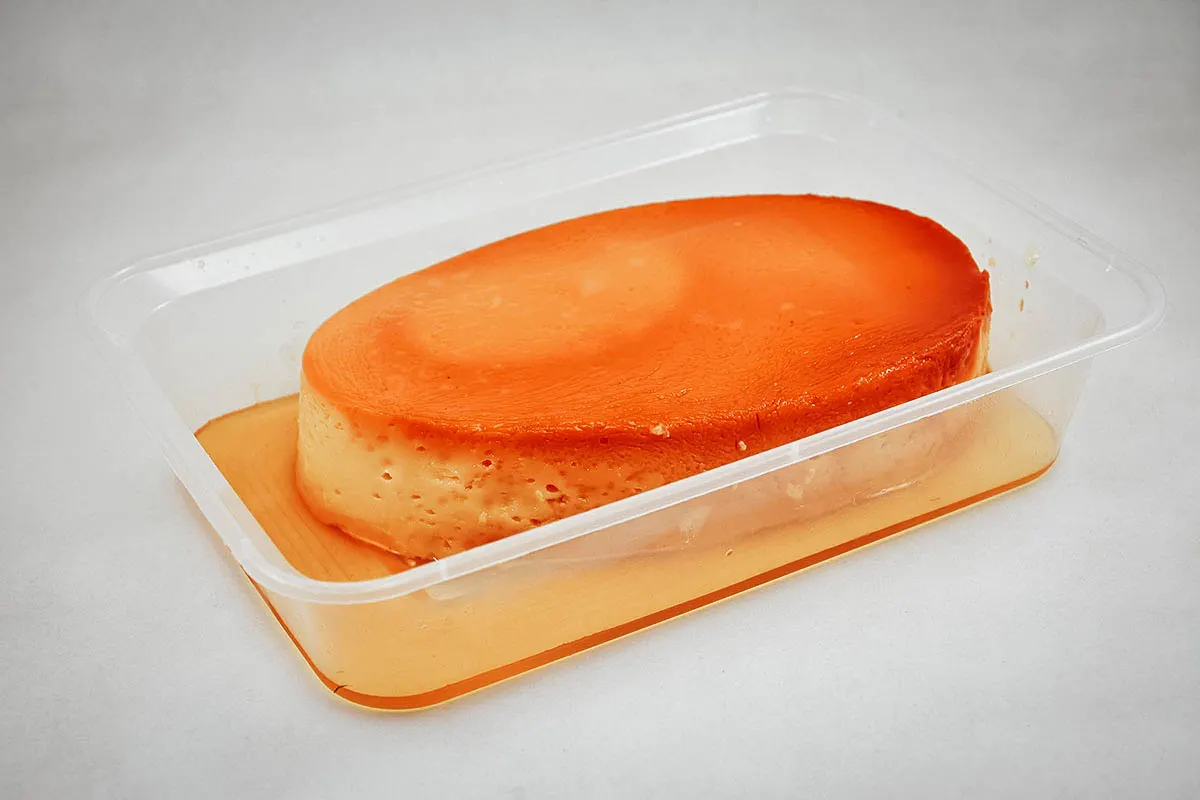
Photo by imwaltersy
44. Turon
Turon is a beloved Filipino snack or dessert made with thin slices of plantain dusted with brown sugar and deep-fried in lumpia wrapper. It’s commonly sold as street food though it’s often prepared at home as well, usually for merienda (mid-day snack).
I never thought of it that way but turon is actually a type of sweet lumpia. Many Filipinos only think of lumpia as savory, but because turon is deep-fried in spring roll wrapper, then it definitely qualifies as a type of lumpia.
RECIPE: Turon
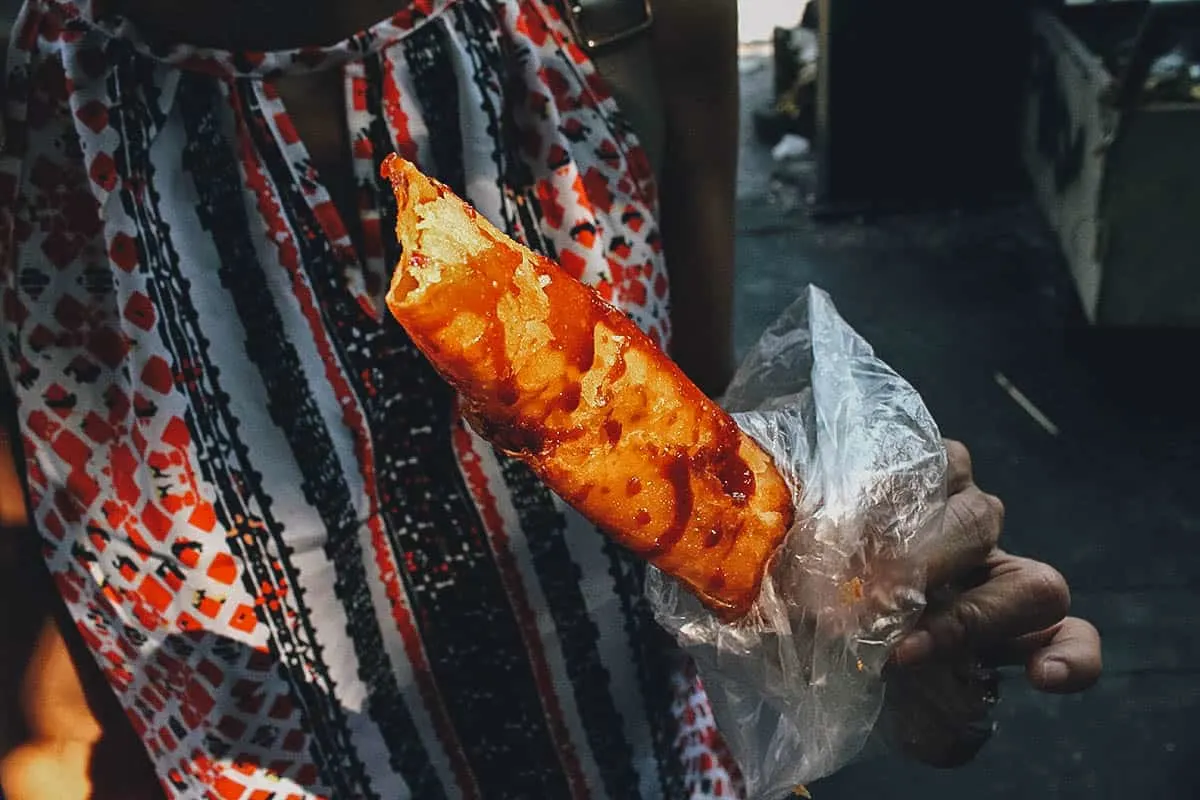
45. Ube
I credit ube for being one of the dishes that brought Filipino food to the mainstream. Thanks to its versatility and rich purple color, it’s become a favorite subject on social media platforms like Instagram.
Ube halaya refers to a jam made from boiled and mashed purple yam. It’s a versatile ingredient that’s been used in many desserts like ice cream, cakes, croissants, cookies, and pies. When we were growing up, there weren’t many ube desserts available so we’d get our fix by scooping ube halaya from a jar and eating it directly from the spoon. It’s still my favorite way of enjoying ube to this day.

If you’ve read through this entire Filipino food guide, then you can probably guess what these are. They’re putong ube or steamed rice cakes made with ube halaya.
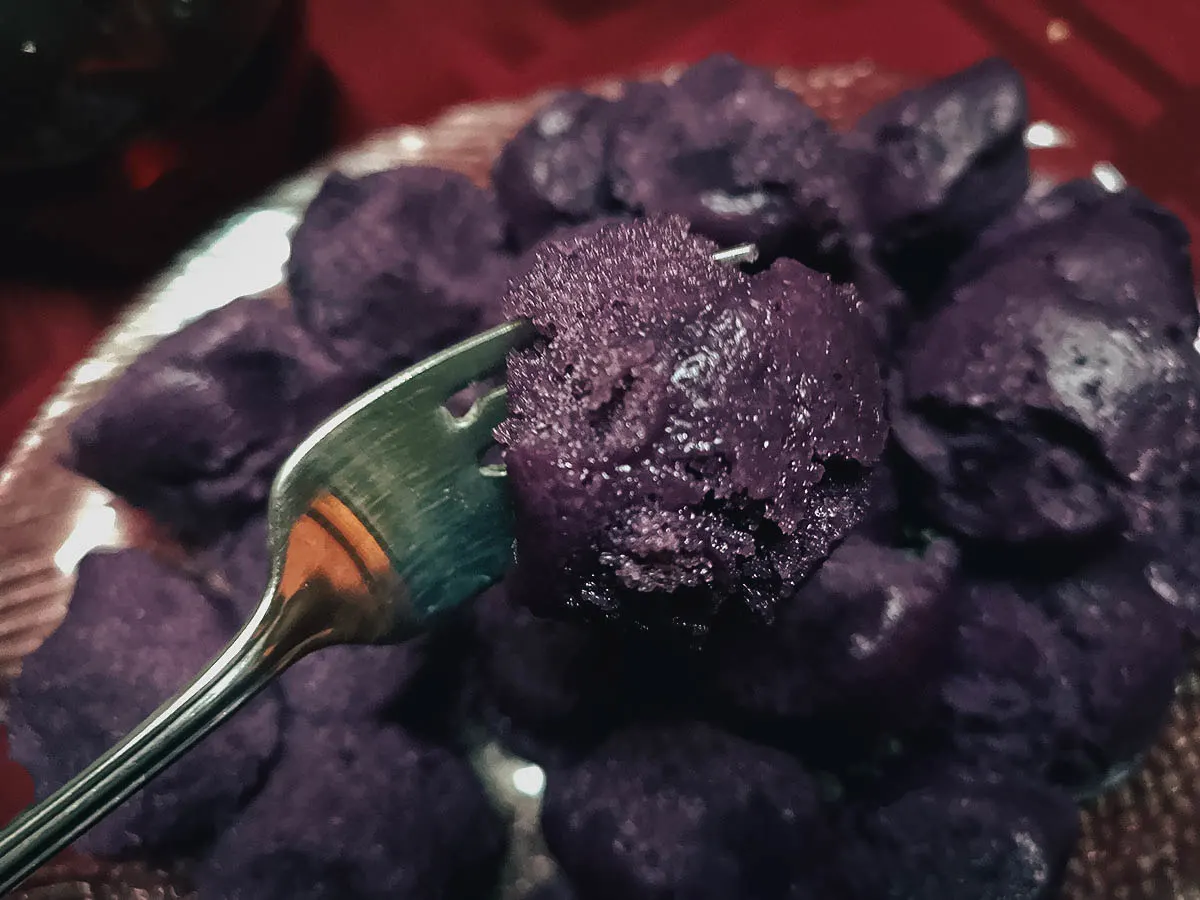
FINAL THOUGHTS ON FILIPINO FOOD
This Filipino food guide was both the easiest and hardest food guide I’ve had to write. It was easy because I grew up eating Filipino food. I know it better than any other cuisine so I put a lot more pressure on myself to write a guide that represented Filipino cuisine well and did it justice.
My goal in writing this Filipino food guide was to help first-time visitors get a balanced and well-rounded food experience in the Philippines. Many non-local articles on Filipino food list only the most well-known (boodle fight, ube) or sensational (balut) Filipino dishes. As a local, I wanted to come up with a guide that not only directed you to some of the best and most interesting food in the Philippines, but to also describe whenever I could what those dishes mean to us culturally.
In any case, I hope I succeeded. If you’re planning a trip to Manila or anywhere else in the country, then I hope this Filipino food guide leads you to some terrific meals in the Philippines. If you have any questions, then let us know in the comments below.
Thanks for reading and have a delicious time in the Philippines!
Cover photo by MikeEdwards. Stock images by Depositphotos.


ELABA
Friday 9th of February 2024
REALLY GOOOD YUMMYYY I LOVE HALO-HALO <3333
Rovy
Friday 15th of September 2023
This food guide is very good! Every word is well thought out. This makes me want to browse your other entries. Great job!
JB & Renée
Saturday 21st of October 2023
Thanks Rovy! Happy you appreciated it.
Alexander Figueroa
Saturday 2nd of September 2023
Arroz Caldo > Lugaw
David Ferrara
Monday 31st of July 2023
What a fantastic and thorough article! The photography is lovely. I'm hungry.
I have stayed in touch with a Filipina woman who is an employee on one of the cruise ships I took to the Caribbean. She estimates that about half of the 1600(!) crew members are from the Philippines. They are the friendliest AND most hard-working people I have ever met. I tipped everyone I met generously; I admire their work ethic and dedication. Despite what most people think, working on a cruise ship is a long, hard slog. Ever work 280 days in a row??
Anyway, I wanted to learn more about the country and its culture, and being a bit of a foodie myself, realized that I've probably never knowingly had any Filipino foods. This is where your article swooped in and took me on a culinary journey! I'm pretty adventurous (brave?) when it comes to trying new foods, so I'd like try everything on the list... except, perhaps, the Balut. Chopped intestines or brains are one thing, but a still-recognizable bird in its shell might be my limit. But, if I had a few drinks in me and was being egged on (pun intended) who knows? ;-)
My friend says she wants to find me a Filipina woman (she thinks I should get married) and based on what I know about southeast Asia in general, I might take her up on it! I could see myself living in that area of the world. But I'm from Minneapolis, Minnesota USA and would have to acclimate to the humidity.
Thank you - your article is still rocking it in 2023!
David
JB & Renée
Wednesday 2nd of August 2023
Thank you for sharing your story and the kind words David! It's nice to hear people acknowledge and appreciate the qualities of Filipinos that other people may take for granted. We really appreciate it! :)
And yes, please do visit the Philippines when you can. Like the many people who've gone for a visit and wound up making it their home, I'm sure you'll love it. Cheers and all the best!
Larra Silva
Friday 10th of March 2023
I honestly didn’t expect Ilonggo batchoy will be here.
JB & Renée
Wednesday 29th of March 2023
Can't leave out our favorite batchoy!